~ LIST OF SHIPS ENCOUNTERED DURING THE VOYAGES ~
1800 to 1832
Every journal contains sightings of other craft, whether in passing, in a convoy, or in or near to a port. There was a good reason for this in that, before the age of telecommunication, it helped to keep note of a ships position on the seas. These sightings were entered in to the daily record in the journal. There is also the occasional mention of Royal Navy ships in the crew lists where crew have been pressed. Sometimes there is just one note of a passing ship, other times, especially in a convoy, the particular vessel is mentioned on a number of occasions.
Encounters Page
We have accumulated these sightings and added them to this page with only the first sighting recorded, unless there is a particular event that is thought worthwhile recording. Therefore it is worthwhile referring back to the transcribed journal. The same ship is often recorded by different ships on different voyages transcribed, as can be noted on the right.
Against each entry there is an indicator as to whether the ship is sailing under the Royal Navy or the HEICS. Other vessels, whether whalers, independent merchantmen or foreign are listed under miscellaneous.
Information about the ships has been gathered from a number of sources, mostly from the Internet, often by referring to Wikipedia. A major site for Royal Navy ships is https://sites.rootsweb.com/~pbtyc/18-1900/C/01156.html. Another site used for HEICS ships is: eicships.threedecks.org, a useful source for 'Country' ships. For pilot boats and ships on the Hooghly River, Calcutta, a wikipedia page dedicated to the Bengal Pilot Service (BPS) is useful. A site specifically dealing with the The main source for HEICS ships and their captains is from Farrington: Catalogue of East India Company's Ships Journals.
As and when another log is transcribed, material will be added to this page.
|
| CONTENTS
A
B
C
D
E
F
G
H
I
J
K
L
M
N
O
P
Q
R
S
T
U
V
W
X
Y
Z
|
| NAME |
RN/HEICS/MISC |
DESCRIPTION |
VOYAGE |
| not known |
misc |
On Friday 28th November 1806, the escort ship Royal Navy Antelope picked up debris from a large ship with evidence of shot. From this it is assumed that a ship had either been sunk or damaged during an engagement. |
Huddart: voyage 1806-1807. |
|
|
| not known |
misc |
An unnamed ship spotted by Captain Bayliff of the Huddart in the Indian Ocean on Sunday 31 May 1807. She was a ship from Bremen sailing from Batavia, presumably back to Bremen.
|
Huddart: voyage 1806-1807. |
|
|
|
A |
| Abnam |
misc |
Abnam of Break Muss[?] Valley was noted in the log of the Georgiana as arriving at St Helena on 16th August 1804.
|
Georgiana: voyage 1803-1807. |
|
|
| Abrama Newland |
misc |
On Saturday 22nd October 1808, while at St Helena, Captain Sanders of the Northampton recorded the presence of the Abrama Newland, a transport ship. The only ship approximate to the name is the Abraham Newland. The website: threedecks.org/index.php?display_type=show_ship&id=15303, records this ship as a 'Privateer' in 1811.
|
Northampton: voyage 1807-1809. |
|
|
| Achilles |
misc |
An English brig noted in the journal of the Bridgewater south of Madras on Friday 9th April 1830. She was from Franquebar in the Indian state of Tamil Nadu and was bound for Mauritius, otherwise nothing known. |
Bridgewater: voyage 1828-1830. |
|
|
| Active |
misc |
A French ship, 104 tons, length 72ft, captured by the Royal Navy in 1803 (a previous French prise also known as Active was reported lost off the coast of Desolation Island in January 1803, owner William Bennett). The same William Bennett purchased this ship in 1804 and again named her Active. Noted in the log of the Georgiana as arriving at St Helena fron England on 24th September 1804. In 1805 she had presumably been whaling in the South Atlantic and joined the homeward-bound convoy at St Helena on 12th July 1805 and was noted in the Journal of the True Briton. In June 1809 she was nearly lost off Australia under her commander Captain John Bader. She then headed for the west coast of New Zealand and on 16th February 1810 landed a sealing party on a small island. She then set sail for Sydney but was never seen again, the sealing party were marooned on the island until 1813. In 1847 a hull was discovered near Bluff Point, Southland, which suggested that she had run ashore, see Wikipedia for her full story.
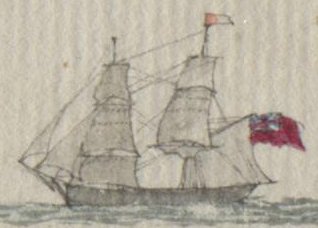
Vignette of the ship Active
from of Journal of the True Briton.
|
Georgiana: voyage 1803-1807; True Briton: voyage 1804-1805. |
|
|
| Adamant |
Royal Navy |
Built by Peter Baker in Liverpool, launched 24th January 1780, fourth rate, 50 guns, length 146ft, 1000 tons. She served in the American War of Independence and the French wars. On 1st March 1806 she was at Portsmouth and the Lady Jane Dundas received instructions from her subsequent to sailing. She acted as escort to the Convoy. Noted in the log of the Georgiana as at Cape Town on the 29th May 1806. She was noted by Captain Farrer of the Cumberland at St Helena on Wednesday 2nd July 1806, departed for St Helena on 7th June 1806 and was the fleet's escort back to England. The log of the Georgiana noted her again returning to St Helena, along with a ship called Columbine, on 2nd September 1806, from the Cape carrying troops for an expedition to Buenas Ayres. She left St Helena for Buenas Ayres on 5th September with the Columbine, Protector, Diadem. She was broken up in 1814. |
Georgiana: voyage 1803-1807; Cumberland: voyage 1805-1806; Lady Jane Dundas: voyage 1805-1807. | ,
|
|
| Admiral Aplin |
HEICS |
Built by Temple at South Shields 1802, length 122ft, 558 tons. Recorded by Captain Barker of the Northampton as at St Helena. She was on her maiden voyage returning from Madras under Captain John Rogers. On her second voyage she was captured by the French near Mauritius on 9th Jan 1804. Noted in the log of the Georgiana as at Gravesend on Thursday 11th August 1803, outbound for India. |
Northampton: voyage 1801-1803; Georgiana: voyage 1803-1807. |
|
|
| Admiral Gardner |
HEICS |
Built by Hill and launched 1797, length 145ft, 816 tons. She made six voyages to the East. Noted in the log of the Georgiana as arriving at St Helena on 12th March 1804. on her return to England. She departed on the 1st April in a convoy. Her commander was Captain Edward Bradford. Noted in the log of the Georgiana as prepairing to sail from St Helena for England on 13th July 1805, her commander was Captain George Saltwell. Still near the Island on 17th July. Noted by Captain Jones of the Ganges, on her fourth voyage, under Captain George Saltwell. She was lost in a storm on the Goodwin Sands on 29th January 1809, value of her cargo was £21,000. See: https://www.wrecksite.eu/wreck.aspx?4791. |
Georgiana: voyage 1803-1807; Ganges: voyage 1805-1807. |
|
|
| Admiral Watson |
HEICS |
Company's own ship, built by Woolcombe, launched Rotherhithe 1757, 430 tons. Four voyage are recorded in Farrington. Noted in the Journal of the Solebay as at Bencoolen on Thursday 20th June 1765 as parting her cable in a squall and bearing away to Pulo Bay along with other Company ships. Her longboat overturned spilling out the people. The Solebay's jolly boat and the Beckenham's boat went to their assistance. Her Commander was Captain John Blewitt. Her last recorded voyage was to Bengal in 1768. |
Solebay: voyage 1764-1765. |
|
|
| Adventure |
misc |
An American ship noted in the log of the Georgiana as arriving at St Helena from Calcutta on 21st December 1805. |
Georgiana: voyage 1803-1807. |
|
|
| Adventurer |
misc |
A whaler from the Coast of Peru noted in the log of the Georgiana as arriving at St Helena 11th January 1806. |
Georgiana: voyage 1803-1807. |
|
|
| Africa |
Royal Navy |
Built by Barnard at Deptford, launched 11th April 1781, as a 64 gun 3rd rate ship of the line, length 159ft 1385 tons. She was noted by Captain Lindsay of the Lady Jane Dundas at Portsmouth on the 4th March 1806. Later in the year she was present at the Battle of Trafalgar under Captain Henry Digby. See https://en.wikipedia.org/wiki/HMS_Africa_(1781)for her history. She was broken up at Portsmouth in May 1814.
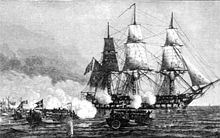
Royal Navy Africa being attacked by Danish gunboats.
|
Lady Jane Dundas: voyage 1805-1807. |
|
|
| African |
misc |
This is an assumed whaler named African, she was noted in the log of the Georgiana as departing St Helena in convoy on 1st April 1804. However two African whalers were noted as arriving on the 19th March 1804, so the reference may be to African unnamed whaler or whalers. However, the logs state that on 24th July 1805 a South Seaman called African arrived at St Helena. |
Georgiana: voyage 1803-1807. |
|
|
| Africaine |
Royal Navy |
The L'Africaine, was a Preneuse-class French frigate built by Raymond-Antoine Haran in 1798, was captured by HMS Phoebe as the on 19th Feb 1801, 5th rate, armament 38, complement 295, 1085 tons. On Wednesday 9th March 1803, Commanded by Captain Manby, the Africaine pressed 26 seamen from the Wexford. At the time she was trying to depart with HMS Minerva for Longreach. On 28th Aug 1816 she was lying at Deptford and offered for sale. See https://sites.rootsweb.com/~pbtyc/18-1900/C/01156.html & https://en.wikipedia.org/wiki/French_frigate_Africaine_(1798) for further details. |
Wexford: voyage 1803-1804. |
|
|
| Airly Castle |
HEICS |
Built by Barnard 1787, length 143ft, 813 tons. There are eight recorded trips to India. Noted in the log of the Georgiana as arriving at St Helena from Madras on 3rd December 1805. She left St Helena on 13th April 1806. On her last in 1807, under Captain William Burgess, she was noted by Captain Sanders of the Northampton. She was used as a transport ship in 1809 and broken up in 1810, see the website: eicships.threedecks.org. |
Georgiana: voyage 1803-1807; Northampton: voyage 1807-1809. |
|
|
| Albatross |
Royal Navy |
A brig launched 1795 with armament of 18. She had captured the La Gloira in 1801. On Saturday 22nd November 1806 Captain Jones of the Earl St Vincent recorded that she arrived at Madras with two French prizes La Gloira and Henrietta. See: https://sites.rootsweb.com/~pbtyc/18-1900/C/01156.html and en.wikipedia.org/wiki/Gloire_(1799_ship), for further details. Reported by Captain Barker of the Northampton as in the Bay of Bengal in October 1802. Disposed of in 1807. |
Northampton: voyage 1801-1803. Earl St Vincent: voyage 1806-1807 |
|
|
| Albecore hoy |
HEICS |
A hoy recorded in the journal of the True Briton at Blackwall on Monday 13th February 1804. |
True Briton: voyage 1804-1805. |
|
|
| Albion lighter |
HEICS |
A lighter belonging to the Company mentioned by Captain Farrer of the Cumberland while disembarking cargo at Long Reach on Thursday 11th September 1806. |
Cumberland: voyage 1805-1806. |
|
|
| Albion |
Royal Navy |
Launched 1802, 3rd rate, armament 74, 1743 tons. On 28th February 1804 recorded by the Wexford near to Penang, her Commander was Captain Ferrier, mentioned in the ship's log on the 6th March. Noted in the log of the Georgiana as arriving at St Helena on 9th June 1804, escorting a large fleet of merchant ships from the Far East. Noted in the same log as departing St Helena for China on 3rd July 1804. On Thursday 3rd October 1805 she left Penang with a fleet commanded by Sir Edward Pellew. See: https://sites.rootsweb.com/~pbtyc/18-1900/C/01156.html, for her history. She had arrived at Bombay on the 9th September. On Wednesday 22nd October 1806 HMS Albion left Bombay on a Cruise. She pressed a number of the Earl St Vincent's crew on 13th November 1806. She is mentioned in the crew list of the Lady Jane Dundas when a John Drake was taken on board as an invalid on 18th on March 1807 while at Point di Galle from HM Albion by order of Captain Cramer of HM ship Concorde. See: https://sites.rootsweb.com/~pbtyc/18-1900/C/01156.html, for her history. She was disposed of in 1836. |
Wexford: voyage 1802-1803; Georgiana: voyage 1803-1807; Cumberland: voyage 1805-1806; Lady Jane Dundas: voyage 1805-1807; Earl St Vincent: voyage 1806-1807. |
|
|
| Albion |
misc |
A whaler noted in the log of the Georgiana as sailing from St Helena to England on 24th December 1804. In getting under weigh she fell athwart the Georgiana's hawser & carried away our bowsprit cap. She may be the same ship noted in the same log as a whaler arriving at Cape Town from England on 9th June 1806 on 2nd July she sailed for Botany Bay. |
Georgiana: voyage 1803-1807. |
|
|
| Albion |
HEICS |
Steam boat mentioned as towing the Bridgewater at Northfleet on 7th December 1828. Noted by Captain Dalrymple of the Vansittart 1826-8, and again by Captain Gribble who described her as a Thames steam vessel acting as a tug for the Repulse on 22nd March 1832. |
Vansittart: voyage 1826-1828; Bridgewater: voyage 1828-1830; Repulse: voyage 1831-1832. |
|
|
| Albion |
HEICS |
According to the Australian website: www.convictrecords.com.au, the Albion was at Van Diemen's Land on the 17th January 1824. By the 15th February she was crossing the Indian Ocean when spotted by Captain Rawes of the Warren Hastings on Sunday 15th February 1824. She is possibly the Albion (4) listed by Farrington as a chartered ship with a crew of 35/44 and weighing 470 tons. She was chartered by the HEICS on 1802/1 to Madras & Bengal, and 1824/5 to Bengal. This leaves a space for the Albion being in the Indian Ocean on private business. The website: eicships.threedecks.org, gives detail of a ship called the Albion as being built in Bristol in 1813. |
Warren Hastings: voyage 1823-1824. |
|
|
| Alexander |
misc |
Noted in the log of the Georgiana as arriving at St Helena from Port Jackson, Australia on 19th February 1806. |
Georgiana: voyage 1803-1807. |
|
|
| Alexander (3) |
HEICS |
An 'Extra' ship built at Liverpool 1804, length 128ft, 614 tons. Seven voyages are recorded. Noted in the Journal of the True Briton as leaving with the Convoy at St Helena on 12th July 1805 on her return voyage back to England. Noted on her second by Captain Rawes of the Juliana, under Captain John Robinson Franklin. Captain Franklin was an American by birth and spent his first five years on the high seas in the American trade. She was part of the Convoy but had headed for Bengal. On 14th October 1806 she arrived at Bombay from Bengal. She was also noted on 26th February 1807 by Captain Lindsay of the Lady Jane Dundas as leaving in convoy from Saugor to Point de Galle. On Sunday 15th October 1812 Captain Harington of the Ganges records her as arriving at Point de Galle from Bengal. On Tuesday 1st 1813 she was noted by Captain Rawes of the Juliana, under Charles Hazell Newell on her 5th voyage as arriving at Bencoolan. The Alexander was sold in 1817 as a hulk.
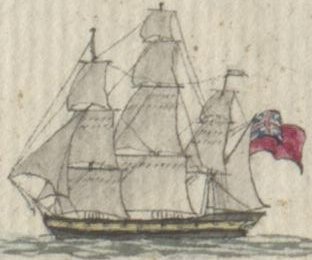
Vignette of the ship Alexander
|
True Briton: voyage 1804-1805; Ganges: voyage 1805-1807; Lady Jane Dundas: voyage 1805-1807; Earl St Vincent: voyage 1806-1807; Huddart: voyage 1806-1807; Juliana: voyage 1812-1813. |
|
|
| Alfred (2) |
HEICS |
Built by Todd & Pitcher, launched 1790. Length 165ft, 1221 tons. This was her sixth voyage to the Far East. Her commander was Captain James Farquharson when recorded in the journal of the Wexford as at Whampoa on 3rd December 1803. On 13th June 1807 she was noted by Captain Lindsay of the Lady Jane Dundas and on the 14th June 1807 she was noted at St Helena by Captain Bayliff of the Huddart when he described her as a store ship. Her commander was Captain George Welstead. She was also described as a store ship at St Helena by Captain Jones of the Earl St Vincent. Her last recorded voyage was her 8th in 1809. |
Wexford: voyage 1803-1804; Lady Jane Dundas: voyage 1805-1807; Huddart: voyage 1806-1807; Earl St Vincent: voyage 1806-1807. |
|
|
| Alligator |
HEICS |
Sailed with the convoy until parting company for Cape Town on Monday November 30th 1807. According to eicships.threedecks.org/, she was launched 23rd Sep 1793 at Northfleet for Curling and Company. Farrington records that she was an Extra ship, built by Cox in 1798, maybe she was repaired by Cox. Her length 102ft and she weighed 345 tons. Only one voyage is listed by Farrington: 1798/1800 to Madras & Bengal under Captain Robert Curling. She was wrecked on 13 May 1820 two miles below L'Islet, River, St. Lawrence, Canada. |
Northampton: voyage 1807-1809. |
|
|
| Alnwick Castle |
HEICS |
Built 1801, 165ft long, 1256 tons. Sailed to China at least 7 times. Noted in the journal of the True Briton as arriving at Spithead from the Downs on Sunday 20th May 1804, under Captain Albert Gledstanes. Noted by Captain Lindsay of the Lady Jane Dundas at Portsmouth on 4th March 1806 as part of the outward bound convoy, under her commander Captain Charles Elton Prescott. Noted by Captain Rawes of the Warren Hastings on her last recorded voyage under Captain Peter Rolland.
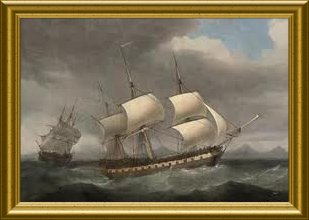
The Alnwick Castle
|
True Briton: voyage 1804-1805; Lady Jane Dundas: voyage 1805-1807; Warren Hastings: voyage 1815-1816. |
|
|
| Amelia |
Royal Navy |
Launched in 1785 as the Proserpine, a 38 gun Hebe-class frigate of the French Navy. She was captured by HMS Dryad on 13th June 1796. She was recorded as in the Downs Anchorage on Friday 25th March 1803 when she pressed two crew of the Company ship Wexford. The Amelia was broken up in 1816. See https://sites.rootsweb.com/~pbtyc/18-1900/C/01156.html for her history. |
Wexford: voyage 1803-1804. |
|
|
| America |
misc |
A ship noted in the log of the Georgiana that departed for St Helena for America on 18th May 1804.
|
Georgiana: voyage 1803-1807. |
|
|
| America |
Royal Navy |
Launched at Blackwall Yard 21st April 1810 as a 3rd rate, length 176ft, 1758 tons, armament 74. She is mentioned in a letter dated 28th June 1811 in the Absence Book of the Ganges, a William Robertson was serving on her. She was broken up in 1867.
|
Ganges: voyage 1805-1807. |
|
|
| Ancora |
misc |
A whaler noted in the log of the Georgiana as arriving at St Helena on Sunday 22nd January 1804. No more information. |
Georgiana: voyage 1803-1807. |
|
|
| Andromache |
---- |
This ship has not been identified, there is an HMS Andromache, but she was apparently broken up in 1828. Our ship was noted in the journal of the Bridgewater as at Saugor on Sunday 3rd May 1829. |
Bridgewater: voyage 1828-1830. |
|
|
| Anjango lighter |
HEICS |
A lighter noted in the Journal as coming alongside the True Briton at Blackwall on Wednesday 6th November 1805. The name originates from an old Portuguese settlement, Anjengo, now known as Anchuthengu, situated at the mouth of the Parvathy Canal, in South west India. In 1694 the East India Company was granted the right to establish a factory. |
True Briton: voyage 1804-1805. |
|
|
| Ann (1) |
HEICS |
Extra ship built by Randall at Rotherhithe 1801. Length 128ft, 508 tons. Eight voyages to India. Noted by Captain Barker of the Northampton on 24th August 1801 as at Dungeness. Her commander was Captain Alexander Sinclair. Noted in the log of the Georgiana as arriving at St Helena from Bombay on 4th November 1804. Her commander was Captain Thomas Price. She was still there on 17th November 1804 and sailed for England on 7th December 1804. Noted on 7th August 1805 in convoy towards Madras by the Ganges, her Commander was Captain James Masson. Noted again in the log of the Georgiana as arriving at the Cape 0n 30th December 1806. On 2nd February 1807 she was noted in the log of the Georgiana as leaving St Helena in convoy for England. Noted on 4th September 1807 at Madeira by Captain Sanders of the Northampton, commanded by Captain James Masson. Noted on 18th June 1811 by Captain Campbell of the Lord Keith as at St Helena, commanded by Captain Peter Cameron. Her last recorded voyage was in 1815. She was sold in 1817 for breaking. See: eicships.threedecks.org/, for more information.
|
Northampton: voyage 1801-1803; Georgiana: voyage 1803-1807; Ganges: voyage 1805-1807; Northampton: voyage 1807-1809; Lord Keith: voyage 1810-1811. |
|
|
| Ann |
misc |
Described as Ann of Baltimore, she was noted in the log of the Georgiana on Tuesday 17th January 1804 as arriving at St Helena. The assumption is that she was American but at present nothing more can be found on her. |
Georgiana: voyage 1803-1807. |
|
|
| Ann & Amelia |
HEICS |
See under Lady Amelia.
|
Repulse: voyage 1831-1832. |
|
|
| Anna |
HEICS |
There may be two ships named Anna here.
A ship named Anna was noted in the log of the Georgiana as arriving at St Helena from Bengal on 29th September 1804. The same log mentions on 4th October a Bengal Anna as stationed at St Helena, presonably the same ship. The same log again mentions the Anna as sailing for England and describes her as a 'country ship'.
A ship named Anna described as a Country ship by Captain Jones on Wednesday 22nd October 1806 as leaving Bombay for China. She is possibly one of two Country ships recorded by Farrington: 1/ Anna (2) with two recorded voyages between Bengal and England; 2/ Anna (3) built Bombay 1790, with two recorded voyages between India, China 1798 and 1801. see Threedecks.org. |
Georgiana: voyage 1803-1807; Earl St Vincent: voyage 1806-1807. |
|
|
| Antelope |
misc |
A brig reported by Captain Barker of the Northampton as a Company ship arriving at Calcutta on Saturday 12th June 1802.
|
Northampton: voyage 1807-1809. |
|
|
| Antelope |
Royal Navy |
Launched at the King's Yard, Sheerness 10 Nov 1802, 4th rate, armament 50, 1107 tons. In 1805 H Beazeley was appointed Captain of the Antelope. Noted in the log of the Georgiana as arriving at St Helena, as escort on 27th August 1806. She sailed as an escort of a convoy for England on 7th September 1806. On 15th June 1807 she was noted as arriving at St Helena from the Cape of Good Hope at St Helena by Captain Lindsay of the Lady Jane Dundas. She was noted as moored at St Helena Roads on Tuesday 16th June 1807. She was mentioned in the Absence Book of the Ganges as at Portsmouth the 29 October 1807. For her history see: https://sites.rootsweb.com/~pbtyc/18-1900/C/01156.html. She was converted into a prison ship at Bermuda in 1824 and deposed of in 1845. |
Georgiana: voyage 1803-1807; Earl St Vincent: voyage 1806-1807; Ganges: voyage 1805-1807; Lady Jane Dundas: voyage 1805-1807; Huddart: voyage 1806-1807. |
|
|
| Apollo |
misc |
A brig at Scanto (Santo), possibly a Portuguese ship noted in the log of the Georgiana on Monday 30th January as arriving at St Helena. Nothing more is known of her. |
Georgiana: voyage 1803-1807. |
|
|
| Apollo (1) |
HEICS |
A 'Country' ship built prior to 1800 when she sailed from Madras under Captain Benjamin Brown. Captain Rawes of the Warren Hastings made note of her on Saturday August 12th 1815. He was sailing near to Trowers Island in the Java Sea "when the crew noticed a wreck a small distance from the beach and on our nearer approach at 10am could most distinctly see she was a small ship with her Main & Mizen Mast & bowsprit standing & from the freshness of her paint & other circumstances imagine she cannot have been long on shore. We prepared our boats & kept a careful look out for any People that might be on shore or on board - but on getting abreast of the wreck perceived the sea making a clear breach over her & did not discover the least signs of any person being on shore. In consequence of which & from the great risque our own Boat would [----]unter we gave up the idea of discovering what she was. The Cornwallis who we fell in with us, informed us the wreck was the Apollo Country Ship - crew saved". |
Warren Hastings: voyage 1815-1816. |
|
|
| Apollo (2) |
HEICS |
Built 1812, 127ft long, 652 tons. Went to China at least 3 times. Noted by Captain Rawes of the Warren Hastings on her second voyage, under Captain Charles Bryan Tarbutt. Her last recorded voyage was 1819/20.
|
Warren Hastings: voyage 1815-1816. |
|
|
| Arcturus |
HEICS |
A barque from Whitby bound to Hull from Mauritius recorded by Captain Dalrymple of the Vansittart on Monday 17th March 1828. |
Vansittart: voyage 1826-1828. |
|
|
| Ariadne |
Royal Navy |
There are two possibilities here.
1: Launched at Cowes in 1803 as a civilian vessel and purchased by the Royal Navy in July 1805. Armament 16 guns. She was renamed later in the year as the Dove and again in 1806 as the Flight. She disappeared in the English Channel in September 1806.
2: Launched Chatham 1776, rebuilt 1792, 432 tons, 6th rate, armament 24. In August 1804 Captain King was appointed her commander. On 23rd July 1805 she was involved in attacks on convoys off Calais, Vimereux and Ambleteuse. She was still active in 1811.
The registers of the True Briton record that while near Dungerness at 3AM in the morning on 9th September 1805, Lieut Lewis came on board and pressed 32 [in the crew list 35 are listed] of the crew. This was unfortunate for the individuals involved as they had already been at sea for over a year and expecting to land shortly. |
True Briton: voyage 1804-1805. |
|
|
| Arniston |
HEICS |
Built by Barnard, launched 1794. length 176ft, 1200 tons. She was also a heavily armed ship with 58 guns. Noted in the journal of the True Briton as sailing with the convoy from the Motherbank on Saturday 9th June 1804, her commander was Captain James Jameson. On 17th October 1806 she was noted by Captain Lindsay of the Lady Jane Dundas as at Penang. This was her sixth voyage, under Captain Peter Wedderburn, out of eight recorded. She was wrecked with the loss of 378 souls on 30th May 1813 near Cape Lagullas, South Africa while chartered as a British Government transport. There were only six survivors, among the victims were the Captain George Simpson, Lieutenant Brice and Lord and Lady Molesworth. See Asiatic Journal 2 (1816) PP.32-34. See also https://en.wikipedia.org/wiki/Arniston_(East_Indiaman).
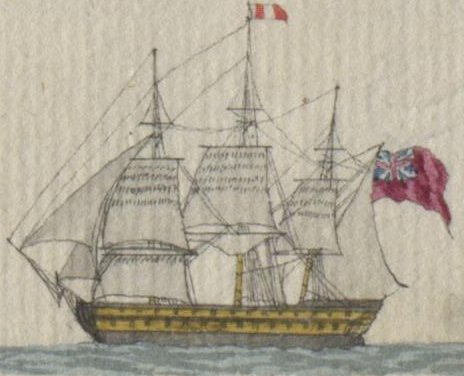
Vignette of the ship Arniston
|
True Briton: voyage 1804-1805; Lady Jane Dundas: voyage 1805-1807. |
|
|
| Arrogant |
Royal Navy |
Launched at Harwich 1761, 3rd rate, armament 74, length 164ft, 1644 tons, complement 584. In 1804 she was converted to a hulk at Bombay where she served as a receiving ship. Captain Harington of the Ganges noted HMS Arrogant at Bombay on Friday 12th September 1906. Mentioned in the Crew List as impressing a number of the crew on 11th January 1807 at Bombay, although the event is not mentioned by Captain Bayliff of the Huddart on the same day. In 1810 she was condemned as unfit for service and sold. See https://sites.rootsweb.com/~pbtyc/18-1900/C/01156.html and https://en.wikipedia.org/wiki/HMS_Arrogant_(1761) for her history. |
Ganges: voyage 1805-1807; Huddart: voyage 1806-1807. |
|
|
| Asia (4) |
HEICS |
Built by Humble at Liverpool, launched 1798, length 146ft, 819 tons. Noted in the journal of the True Briton as sailing from the Motherbank on Tuesday 8th May 1804, under Captain Henry Pendares Tremenheere. Noted by the Ganges and by the Huddart, she made five voyages to the east, Her commander was on her fourth was Captain Robert Wardlaw when Captain Harington of the Ganges records her as arriving at Point de Galle, Ceylon from Madras on Tuesday 17th March 1807. Her last and fifth recorded trip was in 1808 when she was lost on a sandbank on the Hooghly River 1 June 1809.
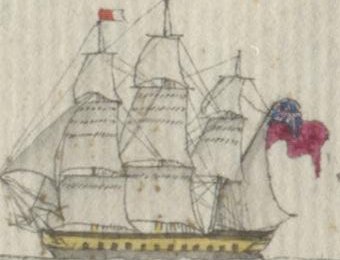
Vignette of the ship Asia
|
True Briton: voyage 1804-1805; Ganges: voyage 1805-1807; Huddart: voyage 1806-1807; Earl St Vincent: voyage 1806-1807. |
|
|
| Asseerghur |
HEICS |
Brig recorded in the journal of the Bridgewater at Saugor on 15th Apr 1830 and the following days. This is very likely to be the same brig as the following Assenghan. |
Bridgewater: voyage 1828-1830. |
|
|
| Assenghan |
HEICS |
Brig recorded by Captain Dalrymple of the Vansittart on Monday 4th June 1827 at Saugor, India. |
Vansittart: voyage 1826-1828. |
|
|
| Astell |
HEICS |
Built by Mestaer at the King and Queen Dock, Rotherhithe, launched 1809, length 147ft, 820 tons. Ten voyages are recorded. Her maiden voyage was to Bengal, her commander was Captain Robert Hay. While at St Helena, she is described as a Royal Navy ship and claiming a member of the Lord Keith's crew, but this appears to be a mistake by Captain Campbell. On 11th March 1811 she is noted at Saugor. She was also noted at Whampoa on 15th November 1827 by the Vansittart on her 9th, commanded by Captain John Levy. Her last voyage to the Far East was in 1830. She was dismantled in 1837. |
Lord Keith: voyage 1810-1811; Vansittart: voyage 1826-1828. |
|
|
| Astraea |
Royal Navy |
Launched in 1810, 5th rate; armament 36; 954 tons. In 1811, she was in the Indian Ocean capturing ships Renommée & Neriede. Both ships were added to the Navy List as the Java and the Madagascar. Captain Rawes of the Juliana recorded her as arriving at St Helena on 26th May 1813 along with HMS Niemen Disposed of on 24th April 1851 described as the "breaking of the Astraea", late storeship at Falmouth. See: https://sites.rootsweb.com/~pbtyc/18-1900/C/01156.html. |
Juliana: voyage 1812-1813. |
|
|
| Atheniene/Athenienne |
Royal Navy |
Taken from the French at Malta 5th Sep 1800, 3rd rate, armament 64. Noted in the journal of the True Briton as escorting the East Indiamen fleet on its return journey from China, her commander was Francis Fayerman. Noted in the log of the Georgiana as ariving at St Helena on 30th June 1805 and was joined by Vice-Admiral Rainier on HMS Trident, for the final leg. She was wrecked on the Esquergues rocks off the coast of Tunis with the loss of captain Robert Rayneford and 396 of her crew in 1806.
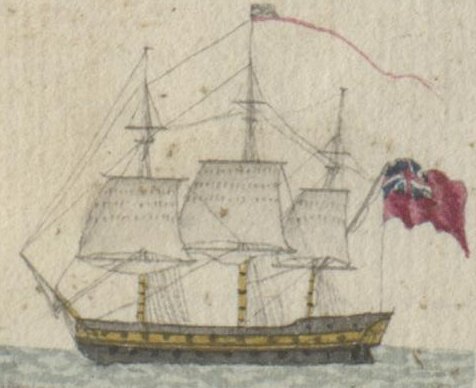
Vignette of the ship Atheniene
|
True Briton: voyage 1804-1805; Georgiana: voyage 1803-1807. |
|
|
| Atlantic |
misc |
A whaler noted by Captain Jones of the Ganges on Saturday 20th June 1807 as setting sail under convoy from St Helena for England and also by Captain Lindsay of the Lady Jane Dundas on 27th June 1807, otherwise not traced. |
Earl St Vincent: voyage 1806-1807; Lady Jane Dundas: voyage 1805-1807. |
|
|
| Atlas (4) |
HEICS |
Built by Steemason at Paull near Hull, launched in 1812. 165ft long, 1267 tons. At least nine voyages to China, Her 2nd & 6th voyage, under Captain Charles Otway Mayne. Noted by Captain Rawes of the Warren Hastings at Whampoa on 30th October 1815 and again on 9th July 1825 at Blackwall. Noted in the journal of the Bridgewater at Whampoa on Monday 18th January 1930. She came across the Bridgewater again on Saturday 3rd April 1830 and chaperoned the stricken Bridgewater as she slowly made her way to Madras. This was her last voyage after which she was sold for scrap for £6,600.
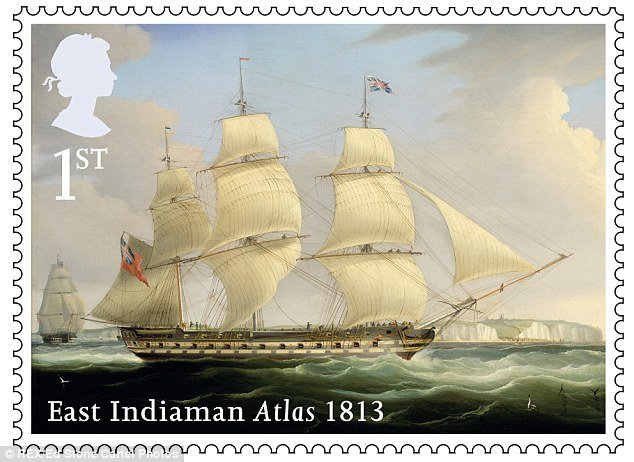
A new stamp by Royal Mail
taken from The Daily Mail 16th January 2016.
|
Warren Hastings: voyage 1815-1816; Warren Hastings: voyage 1823-1824; Bridgewater: voyage 1828-1830. |
|
|
| Atlas |
misc |
A ship recorded by Captain Dalrymple of the Vansittart on Sunday 20th May 1827 in the Indian Ocean as from Madras bound for London. (FT) is recorded after the name Atlas, suggesting a Frigate. See: en.wikipedia.org/wiki/Atlas_(ship), for possibilities. |
Vansittart: voyage 1826-1828. |
|
|
| Atras |
HEICS |
A pilot brig noted by Captain Gribble of the Repulse at Saugor on Saturday 4th June 1831. |
Repulse: voyage 1831-1832. |
|
|
| Augusta |
misc |
A brig from Salem, Mass. in America noted in the log of the Georgiana on 31st January 1804 as arriving at St Helena. She sailed on Friday 2nd March. She arrived again at St Helena on Tuesday 15th 1804 from the Cape of Good Hope, although spelt 'Auguster', it is assumed we have the same ship here. The logs of this ship appear to survive and details are to be found on the site www.worldcat.org. The site details this particular voyage: 'from Salem, Mass., to Saint Helena, Ascension Island, the Cape of Good Hope, and Maio and Sao Tiago Islands, Cape Verde, Nov. 1803 - Aug. 1804. The brig's home port was Salem; the owners were John Collins, John Osgood, and Abijah Northey; the master and logbook keeper was Abijah Northey Jr'. |
Georgiana: voyage 1803-1807. |
|
|
| Aurora |
misc |
A whaler noted in the logs of the Georgiana as arriving at St Helena on Monday 13th Feb. 1804. She departed on 26th Feb., The log of the Georgiana noted two ships named Aurora departing St Helena on the same day, one a French prize, the other a whaler. The log again mentions the Aurora whaler as arriving at St Helena on 4th February 1806. |
Georgiana: voyage 1803-1807. |
|
|
| Aurora |
HEICS |
A French brig captured on 27th August 1803 by the Company ship General Stuart. She was noted in the Log of the Georgiana as arriving at St Helena on Sunday 27th November 1803. She departed on 26th Feb. The log also records on 9th of March 1804 that: the Aurora south seaman arrived - is this the same brig? |
Georgiana: voyage 1803-1807. |
|
|
| Aurocoer[?] |
HEICS |
A company Cruizer, nothing known. |
Juliana: voyage 1812-1813. |
|
|
| Auspicious |
HEICS |
According to Farrington she was an 'extra' ship built by Cox, launched 1797, length 106ft, 404 tons with one recorded voyage to Bengal in 1803 under Captain John Baker. On the website: eicships.threedecks.org/, she was built 1797 by W. J. Bottomley at King's Lynn, length 106ft, 404 tons. Taken up for Company service in 1797, 18th July 1798 almost totally destroyed by fire at Calcutta only to be completely rebuilt and returned with a cargo. From 1812 she remained in India as a Country ship.
|
Lord Keith: voyage 1810-1811. |
|
|
| Ave Prinsdan |
misc |
A Danish ship noted in the log of the Georgiana as arriving at St Helena from China on 30th March 1806. She sailed from St Helena on the 8th April. |
Georgiana: voyage 1803-1807. |
|
|
| B |
| Baring |
HEICS |
Built by Barnard, launched 1801, length 146ft, 820 tons three decker. Six voyages to India are recorded. Noted in the log of the Georgiana as arriving at St Helena on 3rd December 1805. On board was Frederick North, Earl of Guilford, the Governor of Ceylon who received a 19-gun salute upon entry to port. On 10th January 1806 while still at St Helena a passenger Mr Fullerton an officer of the 11th Light Dragoons was killed by a shark while swimming. On her third, under Captain James Carnegie. On Thursday 21st May 1807 on the return voyage near to South Africa, Captain Jones recorded that he had spoken to a passing Indiaman called Baring. This was her outward bound trip and she was also noted on the same day by Captain Lindsay of the Lady Jane Dundas She was sold in 1814 and became a convict ship to Australia. The last note of her was in New South Wales in 1824. |
Georgiana: voyage 1803-1807; Lady Jane Dundas: voyage 1805-1807; Earl St Vincent: voyage 1806-1807. |
|
|
| Baring hoy |
HEICS |
A hoy recorded in the journal of the True Briton at Blackwall on Monday 5th March 1804. |
True Briton: voyage 1804-1805. |
|
|
| Barracouta |
Royal Navy |
Launched in 1807, a sloop. Arrived at Batavia on 12th December 1812. See: https://sites.rootsweb.com/~pbtyc/18-1900/C/01156.html. Disposed of in 1815. |
Juliana: voyage 1812-1813. |
|
|
| Barrosa |
HEICS |
A chartered ship, built by Cossipore, 968 tons. Commanded by Captain Benjamin Fergussan. Noted by Captain Rawes of the Juliana as on a voyage from Bombay. Her last recorded voyage by Farrington was to Quebec in 1833. She was probably named after the Battle of Barrosa, at Cadiz in 1811. On 30th Aug 1841, she set off from Sheerness with convicts bound for Australia. The Barrosa was lost at sea in 1847, see Google Books. See also: eicships.threedecks.org/. |
Juliana: voyage 1812-1813. |
|
|
| Batavia |
HEICS |
Extra ship built by Topsham, 12ft, 555 tons. On her maiden voyage from Portsmouth to India under Captain John Mayne, she noted by on 24th June 1810by Captain Campbell of the Lord Keith who wrote that it was on tow by the Commodore while on route south towards Madeira. On Thursday 26th July Captain Campbell wrote the following: At 4pm observed the Batavia had carried away her main Top Gallant mast which kept us under very easy sail throughout this Day. On the 23rd October the Batavia parted from the convoy on her way to Ceylon. Last recorded voyage in Farrington is 1815/6, under Captain Mayne. |
Lord Keith: voyage 1810-1811. |
|
|
| Beckenham |
HEICS |
350 tons. Noted in the Journal of the Solebay Friday 2nd November 1764 as in St Augustines Bay, Madagascar, her commander was Captain Newton Mallack. She was sailing from England via Rio Janeiro to Benkulen and arrived at Batavia on 14th April 1765. She remained in the East Indies. This was her only voyage under the HEICS. |
Solebay: voyage 1764-1765. |
|
|
| Belle |
HEICS |
A brig noted in the log of the Georgiana as arriving at St Helena from Bengal with dispatches on 6th March 1804. She filled up with a supply of water and left the following day for England. She may be the same brig merchant and packet ship noted in Farrington and on the Internet as being built in Calcutta 1802 weighing 281 tons and recorded as making one voyage in 1804-5 from Calcutta to England and being captured by the French in 1805 but the dates don't appear to add up as according to Farrington she was in Calcutta in November 1804 sailing for England. Another possibility is that she did not sail for England after leaving St Helena but sailed back to Calcutta. |
Georgiana: voyage 1803-1807. |
|
|
| Bellona |
HEICS |
Probably the 'extra' ship built at Woolcombe, measured 1795, length 113ft, 456 tons. She is recorded by Farrington as making four voyages to the Far East. Noted in the log of the Georgiana as a 'cartel ship' departing from St Helena with General Janssen, leader of the Dutch forces in the Cape Colony, on board for Holland on 24th March 1806. She had probably arrived at St Helena on the 20th March from the Cape. |
Lady Jane Dundas: voyage 1803-1807. |
|
|
| Bellone |
Royal Navy |
A 5th rate frigate called Bellone, captured from the French on 12 Oct 1798, see: https://sites.rootsweb.com/~pbtyc/18-1900/C/01156.html. Styled as 5th rate with armament of 36. She arrived at Bombay on Tuesday 14th October 1806 and again on 28th December 1806. Noted on 15th March 1807 by Captain Lindsay of the Lady Jane Dundas as at Point de Galle. |
Lady Jane Dundas: voyage 1805-1807; Earl St Vincent: voyage 1806-1807; Huddart: voyage 1806-1807. |
|
|
| Benares |
HEICS |
A cruiser, not recorded by Farrington. Noted by Captain Rawes of the Warren Hastings near Sumatra on 15th August 1815, along with HMS Leda. |
Warren Hastings: voyage 1815-1816. |
|
|
| Bengal hoy |
HEICS |
A hoy at Gravesend. Noted as coming alongside the Wexford with cargo on Monday 14th February 1803. |
Wexford: voyage 1803-1804. |
|
|
| Bengal (2) |
HEICS |
A cruiser built by Wells, launched 1799, length 146ft, 818 tons. Noted in the journal of the True Briton as arriving off the Isle of Wight from the Downs on the 22nd April 1804. Also noted on her return voyage as leaving St Helena on 12th July 1805, under Captain Adam Cumine. On her fourth trip to India she was commanded by Captain Adam Cumine and noted by Captain Lindsay of the Lady Jane Dundas at Portsmouth on 4th March 1806 as part of the outward bound convoy. Captain Harington of the Ganges records her as arriving at Point de Galle from Madras on Tuesday 17th March 1807. She sailed to Colombo on the 18th and then joined the Convoy for England. Her last and 5th recorded trip was in 1808 when she disappeared after parting company off Mauritius on 14 March 1809.
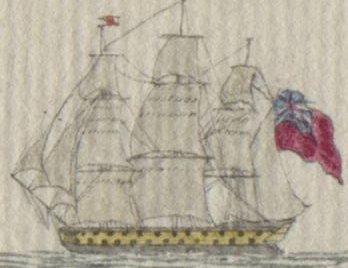
Vignette of the ship Bengal
|
True Briton: voyage 1804-1805; Ganges: voyage 1805-1807; Lady Jane Dundas: voyage 1805-1807; Huddart: voyage 1806-1807; Earl St Vincent: voyage 1806-1807. |
|
|
| Bensley hoy |
HEICS |
A hoy recorded by Captain Barker of the Northampton on Thursday 7th April 1803 while unloading at Deptford and also by Captain Rawes of the Warren Hastings at the East India Dock on the 3rd March 1823. |
Northampton: voyage 1801-1803; Warren Hastings: voyage 1823-1824. |
|
|
| Berwickshire |
HEICS |
Built by Charles Gordon & Co., Deptford 1821. 166ft long, 1333 tons. Sailed to China at least 6 times. Noted by Captain Rawes of the Warren Hastings on her third voyage under Captain John Shepherd. |
Warren Hastings: voyage 1825-1826. |
|
|
| Beschermer |
Royal Navy |
Built in 1799 she had been a Dutch man-of-war and in 1805 was captured by voluntary surrendering (the seamen having refused to fight against the orange flag) to a British squadron under Vice-admiral Mitchell, in the Vlieter, Texel. (Vol iii, Appendix No 2) and was fitted out as a store ship at Chatham. At the end of 1806 she was loaned to the East India Dock Company. On Saturday 12 September 1807 she was described by Captain Bayliff of the Huddart as a hulk moored at Blackwall just outside the HEICS basin. On Thursday 5th September 1811 she was noted by Captain Campbell of the Lord Keith who moored alongside the hulk at Blackwall just outside the HEICS basin. On Thursday 5th September 1811 she was mentioned by Captain Campbell of the Lord Keith as alongside the hulk. She was still a hulk on 28th June 1826 when Captain Rawes of the Warren Hastings moored along side her. 1834 still on loan to the East India Company at Blackwall. See https://sites.rootsweb.com/~pbtyc/18-1900/C/01156.html. |
Huddart: voyage 1806-1807; Lord Keith: voyage 1810-1811; Warren Hastings: voyage 1815-1816; Warren Hastings: voyage 1825-1826. |
|
|
| Betsey |
misc |
A whaler on convoy with Georgiana starting at Mother Bank off the Isle of Wight in August 1803 and on Friday 23rd September 1803 she was given permission to part from the convoy and head south. |
Georgiana: voyage 1803-1807. |
|
|
| Betsey |
misc |
On Wednesday 21st March 1804, the logs of the Georgiana, record the arrival of the Betsey of Salem, Massachusetts arriving at St Helena. There is no indication whether she is a whaler or merchant. |
Georgiana: voyage 1803-1807. |
|
|
| Blenheim |
Royal Navy |
Launched 5th July 1761, second rate, armament of 74 in 1790, reduced to 3rd rate in 1800. In April 1805 she sailed from England as support ship for the annual HEICS convoy. On Friday 6th September 1805 she set sail from Madras to Prince of Wales Island [Penang], with the China ships. On 17th October 1806 she was noted at Penang by Captain Lindsay of the Lady Jane Dundas. In February 1807 she was lost, along with HMS Java, in a storm off the island Rodrigue in the Indian Ocean with all hands estimated at 590 souls, her then commander was Captain Austin Bissell. Those lost aboard the Blenheim included Admiral Sir Thomas Troubridge, Captain Austin Bissell, Captain Charles Elphinstone (nephew of Admiral Lord Keith), the midshipmen George, Lord Rosehill (eldest son and heir of Rear-Admiral the Earl of Northesk) and William Henry Courtenay (illegitimate son of Admiral the Duke of Clarence). Also lost was former HMS Bounty mutineer James Morrison. Her history is detailed on the sites https://sites.rootsweb.com/~pbtyc/18-1900/C/01156.html & https://en.wikipedia.org/wiki/HMS_Blenheim_(1761). |
Ganges: voyage 1805-1807; Lady Jane Dundas: voyage 1805-1807; Cumberland: voyage 1805-1806. |
|
|
| Blossom |
Royal Navy |
Royal Navy Blossom is listed on Wikipedia as an "18-gun Cormorant-class sloop-of-war. She was built in 1806 and is best known for the 1825–1828 expedition under Captain Beechey to the Pacific Ocean. She explored as far north as Point Barrow, Alaska, the furthest point into the Arctic any non-Inuit had been at the time. In 1812, she is also accredited with capturing the French schooner Jean Bart, commanded by Captain Jean Francis Coulome. A detailed service record can also be found on the website: https://sites.rootsweb.com/~pbtyc/18-1900/C/01156.html. On 10 the Sep 1821 she left St Helena to transfer to the 'South American Station', then on 27th Nov 1821, she was off Brazil. On Tuesday 4th May 1724, while in the mid Atlantic, Captain Rawes records: "6am sent a boat on board H.M. Ship Blossom from Valparaiso 20th January & Rio Janeiro March 29th". She became a hulk in 1833 and was finally broken up in 1848.

Image of HMS Blossom copied from the Wikipedia entry.
|
Warren Hastings: voyage 1823-1824. |
|
|
| Bombay lighter |
HEICS |
A lighter noted in the Journal as coming alongside the True Briton at Blackwall on Monday 11th October 1805. |
True Briton: voyage 1804-1805. |
|
|
| Bombay |
Royal Navy |
Launched 1793, 672-ton frigate for the East India Company. She served as the Bombay until the Royal Navy purchased her in 1805 as a 5th rate with armament of 38, complement of 235. Recorded by Captain Jones of the Earl St Vincent as arriving at Point de Galle on Saturday 7th March 1807. Noted on 15th March 1807 by Captain Lindsay of the Lady Jane Dundas as at Point de Galle. Captain Sanders of the Northampton recorded her in the river Hooghly as the Bombay on Tuesday 10th May 1808. In 1808 she was renamed the Ceylon. See Wikipedia and the website https://sites.rootsweb.com/~pbtyc/18-1900/C/01156.html, for further information. Disposed of in 1857. |
Lady Jane Dundas: voyage 1805-1807; Earl St Vincent: voyage 1806-1807; Northampton: voyage 1807-1809; Huddart: voyage 1806-1807. |
|
|
| Bombay (3) |
HEICS |
Built Bombay 1807, 163ft long, 1243 tons. Sailed to China at least 12 times. On her 9th voyage under Captain John Charretie when noted by Captain Rawes of the Warren Hastings. |
Warren Hastings: voyage 1825-1826. |
|
|
| Bombay Castle |
HEICS |
Built by Randall, launched 1792, length 164ft, 1234 tons. Sailed to China at least 6 times. On her 5th voyage, under Captain Archibald Hamilton when recorded by Captain Clarke of the Wexford as at Whampoa on 11th December 1803. Captain Harington of the Ganges noted her at Whampoa on Saturday 15th February 1806. Captain Farrer of the Cumberland noted her in the Indian Ocean on Friday 30th May 1806. |
Wexford: voyage 1803-1804; Cumberland: voyage 1805-1806; Ganges: voyage 1805-1807. |
|
|
| Botany Bay Man |
misc |
A ship possible ship noted in the log of the Georgiana as arriving at St Helena on 11th July 1804. Botany Bay Man is noted amongst other ships but the wording is not clear as this may refer to the previous ship called Rolla. |
Georgiana: voyage 1803-1807. |
|
|
| Brampton |
HEICS |
Recorded by Captain Barker of the Northampton as coming alongside the Brampton at Calcutta on Friday 9th October 1802, nothing else known. |
Northampton: voyage 1801-1803. |
|
|
| Brazil Man |
misc |
On Sunday 1st July, while at Madeira, there departed the Brazil Man. |
Lord Keith: voyage 1810-1811. |
|
|
| Bridgewater Sloop |
HEICS |
Recorded by Captain Barker of the Northampton as coming alongside the Bridgewater sloop at Calcutta on Friday 12th October 1802. Also probably noted by Captain Campbell of the Lord Keith at Calcutta on 20th February 1811. |
Northampton: voyage 1801-1803; Lord Keith: voyage 1810-1811. |
|
|
| Bridgewater (5) |
HEICS |
Built 1812, 166ft long, 1276 tons. Sailed to China at least 9 times. She was noted on her second voyage, under Captain Philip Hughes by Captain Rawes of the Warren Hastings on 30th October 1815 as arriving at Whampoa and on her seventh voyage, under Captain John Rennie Manderson by Captain Rawes of the Warren Hastings. Her last recorded voyage was in 1828/30 when she suffered storm damage and was eventually condenmed at Calcutta 31st May 1831.
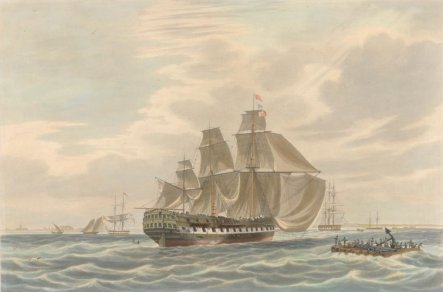
The Bridgewater entering Madras Roads under jury mast on 10th April 1830.
Painting by William John Hughes.
|
Warren Hastings: voyage 1815-1816, Warren Hastings: voyage 1825-1826. |
|
|
| Britannia |
HEICS |
There were nine ships that carried the name Britannia of which at least two were working for the Company in 1804. One recorded by Farrington, the other a 'country ship' employed by the Company to mostly plough the seas in the east. There are however other ships named Britannia around at the time so there is a degree of confusion.
The first has been identified as Britannia (4), a Company ship built in India, launched 1775 length 134ft, 770 tons. Wikipedia states that she was built in Bombay 1772/5. There are thirteen voyages recorded by Farrington. Farrington records that this ship left St Helena for Madras on the 5th March 1804, commanded by Captain Jonathan Birch. The log of the Georgiana records that the Britannia arrived at St Helena on the 4th March 1804. She was still moored at St Helena on the 28th April Captain Birch and his chief officer Mr James Bird took part in an enquiry. On her return voyage she is noted as an extra ship arriving in convoy at St Helena on 31st December 1804. She departed in convoy for England on 13th January 1805. Her last recorded voyage ended in 1805 when she was wreaked on the coast of South Africa, see Wikipedia.
|
Georgiana: voyage 1803-1807. |
|
|
| Britannia |
HEICS |
There were nine ships that carried the name Britannia of which at least two were working for the Company in 1804. One recorded by Farrington as standard England to India and beyond, the other a 'country ship' employed by the Company to mostly plough the seas in the east. There are however other ships named Britannia around at the time so there is a degree of confusion.
The log of the Georgiana states that on Wednesday 18th January 1804 'Arrived the Britannia Country ship with stores from Bengal'. It is not clear which ship this is but what is certain is that she is not the Company ship Britannia recorded in the same log as arriving at St Helena on 4th March 1804. See Farrington and Wikipedia. On 22nd July 1804 the log of the Georgiana while at St Helena recorded a ship called Britannia as going on a cruise. This suggests that this Britannia had taken on a partly military role. Again the same ship is thought to have set sail with the ship Company Frigate on for India on Wednesday 1st August 1804.
|
Georgiana: voyage 1803-1807. |
|
|
| Britannia - Luke |
HEICS |
There were nine ships that carried the name Britannia of which at least two were working for the Company in 1804. One recorded by Farrington as standard England to India and beyond, the other a 'country ship' employed by the Company to mostly plough the seas in the east. There are however other ships named Britannia around at the time so there is a degree of confusion.
Apparently not recorded as a Company ship by Farrington. Nothing else known except that she arrived at St Helena from Madras on Sunday 28th March 1824. |
Warren Hastings: voyage 1823-1824. |
|
|
| Britannia |
misc |
A whaler noted in the log of the Georgiana as arriving at St Helena on 16th August 1805. |
Georgiana: voyage 1803-1807. |
|
|
| British Tar |
misc |
Launched at Shields in 1792 at 320 tons, making six voyages as a whaler and several as a West Indiaman. As a whaler she was noted in the log of the Georgiana as arriving at St Helena on Friday 6th April 1804. She departed St Helena on 4th May commanded by Captain Innis. She was lost on the Dorset coast on 29th January 1818. See Wikipedia. |
Georgiana: voyage 1803-1807. |
|
|
| Brook Watson |
misc |
Launched in 1796, probably in Holland or possibly in Denmark. Captured by the British in 1801 and became a whaler in the Southern Sea. She made two voyages then became a West Indiaman. Noted in the log of the Georgiana as arriving at St Helena on 8th May 1804. Last listed in 1809-10. See Wikipedia. |
Georgiana: voyage 1803-1807. |
|
|
| Brothers |
misc |
A whaler noted in the log of the Georgiana as arriving at St Helena on the 10th May 1804. She sailed in convoy to England on Friday 18th May. The same log later records: that the whaler arrived at St Helena on 19th January 1806. |
Georgiana: voyage 1803-1807. |
|
|
| Brothers |
misc |
An American ship noted in the log of the Georgiana as arriving at St Helena from Isle de France on the 22nd December 1805. sailed in convoy to England on Friday 18th May. |
Georgiana: voyage 1803-1807. |
|
|
| Broxbornebury |
HEICS |
Built by Pitcher, launched 1812, 3 decks, 132ft long, 709 tons. This was her first voyage, her Captain was Thomas Pitcher [jnr]. She sailed with the convoy from Portsmouth on 7th May 1812. She was, in part, a convict ship and carried 120 female prisoners bound for Australia. See: www.historyaustralia.org.au/twconvic/Broxbornebury+1814, see also Wikipedia. She joins the convoy again on her return voyage at St Helena in June 1813. Her last known voyage was to China and Quebec in 1832. |
Juliana: voyage 1812-1813. |
|
|
| Brunswick (1) |
HEICS |
Built by Perry, launched 1792, length 130+ft 1244 tons. She made six voyages to the Far East. She was captured by the French on 11th July 1805 off the Point de Galle. She ran ashore in Simons Bay at the Cape of Good Hope on 2nd Sept 1805. Her crew and passengers were noted in the log of the Georgiana when the cartel ship Eliza arrived at St Helena on 16th November 1805: the entry runs: 'Anchored the Eliza (cartel) brig from the Cape of Good Hope with the officers & crew of the H.C. ship Brunswick taken in India by Admiral Lenois'. |
Georgiana: voyage 1803-1807. |
|
|
| Bucephalus |
Royal Navy |
A troopship launched in 1808. Armament 32. Took part in the invasion of Java in 1811. Captain Rawes of the Julian noted her arrival at St Helena on 8th June 1813. In convoy from St Helena to England. See: https://sites.rootsweb.com/~pbtyc/18-1900/C/01156.html. |
Juliana: voyage 1812-1813. |
|
|
| Buckinghamshire |
HEICS |
Built in Bombay 1816. 166ft long, 1369 tons. Sailed to China at least 10 times. Noted by Captain Rawes of the Warren Hastings on her sixth voyage under Captain Richard Glasspoole. Noted by Captain Dalrymple of the Vansittart on her 7th voyage under Captain Richard Glasspoole. Noted by the Captain Gribble of the Repulse on her ninth voyage under Captain Richard Glasspoole. Noted in the journal of the Bridgewater as at Whampoa on Wednesday 2nd September 1828. After her last voyage under the Company flag in 1833/4, she was sold for £10,550. |
Warren Hastings: voyage 1825-1826; Vansittart: voyage 1826-1828; Bridgewater: voyage 1828-1830; Repulse: voyage 1831-1832. |
|
|
| Buckle |
misc |
Described by Captain Dalrymple at Saugor a tradesman sailing from her mooring on Wednesday July 25th 1827. Not traced. |
Vansittart: voyage 1826-1828. |
|
|
| Burgess hoy |
HEICS |
A hoy recorded by Captain Barker of the Northampton on Wednesday 13th April 1803 while unloading at Deptford. On 15th August 1804 she was used to offload cargo from the Wexford. On 24th September 1806 she was mentioned by Captain Farrer of the Cumberland while disembarking cargo at Long Reach. |
Wexford: voyage 1803-1806; Northampton: voyage 1801-1803; Cumberland: voyage 1805-1806. |
|
|
|
C |
| Caesar |
misc |
A free trader noted riding at The Downs on 17th March 1832. |
Repulse: voyage 1831-1832. |
|
|
| Calcutta |
Royal Navy |
Purchased from the HEICS in 1795 who changed her name to Warley. Amongst other tasks she transported convicts to Australia. She was noted in log of the Georgiana as arriving at St Helena on Saturday 20th July 1805 'for a convoy'. The convoy gathered and she sailed on 3rd August. The following day arrived a Prussian ship 'colours prize to HMS Calcutta'. Later that year she was captured by the French ship Magnanime. In 1809 she took part in the Battle of the Basque Roads and was grounded on the shoals of Les Palles and abandoned by her crew. The British boarded and burnt her. See under Warley for her earlier history.

The Calcutta stranded in the background.
|
Georgiana: voyage 1803-1807. |
|
|
| Calcutta (4) |
HEICS |
Built by Wells, launched 1798, length 146ft, 819 tons. She made five voyages to India. On her third, under Captain William Maxwell, she was noted by Captain Clarke of the Wexford on 31st July 1803 as approaching Madras from England. On Saturday 28th September 1805 Captain Harington of the Ganges noted her at Saugor, this was her fourth, under Captain John Reddie. Her fifth and final voyage was in 1808, Commanded by Captain William Marshall, when she parted company from the convoy off Mauritius 14th March 1809, and was not heard of again. |
Wexford: voyage 1803-1804; Ganges: voyage 1805-1807. |
|
|
| Calcutta hoy |
HEICS |
A hoy noted in the Journal of the True Briton as coming alongside at Blackwall on Tuesday 12th November 1805. Mentioned by Captain Farrer of the Cumberland while disembarking cargo at Long Reach on Tuesday 16th September 1806. |
True Briton: voyage 1804-1805; Cumberland: voyage 1805-1806. |
|
|
| Calcutta |
HEICS |
Built by Wells, launched 1798, length 146ft, 819 tons. She made five voyages to India. On 31st July 1803 she was noted by Captain Clarke of the Wexford as approaching Madras from England. On 28th June 1804 she was noted in the log of the Georgiana as arriving in convoy at St Helena on her return voyage to England. She departed for England in convoy on 13th August 1804. Noted again in the log as sailing from St Helena to Bengal on 17th July 1805. A short while after sailing smoke was seen billowing from her and the Georgiana immediately set sail to help her but the fire was contained by the ship's crew and she continued on her way. Her commander was Captain John Reddie. On 28th Sept 1805 Captain Harington of the Ganges noted her at Saugor, under Captain John Reddie. On 18th August 1806, she was noted by Captain Lindsay of the Lady Jane Dundas as leaving Diamond Harbour. She was noted again in the log of Georgiana as arriving in convoy at the Cape of Good Hope on 30th December 1806. On 2nd February 1807 she left St Helena in convoy for England. Her fifth and final voyage was in 1808, commanded by Captain William Marshall, when she parted company from the convoy off Mauritius 14th March 1809, and was not heard of again. |
Wexford: voyage 1803-1804; Georgiana: voyage 1803-1807; Ganges: voyage 1805-1807; Lady Jane Dundas: voyage 1805-1807. |
|
|
| Calcutta |
Royal Navy |
Designed by Sir Robert Seppings, and was the only ship built to her draught. Built in teak at Bombay Dockyard, launched 14 March 1831. 2nd rate, 84 guns, sail, length 196ft, 2291 tons, 720 crew. Noted at Madras by Captain Gribble of the Repulse on Saturday 28th May 1831, as she was beginning her maiden voyage to England under Captain Jervoise. A history of her is to be found in Wikipedia. See also https://sites.rootsweb.com/~pbtyc/18-1900/C/01156.html. She was sold in 1908. In 2013 the figure was restored in Devon and transported to the National Navy Museum where it is now housed, Westcountry News.
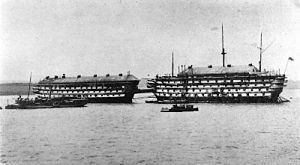
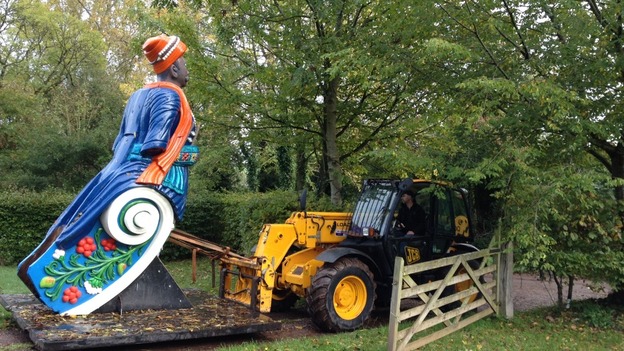
HMS Calcutta in 1890 and her figurehead in 2013.
|
Repulse: voyage 1831-1832. |
|
|
| Caledonia |
HEICS |
No information given by Farrington but he does record three voyages to India, this was her third. Commanded by Captain George Thomas. She was built in 1795 by Gillmore & Co in Calcutta and left the Service in 1802 when she sailed for Calcutta and returned to the coastal trade in India. She was destroyed by fire on passage from Balasore roads to Bombay in 1803. |
Northampton: voyage 1801-1803. |
|
|
| Caledonia |
misc |
A whaler noted in the log of the Georgiana on Tuesday 10th January 1804 as arriving at St Helena on her return voyage. Although the entry reads: Calladonie, it is apparent from the Wikipedia entry that this was the Caladonia on her 4th voyage under Captain Page. She was noted again in the same log as arriving at St Helena on the 21st of December 1805. She was launched in Spain in 1780 and apparently seized in 1797. She made one voyage to the Caribbean and then made five voyages to the Southern Ocean. She arrived back in England on the 4th April 1804. |
Georgiana: voyage 1803-1807. |
|
|
| Camoens |
misc |
A Portuguese ship noted by Captain Campbell of the Lord Keith in the Bay of Bengal on 12th March 1811,.nothing more known. |
Lord Keith: voyage 1810-1811. |
|
|
| Camperdown Bay |
misc |
No information but maybe connected to Australia in some way because of her name - a suburb of Sydney. She may also be the barque Camperdown arriving in Quebec from Limerick on 7th September 1819. She is described by Captain Campbell of the Lord Keith as being a packet at St Helena on 18th June 1811, she departed on 19th June. Captain Rawes, while on the Juliana sighted the Camperdown Bay on 24th June 1813. It is not known whether this is the same ship.
|
Lord Keith: voyage 1810-1811; Juliana: voyage 1812-1813. |
|
|
| Canada |
Royal Navy |
Launched 1766, 3rd rate, armament 74. On 24th April 1800 while in Torbay, the Channel Fleet, under the command of Sir Alan Gardner, departed, viz. Ville de Paris, Barfleur, Glory, London, Neptune, St George, Temeraire, Windsor Castle, Ajax, Achilles, Cumberland, Canada, Captain, Centaur, Defence, Defiance, Elephant, Excellent, Hector, Impetueux, Marlborough, Ramilies, Resolution, Robust, Russel, Saturn, Superb, Terrible, Venerable, Warrior, Sheerness, Amelia, Sea Horse, Thames, and Havick. See: https://sites.rootsweb.com/~pbtyc/18-1900/C/01156.html, for her history. On Sunday 7th September 1807, the Lieutenant of the Canada came on board the Earl St Vincent while in the Thames Estuary. In 1811 she was a prison ship at Chatham and she was disposed of in 1834. |
Earl St Vincent: voyage 1806-1807. |
|
|
| Canton |
HEICS |
Built by Wells, launched 1790, length 165ft, 1210 tons. She is recorded sailing to China eight times. Noted in the journal of the Georgiana as at Blackwall on Sunday 17th July 1803. Noted again in the same log as arriving in convoy from China at St Helena on 2nd April 1805. Noted in the Journal of the True Briton as part of the homeward-bound Convoy which set sail from St Helena on 12th July 1805, her commander was Captain Thomas Lushington. She was sold in 1812 and later became a transport and store ship until she was hulked. In 1829 she was sunk to serve as a dry dock at Limehouse by removing her decks, opening up her stern with gates and piling earth around her. She was finally broken up in 1898.
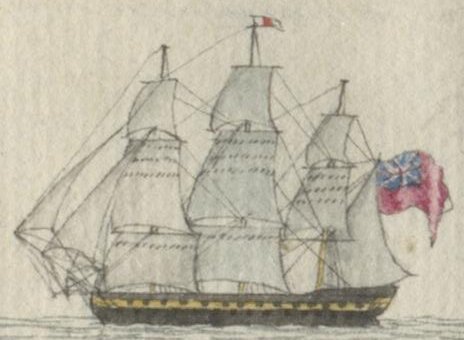
Vignette of the ship Canton
|
Georgiana: voyage 1803-1807; True Briton: voyage 1804-1805. |
|
|
| Canton hoy |
HEICS |
A hoy noted as coming alongside the True Briton at Blackwall on Wednesday 13th November 1805. Noted by Captain Rawes of the Warren Hastings at the East India Dock on 10th March 1823. |
True Briton: voyage 1804-1805; Warren Hastings: voyage 1823-1824. |
|
|
| Caroline |
Royal Navy |
Launched at Randall's Yard, Rotherhithe 1795 as a 5th rate, armament 38, complement 261. Noted by Captain Harington of the Ganges as arriving at Madras on Sunday 1st September 1805, she had returned from accompanying a convoy to China. For her history see: https://sites.rootsweb.com/~pbtyc/18-1900/C/01156.html. She was disposed of in 1815. |
Ganges: voyage 1805-1807. |
|
|
| Carmarthen |
HEICS |
Built by Randall, launched 1802, length 125ft 552 tons. Eight voyages to the Far East are recorded. Noted in the log of the Georgiana as sailing from St Helena for England on 18th June 1804. She had arrived at St Helena on the 6th June. Her commander was Captain John Dobrée. She appears again in the same log as arriving at St Helena on 24th February 1806. Her last recorded voyage ended in 1820. |
Georgiana: voyage 1803-1807. |
|
|
| Carmelita |
HEICS |
A Country ship noted in the journal of the Bridgewater exchanged cargo at Whampoa on Tuesday 8th December 1829. Nothing else known about her. |
Bridgewater: voyage 1828-1830. |
|
|
| Carnatic hoy |
HEICS |
A hoy recorded by Captain Hughes of the True Briton at Longreach on Thursday 24th October 1805. Carnatic is a peninsular in South India lying between the Eastern Ghats and the Bay of Bengal. There was also a Company ship of that name. |
True Briton: voyage 1804-1805. |
|
|
| Caroline |
misc |
A brig showing English colours. Noted by Captain Rawes of the Warren Hasting in the North Atlantic on 23rd May 1825. There was a frigate called The Caroline, built in Bombay in 1814, 575 tons and built for the Imaum of Muscat. |
Warren Hastings: voyage 1825-1826. |
|
|
| Carrivan |
misc |
An American brig from Calcutta noted in the log of the Georgiana as arriving at St Helena on 11th February 1806. She sailed the following day. |
Georgiana: voyage 1803-1807. |
|
|
| Carrisan |
misc |
An American brig noted in the log of the Georgian as arriving at St Helena on 6th March 1805. She sailed on the 10th March 1805. |
Georgiana: voyage 1803-1807. |
|
|
Carron |
HEICS |
No details given by Farrington. He records two voyages to China in 1795 & 1799 only, so this time she was not sailing under the HEICS flag. Captain Barker of the Northampton described her as an Indiaman. She was built at Bombay and launched 21 Jul 1792. In 1804 she was sold to the Admiralty as a 5th rate, 38 gun vessel and renamed the Duncan. In 1807 she was renamed the Dover. She was wrecked off Madras on 2nd May 1811. See: eicships.threedecks.org/. |
Northampton: voyage 1801-1803. |
|
|
| Cashimore |
misc |
Possible mistaken by Captain Dalrymple of the Vansittart for Cashmere. She was recorded by Captain Dalrymple near Singapore on Monday 24th September 1827. |
Vansittart: voyage 1826-1828. |
|
|
| Cassimbazar |
misc |
A boat noted in the journal of the Bridgewater on Saturday 13th June 1829 at Saugor. She was employed transporting cargo from Calcutta to the ship at Saugor. |
Bridgewater: voyage 1828-1830. |
|
|
| Castle Eden |
HEICS |
Built by Pitcher and launched 1799, length 145ft, 818 tons. She made six voyages to the East. On her 1st voyage the Georgiana noted that she arrived at St Helena from Madras on Sunday 27th November 1803 and left on Thursday 5th January 1804. On her third, under Captain Richard Colnett she was noted by Captain Farrer of the Cumberland at Madras on 30th Aug 1805 and Captain Harington of the Ganges. She was noted again in the Log of the Georgiana as arriving at St Helena from Bencoolen on 10th April 1806. She left St Helena on the 13th April. Her last recorded voyage was in 1812. |
Georgiana: voyage 1803-1807; Cumberland: voyage 1805-1806; Ganges: voyage 1805-1807. |
|
|
| Castle Huntley |
HEICS |
Built in Bengal 1812. 167ft 7¾in long at 1311 tons. She made 11 voyages to the east. Noted On maiden voyage, under Captain John Paterson, by Captain Rawes of the Juliana as arriving at St Helena on the 8th June 1813. |
Juliana: voyage 1812-1813. |
|
|
| Castlereagh |
HEICS |
Built by Randall, launched 1802, length 146ft, 821 tons. She made seven voyages to the East. Noted on her second, under Captain Thomas Garland Murray, by Captain Harington of the Ganges. Her last voyage with the HEICS was in 1817. In December 1817 she set sale for New South Wales, Australia as a convict ship landing on 11th June 1818. |
Ganges: voyage 1805-1807. |
|
|
| Centurion |
Royal Navy |
Launched at Harwich in 1774, 4th rate, armament 50, 1044 tons. She was noted in the Log of the Wexford as at Madras on 4th August 1803, along with HMS Trident HMS Lancaster & HMS Victor. On 7th Nov 1803 the Trident, Tremendous, Centurion, and Lancaster, of the line; Dedaigneuse, frigate; and Albatross, sloop, arrived at Bombay from Madras. Noted in the log of the Georgiana as arriving at St Helena on Monday 31st December 1804. She was escorting a convoy of Company ships. She sailed as escort for England on 13th January 1805. In 1811 she was a receiving ship based at Halifax (Nova Scotia?). See the website: https://sites.rootsweb.com/~pbtyc/18-1900/C/01156.html, for her history. |
Northampton: voyage 1801-1803; Wexford: voyage 1803-1804; Georgiana: voyage 1803-1807. |
|
|
| Ceres |
misc |
A ship presumed to be recently captured she was noted in the log of the Georgiana on Saturday 10th December 1803 as at St Helena. She is noted in the same log as departing on 26th Feb. 1804. The log states that she was a 'prize whaler'. James Harrington the 2nd officer of the Georgiana, was in charge of overhauling her cargo. She could have been the whaler launched in Ipswich in 1787 as noted in Wikipedia, however Mr Harrington supervising her cargo and the word 'prize' suggesting that she had recently been captured. |
Georgiana: voyage 1803-1807. |
|
|
| Ceres (4) |
HEICS |
Built by Perry, launched 1796, length 176ft, 1430 tons. She made nine voyages to the Far East. Noted in the journal of the True Briton as at Gravesend on Wednesday 14th March 1804, commanded by Captain Henry Dunsford. Noted by Captain Lindsay of the Lady Jane Dundas at Portsmouth on 4th March 1806 as part of the outward bound convoy, under Captain William Dunsford. On 17th July 1806 Captain Harington of the Ganges noted the Ceres at Bombay. Also noted by Captain Rawes of the Warren Hastings on her ninth voyage, under Captain Hugh Scott. Her last recorded voyage was in 1815.
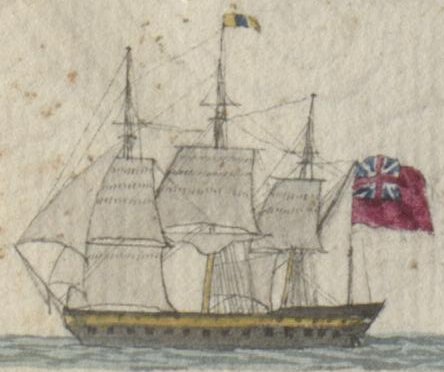
Vignette of the ship Ceres
|
True Briton: voyage 1804-1805; Ganges: voyage 1805-1807; Lady Jane Dundas: voyage 1805-1807; Warren Hastings: voyage 1815-1816. |
|
|
| Ceres |
misc |
Brig recorded by Captain Dalrymple of the Vansittart on Sunday 3rd June 1827 in the Bay of Bengal as out of London. There are a number of references to a brig called Ceres but they are of a ship trading with USA. |
Vansittart: voyage 1826-1828. |
|
|
| Ceylon |
HEICS |
Built by Pitcher and launched at Northfleet 1803, length 148ft, 818 tons. 4 recorded voyages to India between 1803 and 1811. Noted in the log of the Georgiana as at St Helena on 11th July 1804 when she drifted and ran foul of the Georgiana. She departed for England in convoy on 13th August 1804. Noted by Captain Sanders of the Northampton on her third voyage, under Captain Thomas Hudson. In 1810 she was captured by the French and taken to Mauritius and used as a prison ship by the French. Within the same year she was recaptured by the British and continued on her voyage. She was sold in 1811 and used as a transport ship. She was sold again, this time to foreign buyers, on 18th Sep 1815. |
Georgiana: voyage 1803-1807; Northampton: voyage 1807-1809. |
|
|
| Charles |
misc |
Post Office Packet from Guadeloope. Noted by Captain Rawes of the Warren Hastings in the Atlantic on 3rd May 1816. |
Warren Hastings: voyage 1815-1816. |
|
|
| Charles lighter |
HEICS |
A lighter noted in the Journal as coming alongside the True Briton at Blackwall on Tuesday 5th November 1805. |
True Briton: voyage 1804-1805. |
|
|
| Charles Grant |
HEICS |
Built Bombay 1810, 165ft long, 1274 tons. She made at least twelve trips are recorded by Farrington. Noted on her maiden voyage by Captain Campbell of the Lord Keith, sailing under Captain Thomas Talbot Harington. Noted by Captain Rawes of the Warren Hastings on her fourth voyage under Captain John Lock. Noted by Captain Rawes of the Warren Hastings on her sixth, under Captain Hugh Scott. By Captain Rawes on her ninth voyage, under Captain William Hay and again by Captain Rawes on her ninth voyage, under Captain William Hay. She was also noted in the journal of the Bridgewater as at Whampoa on Thursday 13th Aug 1828. |
Lord Keith: voyage 1810-1811; Warren Hastings: voyage 1815-1816; Warren Hastings: voyage 1819-1820; Warren Hastings: voyage 1823-1824, Warren Hastings: voyage 1825-1826; Bridgewater: voyage 1828-1830. |
|
|
| Charlotte |
HEICS |
A Country ship from Bengal that arrived at Madras on Saturday 22nd November 1806. |
Earl St Vincent: voyage 1806-1807. |
|
|
| Charlton |
HEICS |
Built by Humble at Liverpool, launched 1799, length 146ft, 818 tons. She is recorded as making six voyages to India. Noted in the log of the Georgiana at arriving at St Helena on 8th March 1804, on her return voyage to England. She left in convoy on the 1st April 1804. Her commander was Captain Thomas Welladvice. She was captured by the French on 18th November 1809. |
Georgiana: voyage 1803-1807. |
|
|
| Charlton |
misc |
A whaler, 270 tons, owned by Mather & Co. believed to be built in 1803. She made four voyages as a whaler of which this wass her first, commended by Captain Samuel Chace. Noted in the log of the Georgian as arriving at St Helena on 20th February 1806. She was last listed in 1818. See Wikipedia for more information on her. |
Georgiana: voyage 1803-1807. |
|
|
| Charming Kitty |
misc |
A whaler reported on 26th October 1806 as arriving at the South Downs. She was recorded by Captain Sanders of the Northampton as at St Helena on Saturday October 15th 1808. |
Northampton: voyage 1807-1809. |
|
|
| Chatham sloop |
misc |
A sloop noted by Captain Campbell of the Lord Keith at Saugor on 15th Feb 1811. |
Lord Keith: voyage 1810-1811. |
|
|
| Chiffonne |
Royal Navy |
A French Frigate, fifth rate, armament 12 pdr, 36 guns. Taken by the British 19th April 1801 and put into service under the same name. Recorded by Captain Barker of the Northampton as at Bombay on 15th February 1802.
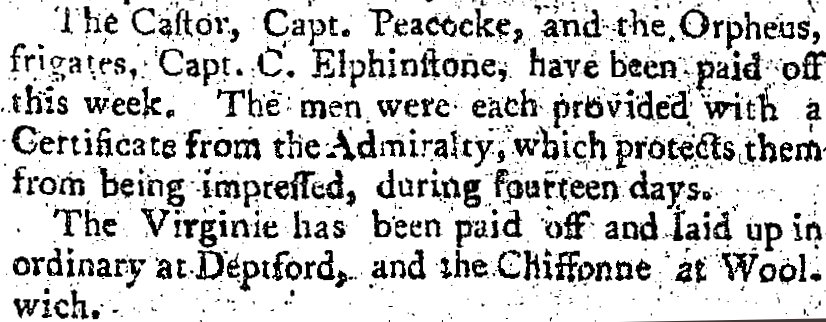
Mention of the Chiffonne, Orpheus and the Virginie
in the Hampshire Telegraph 18th April 1803.
|
Northampton: voyage 1801-1803. |
|
|
| Cirencester |
HEICS |
Built by Randall, launched 1795, length 176ft, 1439 tons. Noted in the log of the Georgiana as arriving in convoy from China at St Helena on 2nd April 1805. Noted in the Journal of the True Briton as part of the Convoy returning to England, under her Commander Captain Thomas Robertson. On 21st October 1806 she was noted by Captain Lindsay of the Lady Jane Dundas as arriving at Penang. This was her sixth voyage, commanded by Captain Henry Halkett. Her last recorded voyage was in 1812.
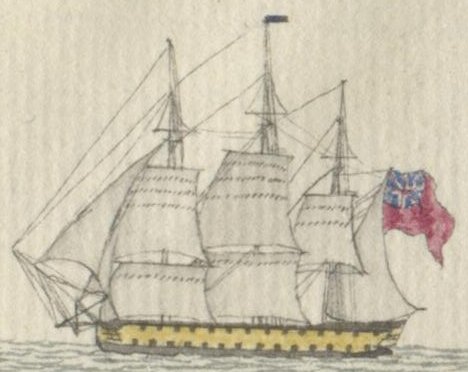
Vignette of the ship Cirencester
|
Georgiana: voyage 1803-1807; True Briton: voyage 1804-1805; Lady Jane Dundas: voyage 1805-1807. |
|
|
| City of Edinburgh |
misc |
On Friday 16th February 1827 while at Blackwall, Captain Dalrymple of the Vansittart noted that while at Gravesend the Vansittart was towed from her mooring by the City of Edinburgh steam boat. See under Wikipedia for Thames steam boats. |
Vansittart: voyage 1826-1828. |
|
|
| City of London |
HEICS |
Built by Randall and launched 1799, length 146ft, 820 tons. She made six voyages to the Far East. Noted in the log of the Georgiana as arriving at St Helena in convoy from the Far East on 28th June 1804. She departed for England in convoy on 13th August 1804. While at St Helena she must have lost her anchor as the log of the Georgiana recorded on 2nd of Sept. that she had 'Received orders to sweep for the City of London's anchor'. Noted by Captain Harington of the Ganges on her third, under Captain Samuel Landon. On Saturday 18th May 1805 she was in the Northern Atlantic on her way to the East. Noted by Captain Rawes of the Juliana on her sixth voyage, commanded by Captain Thomas Jenkins, she arrived at St Helena on 8th June 1813. Her last recorded voyage was in 1812. |
Georgiana: voyage 1803-1807; Ganges: voyage 1805-1807; Juliana: voyage 1812-1813. |
|
|
| Claudine |
HEICS |
Launched at Calcutta in 1811, 452 tons, Principal Managing Owner Joseph L Heathorn. She was a chartered ship for the East India Company in 1824/5. She made two voyages to Van Dieman's Land and New South Wales carrying convicts. The latter voyage her commander was Captain William Heathorn and she sailed to Madras on 31st December 1829. Noted in the journal of the Bridgewater at Saugor on Tuesday 13th April 1830. In 1840 she was caught in a storm and to save her she was deliberately beached along with the ship Westminster near Ramsgate. She was broken up in 1849. See https://en.wikipedia.org/wiki/Claudine_(1811_ship).

The Claudine in the foreground and the Westminster
in the background, ashore near Margate: Artist William Henry Bartlett.
Image from the above mentioned Wikipedia site.
|
Bridgewater: voyage 1828-1830. |
|
|
| Clyde |
Royal Navy |
Launched in the King's Dockyard at Chatham in 1796. 5th rate, armament 38, 1002 tons. See: https://sites.rootsweb.com/~pbtyc/18-1900/C/01156.html, for her history. While at Blackwall, she pressed 13 'lumpers' and one crew from the Northampton's on Thursday 23rd 1807. Broken up in 1814. |
Northampton: voyage 1807-1809. |
|
|
| Coal & Three John's lighter |
HEICS |
A lighter used at Blackwall to unload cargo from the Wexford on 31st August 1804. |
Wexford: voyage 1803-1804. |
|
|
| Coldstream |
HEICS |
An Extra ship built by Dudman, launched in 1810. 133ft long at 693 tons. Nine voyages to the east are recorded. On her maiden voyage, under Captain James P Mansell when Captain Rawes of the Julian noted her as arriving at St Helena on 8th June 1813. |
Juliana: voyage 1812-1813. |
|
|
| Colipersand |
HEICS |
A brig recorded by Captain Barker on Thursday 7th October 1802 as the Company barge coming alongside the Northampton at Calcutta. No other details found. |
Northampton: voyage 1801-1803. |
|
|
| Columbine |
HEICS |
A transport ship noted in the log of the Georgiana as arriving at St Helena along with HMS Adamant with troops for a Buenas Ayres on 2nd September 1806. She left St Helena for Buenas Ayres on 5th September with H.M.S. Adamant, Protector, Diadem. |
Georgiana: voyage 1803-1807. |
|
|
| Colossus |
Royal Navy |
A third rate ship of the line with 74 guns launched at Deptford on 23rd April 1803, so virtually on or about to start on her maiden voyage when she was noted in the log of the Georgiana as at Gravesend on Sunday 31st July 1803. She took part in the battle of Trafalgar under Captain James Nicoll Morris and was involved in heavy fighting. In 1815 she was placed in ordinary at Chatham and broken up in 1826. |
Georgiana: voyage 1803-1807. |
|
|
| Comet (2) |
HEICS |
Extra ship, built by Wells, launched 1801. length 120ft, 529 tons. This was her maiden voyage to Bengal out of two recorded by Farrington. Commanded by captain Thomas Larkins. See: http://eicships.threedecks.org/, for a conflict of builders. On 1st July 1803 on her return first voyage she was captured by the French north of Madeira and shortly after recaptured by the British. She was noted in the log of the Georgiana as arriving at the Cape in convoy from the East on 30th December 1806, her commander was Captain James Moring. On 2nd February 1807 she was noted in the log of the Georgiana as leaving St Helena in convoy for England. In 1807 she left the Service and was used as a troop ship. In 1810 she was transferred to the West Indies trade and was lost at sea in 1816. |
Northampton: voyage 1801-1803; Georgiana: voyage 1803-1807. |
|
|
| Commodore lighter |
misc |
A lighter at Deptford noted by Captain Barker of the Northampton on 23rd July 1801. |
Northampton: voyage 1801-1803. |
|
|
| Companion |
HEICS |
A cutter recorded by Captain Sanders of the Northampton as arriving at St Helena on Tuesday 18th October 1808 from the Cape. |
Northampton: voyage 1807-1809. |
|
|
| Commerce |
misc |
A whaler noted in the log of the Georgiana as arriving at Cape Town from St Helena on Thursday 22nd May 1806. She sailed for St Helena on 17th July 1806. |
Georgiana: voyage 1803-1807. |
|
|
| Concorde |
Royal Navy |
Taken from the French in 1783, 5th rate, 889 tons, armament 28 with a complement of 257. Captain Bayliff of the Huddart records the Concorde arriving at Bombay on 15 January 1807 under the command of Captain J. Cramer. She is mentioned in the crew list of the Ganges as receiving Cooper's mate Patrick Hayes while at sea. On 14th March 1807 she is at Point de Galle waiting for ships to gather as a convoy back to England. Captain Cramer of the Concorde is also recorded as boarding the Ganges at Point de Galle on her return voyage to England, note the log of the Ganges. She is mentioned in the crew list when a John Drake was taken on board the Lady Jane Dundas as an invalid on 18th on March 1807 while at Point di Galle from HM Albion by order of Captain Cramer of HM ship Concorde. The Concorde must have been short of Crew as the Earl St Vincent log records that a large number of her crew were pressed. See: https://sites.rootsweb.com/~pbtyc/18-1900/C/01156.html, for her interesting history. She was disposed of in 1811.
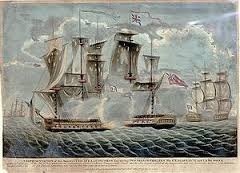
HMS Concorde
|
Ganges: voyage 1805-1807, Huddart: voyage 1806-1807; Earl St Vincent: voyage 1806-1807; Lady Jane Dundas: voyage 1805-1807. |
|
|
| Coote |
HEICS |
A cruiser belonging to the Company, noted as a 'sloop of war' by Captain Gribble of the Repulse at Madras on Sunday 29th May 1831. One of her main tasks was to suppress piracy in the seas around the Arabian Peninsula, Bay of Bengal and the northern India ocean. See the webstie http://www.barnettmaritime.co.uk/mainbombay.htm. |
Repulse: voyage 1831-1832. |
|
|
| Cornelia |
Royal Navy |
Launched in 1808. 5th rate, armament 32. In 1811 she took part in the invasion of Java. Disposed of in 1814. |
Juliana: voyage 1812-1813. |
|
|
| Cornwall |
misc |
Launched in 1794 as a West Indiaman. She made three whaling voyages to the Southern Ocean. On her third voyage she was noted in the log of the Georgiana as arriving at St Helena on Saturday 1st September 1804. She sailed on the 11th September. Last listed in 1824. See Wikipedia for her history. |
Georgiana: voyage 1803-1807. |
|
|
| Cornwallis |
HEICS |
There is a problem in identifying this ship, there are at least three options. The Cornwallis is recorded by Captain Harington, Commander of the Ganges, as passing near Singapore from China on Monday 9th December 1805.
- Cornwallis: fourth rate, armament 54, 1388 tons, purchased from HEICS 1801; late Marquis Cornwallis, noted as in the Indian Ocean in September/November 1806.
- Marquis Cornwallis: Extra ship built by Perry, 1794, length 121ft, 586 tons. One voyage from Bengal is recorded in 1796 after she had carried troops to Australia.
- Marquis Cornwallis: built at Bombay 1803, length 171ft, 1360 tons. One voyage is recorded from Bombay in 1803. She left Portsmouth in May 1804 to remain in India.
|
Ganges: voyage 1805-1807. |
|
|
| Cornwallis |
HEICS |
Built 1790, 653 tons. Her two recorded voyages are from Bombay in 1810 and 1817 so she was probably a Country Ship ploughing the seas between India and China. Her principal owner was Nasserwanjee Monackjee. Her Captain in 1817 was Thomas Brown. |
Northampton: voyage 1801-1803; Warren Hastings: voyage 1815-1816. |
|
|
| Coromandel hoy |
HEICS |
A hoy or barge belonging to the wharf or Company. Noted at Gravesend in the journal of the Wexford on Friday 18th Feb 1803. Mentioned by Captain Farrer of the Cumberland while disembarking cargo at Long Reach on Friday 19th September 1806. Noted by Captain Rawes of the Warren Hastings in the East India Dock on 28th Feb 1823. |
Wexford: voyage 1803-1804; Cumberland: voyage 1805-1806; Warren Hastings: voyage 1823-1824. |
|
|
| Courageux |
Royal Navy |
Launched at the King's Yard, Deptford 26th March 1800; 3rd rate, armament 74. The launch was attended by Admiral and Lady Hood and Captain Hood was its first commander. Noted in the log of the Georgiana as arriving at St Helena on 6th August 1804. She departed St Helena as escort for a number of ships that sailed for England on Monday 13th August 1804. On the 8th May 1804 she departed Spithead escorting a convoy of Indiamen to the East Indies. In 1830 she was a Lazaretto (quarantine station) at Chatham. See https://sites.rootsweb.com/~pbtyc/18-1900/C/01156.html for further information. |
Georgiana: voyage 1803-1807; True Briton: voyage 1804-1805. |
|
|
| Coutts |
HEICS |
Built by Randall and launched 1796, length 176ft, 1451 tons. She made eight voyages to China. Her third was under Captain Robert Torin and recorded in the journal of the Wexford as at Whampoa on 10th December 1803. Noted on her fourth voyage on Tuesday 21st May 1805 she was in the Atlantic on her way to the East, under Captain James Hay. On Friday 24th May 1805 she was off Madeira on her way to the East. She was sold for breaking in 1815. See: https://en.wikipedia.org/wiki/Coutts_(1797_EIC_ship). |
Wexford: voyage 1803-1804; Cumberland: voyage 1805-1806; Ganges: voyage 1805-1807. |
|
|
| Crocodile |
misc |
Post Office packet, frigate, launched 28th Oct 1825. 6th rate, armament 28, 500 tons. She was in the Far East during 1829-1831 and was noted at Madras by Captain Gribble of the Repulse, her commander was probably Captain R Bancroft. In later years she spent much time in central and north American waters. See the website: https://sites.rootsweb.com/~pbtyc/18-1900/C/01156.html . She was on harbour service from 1850 and sold in 1861. |
Repulse: voyage 1831-1832. |
|
|
| Cuffnells |
HEICS |
Built 1796, 176ft long, 1429 tons. Sailed to China at least 8 times. Noted in the journal of the True Briton as arriving at the Motherbank on Sunday 20th May 1804, under Captain Henry Halkett ready for her voyage to the East. Noted by the True Briton as sailing from St Helena with the Convoy back to England on 12th July 1805, commanded by Captain Henry Halkett. Noted by Captain Rawes of the Warren Hastings on her 8th voyage under Captain Robert Wellbank.
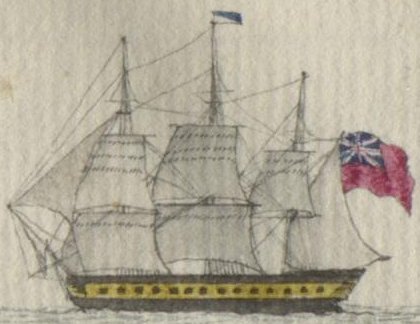
Vignette of the ship Cuffnells
|
True Briton: voyage 1804-1805; Warren Hastings: voyage 1815-1816. |
|
|
| Culloden |
Royal Navy |
Built 1783 by Randall at Rotherhithe. 3rd rate, armament 74, 1683 tons with a complement of 594. She had quite a career fighting the French and was involved in some of the most famous battles in the Napoleonic wars. Her history is at: https://sites.rootsweb.com/~pbtyc/18-1900/C/01156.html. In 1799 she was involved in the Egyptian campaign, see also Wikipedia. In 1799 she was involved in the Egyptian campaign. Not mentioned is that she was at Madras with the Royal Navy fleet on Wednesday February 17th 1808, commanded by Admiral Sir Edward Pellew, Rear-Admiral of the Red, and Commander in Chief of Her Majesty's ships and vessels in the East Indies. The Fleet had returned from destroying Dutch ships at Batavia. On the https://sites.rootsweb.com/~pbtyc/18-1900/C/01156.html site there is an extract from the ship's log detailing her surviving a hurricane in 1809. She was broken up in 1813.
Admiral Sir Edward Pellew, later 1st Viscount Pellew, was born 19th April 1757 and died at Teignmouth, Devon 23rd January 1833. He was also immortalised by C.S. Forrester in his Hornblower series of books. See Wikipedia for his life and career. |
Earl St Vincent: voyage 1806-1807; Northampton: voyage 1807-1809. |
|
|
| Cumberland |
HEICS |
Built by Dudman, launched 1802, length 165ft, 1260 tons. She made seven voyages to China. She was recorded by Captain Clarke of the Wexford as at Whampoa on 29th October 1803 and again on 11th June 1805 Captain Harington of the Ganges, her commander on both occasions being Captain William Ward Farrer. Her last voyage was in 1817. |
Wexford: voyage 1803-1804; Ganges: voyage 1805-1807. |
|
|
| Cuthbert Thornhill |
misc |
Noted on Friday 7th December 1810 at Calcutta, otherwise unknown.
|
Lord Keith: voyage 1810-1811. |
|
|
|
D |
| Danube |
misc |
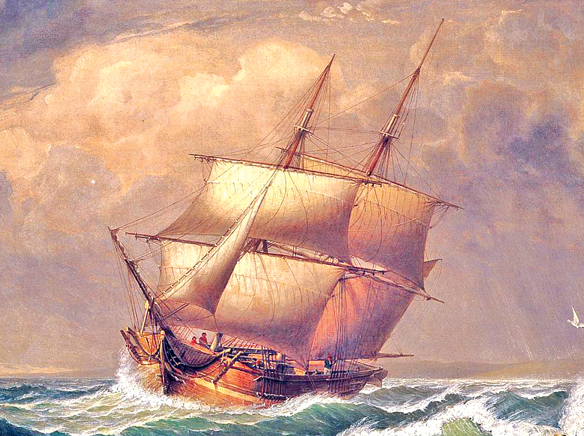
The Danube
An American Brig, she is mentioned in The Asiatic Journal in 1822. Captain Dalrymple of the Vansittart recorded her on Monday 15th Oct 1827 as 8 days out of Manilla en route for Boston, he spoke to her captain. She was wrecked in 1828 off the coast of California: "There came, too, in 1828, an influx of twenty-eight other foreigners, most of them being survivors of the American brig Danube, which had been wrecked at San Pedro on Christmas Day." A more detailed account of the survivors is to be found in a guide to Los Angeles' |
Vansittart: voyage 1826-1828. |
|
|
| Dart |
misc |
A whaler noted in the log of the Georgiana as arriving at St Helena from Botany Bay on 5th April 1804. |
Georgiana: voyage 1803-1804. |
|
|
| Dart |
HEICS |
A Thames steam vessel acting as a tug for the Bridgewater at Northfleet on 7th December 1828. She was also noted in the journal of the Repulse on 22nd March 1832. |
Bridgewater: voyage 1828-1830; Repulse: voyage 1831-1832. |
|
|
| Dasher |
Royal Navy |
A sloop launched in 1797, armament 16. On 5th July 1805 the Captain's servant on board the Ganges was transferred to HMS Dasher. On Sunday 8th September 1805 she set sail from Madras with the Ganges and the Dorsetshire. On 15th November 1806 with HMS Makassar she escorted from Penang Lady Jane Dundas, Marchioness of Exeter, Hugh Inglis, Bengal, Marquis of Wellesley, Lord Castlereagh, Monarch, plus others. On 5th July 1806 she was at Bombay. See: https://sites.rootsweb.com/~pbtyc/18-1900/C/01156.html, for her history. She was disposed of in 1838. |
Ganges: voyage 1805-1807; Lady Jane Dundas: voyage 1805-1807. |
|
|
| David Scott (2) |
HEICS |
Built by Pitcher, launched 1801, 166ft long, 1276 tons. Sailed to China at least 7 times. Noted in the log of the Georgiana as arriving in convoy at St Helena on 31st December 1804. She departed in convoy for England on 13th January 1805. She sailed from Deptford on Monday 10th Feb 1806 on her third voyage, under Captain John Locke, who was also her owner. Noted by Captain Lindsay of the Lady Jane Dundas at Portsmouth on 4th March 1806 as part of the outward bound convoy. She was noted again by Captain Rawes of the Juliana 1812/3 and by Captain Rawes of the Warren Hastings 1815/6, which was also her last recorded voyage. |
Georgiana: voyage 1803-1807; Lady Jane Dundas: voyage 1805-1807; Earl St Vincent: voyage 1806-1807; Juliana: voyage 1812-1813; Warren Hastings: voyage 1815-1816. |
|
|
| Dedaigneuse |
Royal Navy |
She was a 140ft, 40-gun Coquille-class frigate built for the French Navy and launched in 1797. She was captured by the Royal Navy in 1801. She joined the Convoy for a few days in the Malacca Strait on its way home on Monday 25th March 1805. In July 1805 William Beauchamp-Proctor was given acting-command, which was not confirmed until September 1806. She became a hulk and receiving ship in 1812 and was sold in 1823. See Wikipedia for more details. |
True Briton: voyage 1804-1805. |
|
|
| Deliverance |
HEICS |
A Company yacht noted in the log of the Georgiana as off the Downs on Tuesday 16th August 1803. |
Georgiana: voyage 1803-1807. |
|
|
| Devaynes |
HEICS |
Built by Dudman, launched 1802, length 125ft, 604 tons. She is noted as making six voyages to the India. She was noted in the log of the Georgiana as arriving at St Helena on Wednesday 15th Feb. 1804 on her return voyage to England. Her commander was captain William Adderley. She departed for England on 26th Feb. The log mentions her again as arriving at St Helena on 5th February 1806. During her last voyage she sustained damage and returned to Diamond Harbour in July 1817, shortly afterwards she was condemned. |
Georgiana: voyage 1803-1807. |
|
|
| Devonshire |
HEICS |
Built by Pitcher 1804, launched 1804, 146ft long, 820 tons, third of that name. Sailed to India 5 times. Captain Harington of the Ganges noted her on her maiden voyage, under Captain James Murray. She was wrecked off Saugor Sands on 2nd July 1814. See: https://wrecksite.eu/wreck.aspx?139079 for further details.
|
Ganges: voyage 1805-1807. |
|
|
| Diadem |
Royal Navy |
Built Harwich, Essex, launched 1782, third rate. Noted in the log of the Georgiana as a transport ship arriving at St Helena on 3rd September 1806. She was to continue on to Buenas Ayres with the Procector and the Georgiana. Her commander on this occasion was Captain Samuel Warren. She left St Helena for Buenas Ayres on 5th September with H.M.S. Adamant, Protector, Columbine. She was broken up in 1832. For more details see Threedecks.org |
Georgiana: voyage 1803-1807. |
|
|
| Diana |
misc |
a British whaler noted in the log of the Georgiana on Thursday 22nd December 1803 as arriving at St Helena. She arrived again at St Helena on 3rd April 1805. She was also noted in the Journal of the True Briton as being in the South Atlantic on 6th June 1805. She had recently come from the island of Desolation in the Strait of Magellan. |
Georgiana: voyage 1803-1807; True Briton: voyage 1804-1805. |
|
|
| Diana |
misc |
The Diana of Yarmouth fouled the Earl St Vincent on Tuesday 11th March 1806 while at Deptford. |
Earl St Vincent: voyage 1806-1807. |
|
|
| Diana (2) |
HEICS |
Extra ship, repaired by Mestaers 1805. Length 134ft, 605 tons. There are four recorded voyages to India. Her commander on her maiden voyage was Captain John Eckford when noted by Captain Lindsay of the Lady Jane Dundas. Arthur Coville, Boatswain's mate of the Lady Jane Dundas was transferred to the Diana and made Boatswain. Coincidentally John Eckford perished on the Lady Jane Dundas' subsequent voyage to India. Her second and third was commanded by Captain John Marshall. Noted in the log of the Georgiana as arriving at the Cape of 30th December 1806. On 2nd February 1807 she was noted in the log of the Georgiana as leaving St Helena in convoy for England. Noted on the 5th October 1807 at Madeira by Captain Rawes of the Northampton. She was noted by Captain Campbell of the Lord Keith as at Helena on 12th March 1811. Her fourth and last recorded voyage was under Captain was David Bowman. She set sail from Batavia to Bengal on 20th December 1812. |
Lady Jane Dundas: voyage 1805-1807; Northampton: voyage 1807-1809; Georgiana: voyage 1803-1807; Lord Keith: voyage 1810-1811; Juliana: voyage 1812-1813. |
|
|
| Dina |
misc |
Noted in the log of the Georgiana on 15th March 1807 as part of the convoy in the North Atlantic returning to England. She was either a transport or whaler. |
Georgiana: voyage 1803-1807. |
|
|
| Diomede |
Royal Navy |
Launched at Deptford in 1798, 4th rate, armament 50. Disposed of in 1815. See: https://sites.rootsweb.com/~pbtyc/18-1900/C/01156.html, for further details. |
Lord Keith: voyage 1810-1811. |
|
|
| Dorsetshire |
HEICS |
Built by Barnard 1799, 165ft long, 1201 tons. Sailed to China at least 9 times. On her second voyage, under Captain Robert Hunter Brown, she was noted in the log of the Wexford on 12th April 1804 as part of the Convoy returning to England from the East. Her 3rd voyage was under Captain Robert Hunter Brown. On Monday 14th October 1805 while the Ganges and Dorsetshire were sailing between Saugor and Penang, their escort ship HMS Dasher became separated from the Convoy, therefore Captain Brown of the Dorsetshire, being the senior commander, assumed overall charge for the voyage to China. She was noted in the log of the Georgiana as at St Helena on 24th August 1806. She sailed in convoy for England on 7th September 1806. Her ninth and last recorded voyage was in 1822/3 under Captain Samuel Lyde, when noted in the English Channel as part of the Convoy to China by Captain Rawes of the Warren Hastings. |
Wexford: voyage 1803-1804; Ganges: voyage 1805-1807; Georgiana: voyage 1803-1807; Warren Hastings: voyage 1823-1824. |
|
|
| Dover |
Royal Navy |
Launched 1804, 5th rate, armament 38. Disposed of on 2 May 1811 when she was wrecked in Madras, all saved except two. Her Captain at the time was Edward Tucker. See: https://sites.rootsweb.com/~pbtyc/18-1900/C/01156.html. |
Northampton: voyage 1807-1809. |
|
|
| Dover Castle |
HEICS |
Built by Wells, launched 1798, length 146ft, 826 tons. Six voyages to India are recorded. Noted in the journal of the True Briton as sailing from the Motherbank on Tuesday 8th May 1804, under Captain George Richardson. Noted in the log of the Georgiana as at St Helena getting ready to sail on 29th August 1804 - she sailed for Bengal on 4th September 1804. Noted by the True Briton as sailing from St Helena with the Convoy back to England on 12th July 1805. She was noted again in the log of the Georgiana as arriving in convoy at St Helena on 27th August 1806. She was sold in 1814 and was based for six years at London. She was a hulk in 1820 and broken up in 1826.
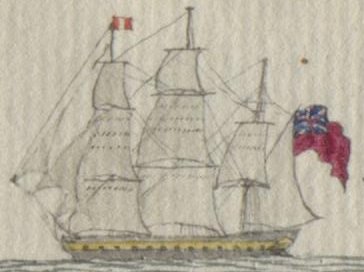
Vignette of the ship Dover Castle
|
True Briton: voyage 1804-1805; Georgiana: voyage 1803-1807. |
|
|
| Dover Castle |
misc |
A sloop noted in the journal of the Bridgewater on Tuesday 2nd June 1829 at Saugor. She was employed transporting cargo from Calcutta to the ship at Saugor. |
Bridgewater: voyage 1828-1830. |
|
|
| Druid |
Royal Navy |
Launched at Bristol in 1783, 717 tons with armament of 32. Described as Hermione class fifth rate frigate. See: https://sites.rootsweb.com/~pbtyc/18-1900/C/01156.html, for more details of her history. Converted into a troop ship in 1798. She was broken up in 1813. See under Wikipedia for details. |
Northampton: voyage 1807-1809. |
|
|
| Dubuc |
misc |
She was captured, presumably from the French, in 1797 and sold as a merchantman, firstly as a west indiaman and then as a whaler. She was on her way back to England under Captain Jonathan Taylor from New Holland when noted in the log of the Georgiana as arriving at St Helena on 27th February 1806. She went on to make three more whaling trips before being condemned at Hobart in 1807 and towed to Kangaroo Bay and scuttled. See Wikipedia for her history.
|
Georgiana: voyage 1803-1807. |
|
|
| Duchess of Athol |
HEICS |
Built 1821. 166ft long, 1330 tons. Sailed to China at least 6 times. Noted by Captain Rawes of the Warren Hastings on her third voyage, under Captain Edward M Daniell. |
Warren Hastings: voyage 1825-1826. |
|
|
| Duchess of Gordon |
HMS |
An HEICS ship but not listed by Farrington under that name. Acquired by the Royal Navy in 1805; on 26th Nov to 12th Jan 1806 she took part in a campaign to wrestle the Capt of Good Hope from the Dutch. On 4th March 1806 she helped to capture the French frigate Volontaire. She was disposed of in 1806. See https://sites.rootsweb.com/~pbtyc/18-1900/C/01156.html . |
Lady Jane Dundas: voyage 1805-1807. |
|
|
| Duke of Buccleugh |
HEICS |
Built by Randall 1788, length 161ft, 1182 tons. Six recorded trips to China, the last in 1801-2 ending at Long Reach. The Northampton drew up alongside her at Lower Tier, Deptford on 1st April 1803. |
Northampton: voyage 1801-1803. |
|
|
| Duke of Gloucester2 |
HEICS |
Built by Batson, launched 1763, 657 tons. She made four voyages under the HEICS, the last being in 1771. Noted in the Journal of the Solebay as at Batavia on Sunday 7th April 1765, her commander was Captain Richard Burdett. |
Solebay: voyage 1764-1765. |
|
|
| Duke of Montrose |
HEICS |
Built by Randall, launched 1784, length 143ft, 762 tons. She made eight voyages to India and China. On 13th June 1807 she was noted by Captain Lindsay of the Lady Jane Dundas as at St Helena. She was noted by Captain Jones of the Earl St Vincent on her eighth and by Captain Sanders of the Northampton on her last voyage, commanded by Captain John Paterson. |
Earl St Vincent: voyage 1806-1807; Lady Jane Dundas: voyage 1805-1807; Northampton: voyage 1807-1809. |
|
|
| Duke of Portland |
misc |
A whaler noted in the log of the Georgiana as arriving at St Helena on 15th April 1805. She sailed for England on 20th April 1805. |
Georgiana: voyage 1803-1807. |
|
|
| Duke of Richmond |
HEICS |
Built by Perry, launched 1760, length 137ft, 767 tons. Four voyages to the Far East are record. Noted in the Journal of the Solebay as at Batavia on 30th May 1765, initially commanded by Captain Benjamin Godfrey but subsequently commanded by the 2nd mate Thomas Hindman. Benjamin Godrey died on the voyage 1st February 1765. |
Solebay: voyage 1804-1805. |
|
|
| Duke of Sussex |
HEICS |
Built by Thames Shipbuilding Co, launched 14 Dec 1826, length 166ft, 1336 tons. Made at least four voyages to China. Noted in the journal of the Bridgewater at Whampoa on Monday 30th November 1829 where they exchanged bales of cotton. Noted by Captain Gribble of the Repulse on her third voyage under Captain Walter Horrocks Whitehead. Her crew and passenger list on the 1831/2 voyage has been published under www.shadowsoftime.co.nz/dukesussex.html. |
Bridgewater: voyage 1828-1830; Repulse: voyage 1831-1832. |
|
|
| Duke of Wellington |
misc |
A schooner out of London noted in the English Channel by Captain Rawes of the Warren Hastings on 7th May 1825, nothing else known. |
Warren Hastings: voyage 1825-1826. |
|
|
| Duke of York |
HEICS |
Built by Wigram 1817, 166ft long, 1327 tons. Sailed to China at least 9 times. Noted in the journal of the Bridgewater as arriving at Saugor on Wednesday 20th May 1830, her commander was Captain Robert Locke. On the 21st May 1833 she was on her fifth voyage, under Captain Robert Locke and was sailing between Madras and Calcutta when she was driven on shore by a hurricane and condemned at Calcutta on 6th Jun 1833. |
Warren Hastings: voyage 1825-1826; Vansittart: voyage 1826-1828; Bridgewater: voyage 1828-1830. |
|
|
| Duncan |
HEICS |
Not to be confused with the Lord Duncan. It is assumed that she was a 'Country' ship. She arrived at Bombay from Penang on Saturday 10th January 1807.
|
Huddart: voyage 1806-1807. |
|
|
|
E |
| Eagle |
misc |
Noted in the log of the Georgiana as arriving at Simons Bay, South Africa as a private ship from Table Bay on 28th July 1806.
|
Georgianas: voyage 1803-1807. |
|
|
| Earl Camden |
HEICS |
Built by Pitcher and launched 1802, length 166ft, 1271 tons. Made four voyages to the Far East. Nu her first, under Captain Nathaniel Dance, she was recorded by the Wexford at Whampoa on 6th November 1803. On Monday 6th May 1805, under Captain Henry Morse Samson, she was in the Northern Atlantic on her way to the East. Before September 1810 she was destroyed by fire while on her fourth voyage. |
Wexford: voyage 1803-1804; Cumberland: voyage 1805-1806; Ganges: voyage 1805-1807. |
|
|
| Earl Howe |
HEICS |
Built by Batson, launched 1794, length 146ft, 876 tons. Sailed to the East at least eight times. Noted in the log of the Georgiana as arriving at St Helena on 8th March 1804 on her return voyage to England. She departed in convoy on 1st April. Her commander was Captain Robert Burrowes. On her fifth voyage, under Captain Andrew Murray, Captain Harington of the Ganges noted her at Whampoa on Saturday 15th February 1806 and Captain Farrer of the Cumberland noted her in the Indian Ocean on Tuesday 6th May 1806. She was noted by the Lord Keith on her seventh voyage to the east and was returning home under her commander Captain John William Eastfield. On her sixth, under Captain Murray she was recorded by Captain Sanders of the Northampton as at Madras on Wednesday February 17th 1808.Her last recorded voyage was in 1812. |
Georgiana: voyage 1803-1807; Cumberland: voyage 1805-1806; Ganges: voyage 1805-1807; Lord Keith: voyage 1810-1811; Northampton: voyage 1807-1809. |
|
|
| Earl of Abergavenny |
HEICS |
Built by Pitcher and Launched 1796, length 176ft. Second of that name, she made 5 voyages to the East. On her fourth, under Captain John Wordsworth, she was recorded by the Wexford as at Whampoa on 11th November 1803. She was lost on the Shambles 5th Feb 1805 shortly after leaving port. |
Wexford: voyage 1803-1804. |
|
|
| Earl of Elgin |
HEICS |
Built by Perry, launched 1760, 687 tons. Recorded as making four voyages to the Far East. Noted in the Journal of the Solebay as leaving Batavia on Saturday 4th May 1765, commanded by Captain Thomas Cooke. Her last voyage was in 1770.
|
Solebay: voyage 1804-1805. |
|
|
| Earl of Middlesex |
HEICS |
Built by Perry, launched 1763, 657 tons. She made three voyages under the HEICS, the last being in 1771. Noted in the Journal of the Solebay as at Batavia on Sunday 7th April 1765, her commander was Captain Sir Henry Fletcher, later a Director of the HEICS. She sailed from Batavia on Saturday 13th April 1765. |
Solebay: voyage 1764-1765. |
|
|
| Earl Spencer (2) |
HEICS |
Built 1795, length 135ft, 644 tons. 6th trip to India. Second ship of that name. Noted in the log of the Georgiana as arriving in convoy at St Helena on 31st December 1804. She departed in convoy for England on 13th January 1805. Her commander was Captain George Heming when taken in tow just off Madeira on Wednesday 11th July 1810. Her last recorded voyage was this voyage of 1810. It is possible that she was the slave ship of the same name, which transported convicts from England to Australia in 1813, although this Earl Spencer was apparently built in 1803 and weighed 672 tons. |
Georgiana: voyage 1803-1807; Lord Keith: voyage 1810-1811. |
|
|
| Earl St Vincent |
HEICS |
Built by Barnard, measured 1799, length 146ft, 808 tons. Noted in the journal of the True Briton as arriving off the Isle if Wight from the Downs on the 22nd April 1804, under her Captain John Brook Samson. There are seven recorded trips to the East and under Captain Charles Jones her journal was transcribed and the results found elsewhere on this site. Noted on 15th March 1807 by Captain Lindsay of the Lady Jane Dundas as at Point de Galle. Her interest here is the saving of the crew and passengers of the Ganges when she foundered off the Cape of Good Hope in May 1807. Captain Harrison noted the Earl St Vincent arriving at Bombay on 19th August 1906. She was also noted by Captain Bayliff of the Huddart. Her 7th was the last recorded in 1812.
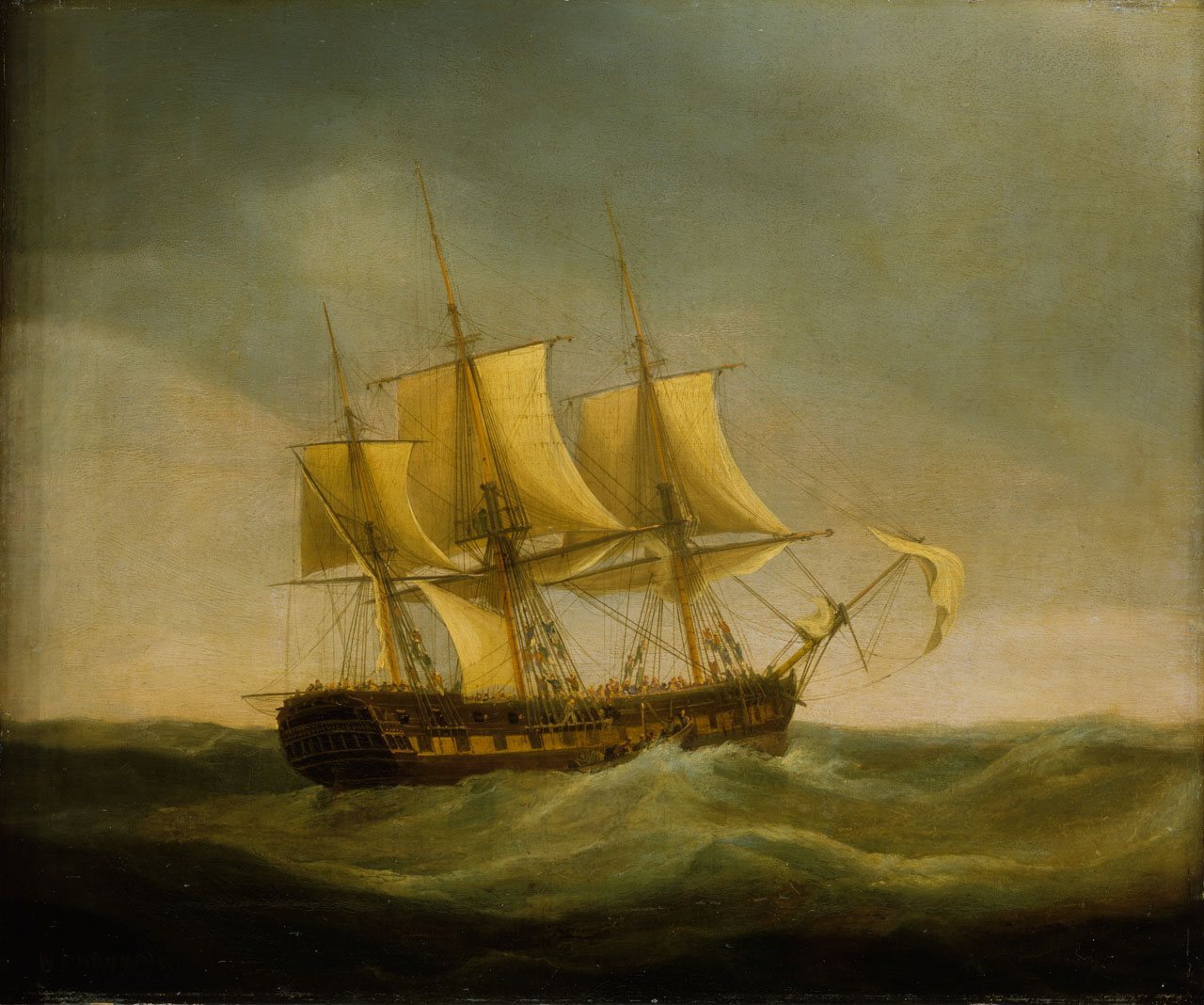
Painting depicting the Earl St Vincent rescuing the crew and passengers of the Ganges.
Painted by William John Huggins in 1807, original held by the Royal Maritime Museum.
|
True Briton: voyage 1804-1805; Lady Jane Dundas: voyage 1805-1807; Ganges: voyage 1805-1807; Huddart: voyage 1806-1807. |
|
|
| Eclipse |
misc |
Steam boat, used as a tug boat at Blackwall to bring in the ships on Saturday 12th June 1824. See under Wikipedia 'Thames Steamers', for more information on early steam boats. |
Warren Hastings: voyage 1823-1824. |
|
|
| Edgar |
Royal Navy |
Built at Woolwich, launched 30th June 1779, 3rd rate, 74 guns. Saw service in the American War of Independence, the French Revolutionary and Napoleonic Wars. Captain Farrer of the Cumberland mentioned her off the Kent coast on Wednesday 3rd September 1806 when her Captain pressed a number of the Cumberland's crew. In 1811 she was laid up at Chatham and in 1813 she was converted into a prison hulk being renamed the Retribution in 1815. She was broken up in 1835. See https://en.wikipedia.org/wiki/HMS_Edgar_(1779) for her history. |
Cumberland: voyage 1805-1806. |
|
|
| Edward Barnett |
HEICS |
A sloop carrying cotton for the Company noted in the journal of the Bridgewater on Wednesday 13th May 1829 at Saugor and again on Thursday 4th June 1829. Also noted by Captain Gribble of the Repulse at Saugor on Thursday 16th June 1831. |
Bridgewater: voyage 1828-1830, Repulse: voyage 1831-1832. |
|
|
| El Corso |
Royal Navy |
Apparently a sloop. There are several references to El Corso, one being from Google Books El Corso from 1799. In the Northampton's log under the crew list is written that on the 24th Dec 1808, 15 of the crew were delivered over to the El Corso at Gravesend. They had joined the ship at Calcutta on 1st June 1808. |
Northampton: voyage 1807-1809. |
|
|
| Eliza |
misc |
An American brig noted in the log of the Georgina as arriving at St Helena on Monday 22nd July 1805, carrying a 'Flag of Truce' from the Cape of Good Hope. She set sail back to the Cape of Good Hope on 11th August. The log of the Georgiana later recorded on 14th November 1805 that 'Anchored the Eliza (cartel) brig from the Cape of Good Hope with the officers & crew of the H.C. ship Brunswick taken in India by Admiral Lenois'. She is noted again in the log as an American brig called Eliza at Cape Town when the Georgiana arrived there on Monday 12th May 1806. This Eliza may be the same American brig. She may also be the American Brig noted in Wikipedia as being wrecked at Figi in 1808. This Eliza was 'constructed and registered' at Providence, Rhode Island, but there are other possibilities. She is noted again in the log of the Georgiana as a whaler arriving at St Helena from Delagoa Bay (Mozambique) on 8th December 1805. | Georgiana: voyage 1803-1807. |
|
|
| Eliza |
misc |
A whaler noted in the Log of the Wexford as in the Atlantic on 5th July 1804. She may be the ship Eliza launched at New Brunswick in 1789 weighing about 230 tons, see https://en.wikipedia.org/wiki/Eliza_(1789_ship). |
Wexford: voyage 1803-1804. |
|
|
| Eliza Ann |
HEICS |
Built in India 1795, 500 tons. Recorded as making five voyages from India to England. Noted as a country ship log of the Georgiana as arriving at St Helena on 28th June 1804, under Captain Mungo Gilmore. She departed on 8th July. On 22nd August 1804 she had an engagement with the French privateer La Venus and captured her. She was wrecked on the coast of Hainan, China in 1807. |
Georgiana: voyage 1803-1807. |
|
|
| Elizabeth lighter |
misc |
A lighter recorded by Captain Barker of the Northampton on Monday 11th April 1803 while unloading at Deptford. |
Northampton: voyage 1801-1803. |
|
|
| Elizabeth hoy |
HEICS |
A hoy noted in the Journal of the True Briton as coming alongside at Longreach on Monday 23rd September 1805. |
.
True Briton: voyage 1804-1805. |
|
|
| Elliot |
misc |
A whaler noted in the log of the Georgiana as arriving at St Helena on 12th January 1806. She first appears in the Lloyds Register in 1783 as a slaver based at Liverpool. She made ten voyages. Between 1803 to 1806 she was a whaler. Noted in the log of the Georgiana as arriving at St Helena [from the South Seas] on 12th January 1806 along with the whaler Perseverance.. In 1807 she became a merchantman with Letters of Marque. She was captured by the French in 1809. See Wikipedia for further information. |
Georgiana: voyage 1803-1807. |
|
|
| Elphinstone |
HEICS |
Built by Randall, launched 1802, length 167ft, 1274 tons. She made six voyages to the Far East. She was noted in the log of the Georgiana as arriving at St Helena on Sunday 4th November 1804. Her commander was Captain Milliken Craig. She sailed for England on 8th November 1804, however this appears to be a mistake as she was noted in the same log as still there on the 3rd December and sailing on the 7th for England. Noted by the Lady Jane Dundas on 2nd April 1806 as part of the outward bound Convoy. On 25th July 1806 Captain Harington noted the Elphinstone at Bombay. Her last recorded voyage was in 1816/7 when she was destroyed by fire at Whampoa on 12th Feb 1817. |
Georgiana: voyage 1803-1807; Ganges: voyage 1805-1807; Lady Jane Dundas: voyage 1805-1807. |
|
|
| Endeavour |
misc |
A sloop recorded by Captain Dalrymple at Saugor as coming alongside for private trade on 6th July 1827. Not traced. |
Vansittart: voyage 1826-1828. |
|
|
| Essex (5) |
HEICS |
Built by Perry, launched 1802, 165ft long, 1257 tons. Sailed to China at least 7 times. Noted in the log of the Georgiana as arriving at St Helena on 4th November 1804. Her commander was George Bonham. She was noted in the same log as sailing on 7th December 1804. She was noted on her second voyage by the Earl St Vincent, under Captain George Bonham and again by the Warren Hastings, under Captain Richard Nisbet. Noted by Captain Lindsay of the Lady Jane Dundas at Portsmouth on 4th March 1806 as part of the outward bound convoy. |
Georgiana: voyage 1803-1807; Lady Jane Dundas: voyage 1805-1807; Earl St Vincent: voyage 1806-1807; Warren Hastings: voyage 1815-1816. |
|
|
| Essex |
misc |
An American ship noted in the log of the Georgiana as arriving at St Helena on 7th March 1805. There are two American ships mentioned in Wikipedia, one an American warship based in the Mediterrean at the time, the other was a whaler which could be our ship although the log usually states 'whaler'. She sailed from St Helena on 11th March. |
Georgiana: voyage 1803-1807. |
|
|
| Eulos / Aeolus |
misc |
An apparent American ship noted in the log of the Georgiana as arriving at St Helena from China on 29th December 1805. See Wikipedia for other ships of the name.
|
Georgiana: voyage 1803-1807. |
|
|
| Europe (2) |
HEICS |
Built by Perry, launched 1802, length 146ft, 824 tons. Six voyages to India are recorded between 1803 and 1817. Noted in the log of the Georgiana as arriving at St Helena on 13th August 1804, under Captain William Gelston. She sailed on the 11th September. She was noted again as arriving at The Cape in convoy from the East on 30th December 1806. On 2nd February 1807 she was noted in the log of the Georgiana as leaving St Helena in convoy for England. She was last listed in 1824.
|
Georgiana: voyage 1803-1807. |
|
|
| Eurydice |
Royal Navy |
Launched at Portsmouth 1781, 5th rate, armament 34, 521 tons. Noted by Captain Barker of the Northampton. She was finally broken up at Deptford in March 1834. See: www.pbenyon.plus.com/18-1900/N/03341.html, and Wikipedia for her history of her long and successful service. |
Northampton: voyage 1801-1803. |
|
|
| Euthrates |
HEICS |
Built in Newcastle, launched 1803, length 127ft, 596 tons. Five voyages to the East are recorded. In the log of the Georgiana she is described as an extra ship when arriving in convoy at St Helena on 31st December 1804. She departed in convoy for England on 13th January 1805. She returned to the Island with stores on 13th December 1805 commanded by Captain George Welstead. She sailed for the Cape on 28th January 1806. She was wrecked of the coast of Ceylon on 1st January 1813, all aboard were saved. See Wikipedia. |
Georgiana: voyage 1803-1807. |
|
|
| Exeter (2) |
HEICS |
Built by Wells, launched 1792, length 165ft, 1265 tons. This was her 5th voyage, under Captain Henry Meriton. She was recorded by the Wexford as at Whampoa on 11th November 1803. Captain Harington of the Ganges recorded on Saturday 22nd February 1806 when her carpenter came on board at Whampoa to inspect a leak. Her commander was Captain Henry Meriton when Captain Farrer of the Cumberland recorded her on 16th October 1805 as part of the fleet leaving Penang under the Escort of HMS Blenheim. On 18th June 1811, while at St Helena, Captain Campbell of the Lord Keith described her as a Store ship. Her last recorded voyage was in 1810 under Captain James Timbrell. See Wikipedia> for a full history of this ship. |
Wexford: voyage 1803-1804; Cumberland: voyage 1805-1806; Ganges: voyage 1805-1807; Lord Keith: voyage 1810-1811. |
|
|
| Experiment (2) |
HEICS |
Launched at Stock-upon-Tees 1798. She is recorded by Farrington as sailing to India under the HEICS flag in late 1800 and return Spring 1802. In 1803 she transported convicts (two males and 136 females - 6 females died on the voyage) to Port Jackson, Sydney, Australia. She left Port Jackson bound for China on 7th October 1804. Captain Hughes of the True Briton records her as at Whampoa and setting sail for England on Sunday 20th January 1805, her commander was Captain Francis J Withers. Wikipedia records that on this voyage she was captured by the French and then recaptured. In 1818/9 she was condemned while at Batavia and sold for breaking.
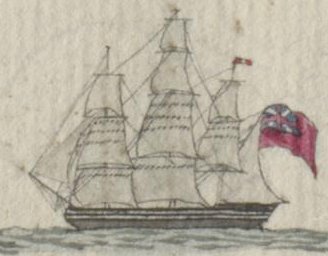
Vignette of the ship Experiment
|
True Briton: voyage 1804-1805. |
|
|
| Experiment (4) |
HEICS |
Built by Wells, launched 1802, length 124ft, 549 tons. Four voyages are recorded. Noted in the journal of the True Briton as arriving at the Motherbank from the Downs on Sunday 20th May 1804, commanded by Captain Peter Campbell. On her third voyage, under Captain James Normand, she was noted by Captain Harington of the Ganges at Bombay on Tuesday 7th October 1806. On Tuesday 7th October 1806 she was described by Captain Jones of the Earl St Vincent as an 'Extra' ship which arrived at Bombay on Tuesday 7th October 1806 and left for England on Sunday 21st December 1806. On 28th October 1808 on her fourth voyage, under Captain John Logan, she parted company from the fleet along with another East Indiaman (the Glory) and disappeared in a gale 28th Oct. 1808 in 8o 30'S by 80'E and was not heard of again. See https://en.wikipedia.org/wiki/Experiment_(1802_EIC_ship) and http://www.wrecksite.eu/wreck.aspx?139110" for her history.
John Logan was born in Clackmannan, Scotland 22 Jul 1762 and had a long career as seaman and Captain. |
True Briton: voyage 1804-1805; Ganges: voyage 1805-1807; Northampton: voyage 1807-1809; Earl St Vincent: voyage 1806-1807. |
|
|
|
F |
| Fame (3) |
HEICS |
Built by Perry at Bristol, repaired 1802, length 118ft, 492 tons. Three voyages are recorded of which second was noted in the Journal of the True Briton as sailing with the Convoy from St Helena back to England, her commander being Captain John Valentine Baker. On her third, under Captain John Valentine Baker. Noted by Captain Jones of the Earl St Vincent in the English Channel on 31st March 1806. On 18th Sept 1806 Joseph Marshall joined the ship Fame from the Ganges as Surgeon by approbation of Government. On 24th September 1806 while on her way to Bengal she was captured by the French frigate Piedmontaise.
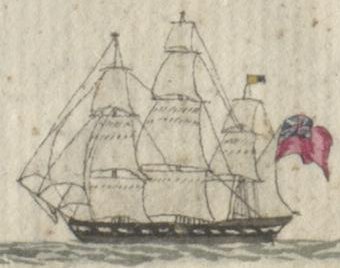
Vignette of the ship Fame
|
True Briton: voyage 1804-1805; Ganges: voyage 1805-1807; Earl St Vincent: voyage 1806-1807. |
|
|
| Fame |
Royal Navy |
Built at the Royal Navy dockyard at Deptford, launched 8th October 1805, as a 74 gun 3rd rate ship of the line, length 175ft 1745 tons. She was noted by Captain Lindsay of the Lady Jane Dundas at Portsmouth on the 4th March 1806 as part of the Royal Navy escort for the outbound Convoy of East India Company ships until at least near La Palma when on the 24th March 1806 when she possibly turned back. She was broken up in 1817.
|
Lady Jane Dundas: voyage 1805-1807. |
|
|
| Fame |
misc |
A Portuguese ship noted in the log of the Georgiana as arriving at St Helena from Bengal on 3rd March 1805. This may be the Fame was Launched in India in 1786, length 103ft, 306 tons. She was sold to a Portuguese owner but was then captured by the French, then by the British with a varied history as a slaver, see Wikipedia for the history of this Fame. The time scale between voyages suggests that we may be dealing with two ships.
|
Georgiana: voyage 1803-1807. |
|
|
| Farquharson |
HEICS |
Built by Gordon of Deptford 1820. Length 166ft, 1326 tons. Made at least seven voyages to China. Noted by Captain Rawes of the Warren Hastings on her second, under Captain William Cruickshank, as arriving at Whampoa on 15th Sept 1823, along with the Company ship Kent. She was also noted by Captain Dalrymple of the Vansittart in 1826-28, by Captain Manderson of the Bridgewater as arriving at Saugor on Tuesday 19th May 1829 and by the Repulse in 1831/32. She was sold in 1834 for £6000. Apparently the ship's plans survive and are stored at the Royal Museum at Greenwich, see: collections.rmg.co.uk/collections/objects/384457.html. |
Warren Hastings: voyage 1823-1824; Vansittart: voyage 1826-1828; Bridgewater: voyage 1828-1830; Repulse: voyage 1831-1832. |
|
|
| Favourite |
misc |
A schooner noted in the log of the Georgiana as arriving at St Helena from the Cape of Good Hope on 30th August 1805. On 17th December an American schooner called Favourite arrived at St Helena from the Cape, it is believed this is the same schooner. |
Georgiana: voyage 1803-1807. |
|
|
| Favourite |
misc |
A whaler noted in the log of the Georgiana as arriving at St Helena on 6th March 1805. Noted in the same log as arriving again on 31st January 1806.
|
Georgiana: voyage 1803-1807. |
|
|
| Favourite |
misc |
Steam boat, used as a tug boat at Blackwall to bring in the ships, noted on Saturday 12th June 1824 by Captain Rawes of the Warren Hastings and by Captain Dalrymple of the Vansittart at Blackwall on 9th June 1828. See under Wikipedia 'Thames Steamers', for more information on early steam boats. |
Warren Hastings: voyage 1823-1824; Vansittart: voyage 1826-1828. |
|
|
| Fenton & Hay-Master |
misc |
On 3rd January 1806 while preparing to sail from Blackwall the Fenton & Hay-Master came athwart and carried away the Lady Jane Dundas' sprit sail yard. |
Lady Jane Dundas: voyage 1805-1807. |
|
|
| Fergussan |
HEICS |
Ship not traced, she was noted in the journal of the Bridgewater as at Whampoa on Wednesday 30th September 1828. |
Bridgewater: voyage 1828-1830. |
|
|
| Ferret |
misc |
A whaler noted in the log of Georgiana on Friday 23rd September 1803 when in the Atlantic she parted company with the convoy on their voyage to St Helena on beyond. She had joined the convoy at Mother Bank, Isle of Wight in August. She appears agin in the same log on 24th December 1805 on arriving at Helena from Port Jackson, Australia. She was also recorded by Captain Sanders of the Northampton at St Helena on Wednesday September 28th 1808. In 1807 she was reported at Hobart handing over despatches, see Google Books. There is another mention of the Ferret "in the Sydney Gazettes of May 15 1808 - December 31 1809 - Volumes V1 & V11 (arrived from the fisheries) and January 7 1810 - December 29 1810 - Volume V111. |
Georgiana: voyage 1803-1807: Northampton: voyage 1807-1809. |
|
|
| Fily |
misc |
A brig noted but not named by Captain Jones on Saturday 20th June 1807 as setting sail under convoy from St Helena for England. Captain Lindsay of the Lady Jane Dundas noted her and recorded her name as Fily on the 27th June 1807, otherwise not traced. |
Lady Jane Dundas: voyage 1805-1807. |
|
|
| Financer |
misc |
An American ship noted in the log of the Georgiana as arriving at St Helena from Batavia on Tuesday 15th May 1804. |
Georgiana: voyage 1803-1807. |
|
|
| Fly |
Royal Navy |
A brig of a 100 tons recorded by Captain Sanders of the Northampton at St Helena on Wednesday September 28th 1808. The Fly-class brig was launched 24th October 1805. Captain Sanders recorded that she had to be towed from St Helena all the way back to England by the Sarah Christiana. She was wrecked off Anholt island off Denmark on 28th February 1812. See Wikipedia for further information. |
Northampton: voyage 1807-1809. |
|
|
| Fortitude |
misc |
Launched in Calcutta in 1804, 500 tons. Noted in the log of the Georgiana as arriving at St Helena on 28th August 1806. She had been carrying a large quantity of Chinese to Trinidad as indentured labour. She sailed for Trinidad with her 'Chinese settlers' (described as a country ship), on 10th September 1806. She later got into trouble with the British authorities. She was apparently lost in or about 1812. See Wikipedia for more details. |
Georgiana: voyage 1803-1807. |
|
|
| Fortune |
misc |
A Swedish ship noted by Captain Lindsay of the Lady Jane Dundas as at St. Helena and sailing with the Convoy towards England. |
Lady Jane Dundas: voyage 1805-1807. |
|
|
| Fox |
misc |
A whaler noted in the log of the Georgiana as arriving at St. Helena on 1st August 1805. |
Georgiana: voyage 1803-1807. |
|
|
| Friends hoy |
HEICS |
A hoy or barge noted by Captain Rawes of the Juliana at Blackwall on 2nd April 1812. |
Juliana: voyage 1812-1813. |
|
|
| Fury |
HEICS |
A Company 'Pacquat' that arrived at Bombay from Buccorah (Basra) on Thursday 15th January 1807.
|
Earl St Vincent: voyage 1806-1807. |
|
|
|
G |
| Ganges |
misc |
Noted in the Journal of the True Briton as sailing with the Convoy from St Helena back to England on 12th July 1805. It is not certain which ship this was. Her size illustrated on one of the sheets in Journal suggests tonnage of under 600 tons. The HEICS Company ship Ganges 3, a large ship, appears to have left St Helena in June 1805.
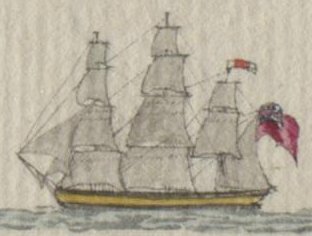
Vignette of the ship Ganges
|
True Briton: voyage 1804-1805. |
|
|
| Ganges (3) |
HEICS |
Built by Wells and launched 1797. Length 181ft, 1502 tons. Four voyages to the Far East are recorded by Farrington of which this was her 3rd, commanded by Captain William Moffat. She was noted in the Log of the Wexford on 3rd February 1804, and again on Sunday 25th March 1804 when she sprung fore top mast after which she was towed to maintain the Convoy's speed. She was shortly to be involved in the Battle of Pulo Aura, see The Ganges, East Indiaman by W. J. Huggins, in Bulletin of the Victoria Memorial Calcutta, 8 (1974) pp.21-23, illus. On Sunday 11th January 1807 she was on her way back to England and was spotted at Bombay by Captain Bayliff of the Huddart. On Friday 16th January 1807 Captain Jones of the Earl St Vincent describes her as a Company ship at Madras as "run down below the Middle Ground". Noted on 15th March 1807 by Captain Lindsay of the Lady Jane Dundas as at Point de Galle. On 29th May 1807 on her return voyage and being in danger of going under she was shadowed by the Earl St Vincent and finally on 29th May 1807 sank off the Cape of Good Hope with no loss of life. Captain Bayliff records on Tuesday 6 June while at St Helena the following: "Arrived the Earl St Vincent with the crew and passengers on board belonging to the Ganges, which ship had become in so bad a state that it was found necessary to quit her. She sank in sight of the Earl St Vincent the day after her being quitted - no lives lost." See The Ganges, East Indiaman by W. J. Huggins, in Bulletin of the Victoria Memorial Calcutta, 8 (1974) pp.21-23, illus.
|
Wexford: voyage 1803-1804; Lady Jane Dundas: voyage 1805-1807; Earl St Vincent: voyage 1806-1807; Huddart: voyage 1806-1807. |
|
|
| Ganges |
HEICS |
A barge or river boat at Deptford and Northfleet. On 26th July 1801 at Deptford Captain Barker of the Northampton came alongside the Ganges Barge with Cordage on Acct of the Hon Company. Noted by Captain Campbell of the Lord Keith at Northfleet when he came alongside with a consignment of Company iron |
Northampton: voyage 1801-1803; Lord Keith: voyage 1810-1811. |
|
|
| Ganges |
HEICS |
A steam boat at Saugor recorded by Captain Dalrymple of the Vansittart on Thursday 7th June 1827, used on this occasion to disembark troops. |
Vansittart: voyage 1826-1828. |
|
|
| Ganges |
----- |
This Ganges was noted in the log of Georgiana as departing from St Helena on 26th Feb. 1804. She appears to have been a 'prize' and may have been the ship noted in the log of the True Briton. |
Georgiana: voyage 1803-1807. |
|
|
| General Harris |
HEICS |
Built 1812, 165ft long, 1200 tons. Recorded as sailing to China nine times. Sailed to China at least nine times. On 13th October 1815 she was noted at Whampoa by Captain Rawes of the Warren Hastings and commanded by Captain George Welstead. On 21st March 1819 she was noted, again by Captain Rawes, off the Isle of Wight. On 11th April 1828 she was noted by the Vansittart at St Helena, again commanded by Captain Welstead. Sold for scrap to Joseph Christall 20th Oct. 1831 for £6600. |
Warren Hastings: voyage 1815-1816; Warren Hastings: voyage 1819-1820; Warren Hastings: voyage 1823-1824; Vansittart: voyage 1826-1828. |
|
|
| General Kyd |
HEICS |
Built Calcutta 1813. 1286 tons. Made at least nine voyages to China, one from India. She was noted by Captain Rawes of the Warren Hastings as arriving at Whampoa on 18th November 1815, under her commander Captain Alexander Nairne. She arrived at Penang on 23rd August 1819. Noted at Macao on 13th September 1823; in the journal of the Bridgewater at Northfleet on 20th December 1828; also at Whampoa on 17th Sept 1831. |
Warren Hastings: voyage 1815-1816; Warren Hastings: voyage 1819-1820; Warren Hastings: voyage 1823-1824; Warren Hastings: voyage 1825-1826; Bridgewater: voyage 1828-1830. Repulse: voyage 1832-1832. |
|
|
| General Stewart |
HEICS |
Also called Stuart. Built by J. Dudman of Deptford and launched on 27th June 1801, length 134ft and weighed about 600 tons. She made seven voyages to the Far East between 1801 & 1814 for the Company and was styled and 'Extra ship'. First voyage to India out of seven recorded by Farrington, commanded by Captain Robert Abbon Marsh, recorded in the log of the Northampton. Her third was commanded by Captain John Rogers. She set sail again 29th June 1804. Her commander was Captain Thomas Mortimer when she was noted in the Log of the Georgiana as having recently captured a French ship called Aurora. The Aurora arrived at St Helena on Sunday 27th November 1803 and departed for England in convoy on 13th August 1804. She was noted again in the same log as arriving at St Helena from Bencoolen on 10th April 1806. She left St Helena on 13th April 1806. There is an extensive history of the General Stuart on Wikipedia, which stated that in 1819 she was transporting convicts to New South Wales. She was last recorded in 1828. |
Northampton: voyage 1801-1803; Georgiana: voyage 1803-1807. |
|
|
| General Wellesley |
HEICS |
There is a General Wellesley recorded as being built in Calcutta and weighing 480 tons. Its only recorded voyage in Farrington is under the command of Captain J L Heathorn, sailing from Calcutta in 1813. The one mentioned in the journal of the Juliana states that a 'country ship' or ships called the General and Henry Wellesley sailed from Portsmouth with the Convoy on 7th May 1812. See under Henry Wellesley. |
Juliana: voyage 1812-1813. |
|
|
| George |
HEICS |
A hoy delivering stores to the Georgiana at Gravesend on Monday 1st of August 1803. |
Georgiana: voyage 1803-1807. |
|
|
| George Washington |
misc |
A sloop built at Providence, R.I., USA in 1793; purchased by Congress at Providence 12th October 1798. See Wikipedia for her history. She passed the Repulse on Thursday 8th March 1832. In the North Atlantic and noted as a brigantine of Providence out of Amsterdam. See also the Internet ships named George Washington. |
Repulse: voyage 1831-1832. |
|
|
| Georgian |
misc |
An American ship noted in the journal of the Bridgewater on Wednesday 7th April 1830 south of Madras and was 104 days out of Philadelphia. She may have been heading for Madras, otherwise not traced. |
Bridgewater: voyage 1828-1830. |
|
|
| Georgiana (1) |
HEICS |
Company's packet built by Wells, length 94ft, 285 tons. Her first recorded voyage was to Bengal in 1795 under Captain John Luard. Noted in the Journal of the True Briton as at St Helena on 12th July 1805, under Captain Henry Leigh. Her sixth was her last recorded voyage and was returning home under Captain Henry Leigh. She sailed from Bengal on 13th March and arrived at the 'Motherbank' [Isle of Wight] on 29th August 1811.
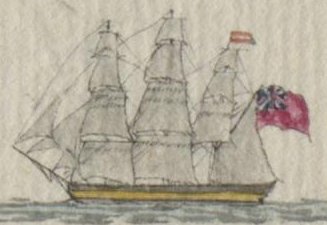
Vignette of the ship Georgiana
|
True Briton: voyage 1804-1805; Lord Keith: voyage 1810-1811. |
|
|
| Georgiana |
misc |
Built in Mexico 1800, 200 tons. She was captured in 1801 and became a whaler for Enderby & Sons. noted in the log of the Georgiana as a South Sea whaler which arrived at St Helena on 18th May 1805 on the way to the Pacific. She was returning to England on under Captain Charles Caesar Bristow. She then changed ownership and became a merchantman based at Curaçao. She was no longer listed after 1821. See Wikipedia for her history. |
Georgiana: voyage 1803-1807. |
|
|
| Glatton |
HEICS |
Built by Wells, launched 1796. length 176ft, 1432 tons. Noted in the log of the Georgiana as arriing in convoy from China at St Helena on 2nd April 1805. Noted in the Journal of the True Briton as part of a convoy sailing from St Helena on 12th July 1805 back home to England, her commander was Captain James Halliburton. On 17th October 1806 she was noted by Captain Lindsay of the Lady Jane Dundas as at Penang. This was her fifth voyage, under Captain James Halliburton, out of eight recorded. Her last recorded voyage was in 1815.
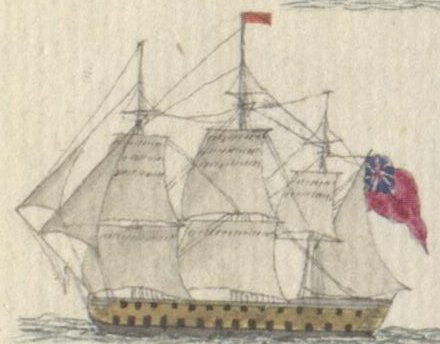
Vignette of the ship Glatton
|
Georgiana: voyage 1803-1807; True Briton: voyage 1804-1805; Lady Jane Dundas: voyage 1805-1807. |
|
|
| Glory |
HEICS |
An Extra ship repaired by Wells 1803, length 117ft, 502 tons. Three voyage to India. Noted in the log of the Georgiana as arriving at St Helena from Madras on 18th November 1804. Her colours were at half mast because the day before her commander Captain John Perry had died the day before. Captain John Perry (born 1772) died 17th November 1804. He had only recently assumed the position because of the death of the Glory's commander Captain Thomas Rumbold Taylor (born 1776) who had died the day 4th March 1804. She was noted again in the same log as arriving in convoy from the East at the Cape on 30th December 1806. On 2nd February 1807 she was noted in the log of the Georgiana as leaving St Helena in convoy for England. The Glory's last voyage in 1807 was under Captain Horatio Beevor. She pulled up alongside the Northampton and on Saturday 25th July 1807, while at Blackwall, the officers of the Glory were invited on board. She disappeared in a gale off Mauritius on 28th Oct 1808 in 8 o 30'S 80'E and was not heard of again. See Google Books for a mention of the Glory. Captain Beevor was born at St Saviour, Norfolk on 6 Oct 1773, the son of James and Mary. He left a wife Mary and three children. |
Georgiana: voyage 1803-1807; Northampton: voyage 1807-1809. |
|
|
| Goliath |
misc |
A brig noted in the journal of the Bridgewater on Friday 12th June 1829 at Saugor. She was employed transporting cargo from Calcutta to the ship at Saugor. |
Bridgewater: voyage 1828-1830. |
|
|
| Grampus |
Royal Navy |
Launched at Portsmouth on 20th March 1802, 4th rate, armament 50. She was escorting convoys to China in 1805. She was recorded by Captain Harington of the Ganges on Tuesday 12th August 1806 as leaving Bombay for China as an escort, along with HMS Dasher and Company ships Elphinstone, Winchelsea, Ceres & Walmer Castle. She was also noted by Captain Jones of the Earl St Vincent near Bombay on Monday 2nd February 1807, while she was escorting an East India Company convoy from China. See: https://sites.rootsweb.com/~pbtyc/18-1900/C/01156.html, for her history. She was disposed of in 1832. |
Ganges: voyage 1805-1807; Earl St Vincent: voyage 1806-1807. |
|
|
| Grant hoy |
HEICS |
A hoy or barge noted at Blackwall by Captain Rawes of the Julian on 3rd April 1812. |
Juliana: voyage 1812-1813. |
|
|
| Greyhound |
Royal Navy |
Launched at Mistleythorn 1783, 5th rate, armament 32, 682 tons, complement 212, 682 tons. Sailed for the East Indies in 1805. On 27th April 1805 she was recorded by Captain Farrer of the Cumberland as in the English Channel. On 30th May 1805 she was first noted by Captain Harington of the Ganges as part of the convoy in the Indian Ocean. He does however make a note on the 3rd May, and subsequently, of the 'Frigate', which is probably a reference to the Greyhound. An ambiguous reference by Captain Harington is "Signal to Cooke the Frigate", which may suggest that her commander at this time was a man called 'Cook'. On 1st September 1805 she was at Madras when James Brown of the Ganges surrendered himself up as a Deserter. On Tuesday 3rd September 1805 she set sail from Madras as an escort to Bengal with the Company ships Devonshire, Preston, Castle Eden & General Stewart. On 17th October 1806 she was noted by Captain Lindsay of the Lady Jane Dundas as at Penang. On 29th February 1808 she was recorded by Captain Sanders of the Northampton as arriving at Madras. Wrecked on the coast of Luconia, all saved except one, commanded by Captain Hon Wm Pakenham. See: https://sites.rootsweb.com/~pbtyc/18-1900/C/01156.html, for further information. |
Cumberland: voyage 1805-1806; Lady Jane Dundas: voyage 1805-1807; Ganges: voyage 1805-1807; Northampton: voyage 1807-1809. |
|
|
|
H |
| Hamadryad |
Royal Navy |
A Spanish ship named Matilda captured in 1804. She was renamed Hamadryad as a 5th rate, armament 36. 25th June 1811 at St Helena she was heading for England under Captain Sir T. Staines. Disposed of in 1815. See: https://sites.rootsweb.com/~pbtyc/18-1900/C/01156.html, for more information. |
Lord Keith: voyage 1810-1811. |
|
|
| Hanover |
misc |
An American ship that is recorded in the log of the Georgiana as departing St Helena in convoy on 1st April 1804. |
Georgiana: voyage 1803-1807. |
|
|
| Harmonie |
misc |
A ship of Bremen noted in the log of the Georgiana as arriving at Cape Town from Batavia on 21st June 1806. |
Georgiana: voyage 1803-1807. |
|
|
| Harmony |
misc |
A Brig from Boston to Janeiro, probably American. Noted by Captain Rawes of the Warren Hastings just north of St Helena on 22nd April 1816. |
Warren Hastings: voyage 1815-1816. |
|
|
| Harpy |
Royal Navy |
Brig/sloop, launched in 1796. Armament 18, complement 120. Captain Rawes of the Juliana recorded her as at Cape Town on 18th March 1813. She was involved in many actions, not least in the invasion of Java. See: https://sites.rootsweb.com/~pbtyc/18-1900/C/01156.html. She was disposed of in 1817. |
Juliana: voyage 1812-1813. |
|
|
| Harriet (3) |
HEICS |
Built by Perry, launched in 1802. Length 125ft, 550 tons. Six voyages to Bengal. Recorded in the log of the Georgiana as arriving at St Helena on Wednesday 15th Feb. 1804. Her commander was Captain William Lynch. She departed for England on 26th Feb. Noted again in the log of the Georgiana as at St Helena on 1st November 1805. She had arrived from India on 22nd October, and sailed for England on 4th November. Captain Jones of the Earl St Vincent records her as arriving at Point de Galle on Sunday 15th Mach 1807. She was also noted on 26th February 1807 by Captain Lindsay of the Lady Jane Dundas as leaving in convoy from Saugor to Point de Galle. Captain Harington of the Ganges records her as arriving at Point de Galle from Bengal on Sunday 15th March 1807. Noted by Captain Campbell of the Lord Keith at St Helena on 18th June 1811. She was burnt at Calcutta 15th October 1812. |
Georgiana: voyage 1803-1807; Ganges: voyage 1805-1807; Lady Jane Dundas: voyage 1805-1807; Earl St Vincent: voyage 1806-1807; Huddart: voyage 1806-1807.; Lord Keith: voyage 1810-1811. |
|
|
| Harriet hoy |
HEICS |
A hoy recorded in the journal of the True Briton at Blackwall on Wednesday 8th February 1804. |
True Briton: voyage 1804-1805. |
|
|
| Harriot |
HEICS |
Farrington only mentions one voyage of a ship called Harriot, built by Mackenzie and measured in 1795. Her voyage was between Dec 1793 and & Sep 1795, commanded by Captain John Luard.
Wikipedia has "Harriot, Harriet or Harriett Launched at Calcutta between 1793 & 1795 and stating that she made three voyages for the Company between 1796 & 1801". The entry includes much more information about her voyages and subsequent history. It is likely that her relationship with the Company was as a chartered vessel. In 1803 she was sold to Boehm & Co and is recorded by Wikipedia as trading for a number of years and only in 1818 commenced on a career as a whaler.
It is possible that we are dealing here with different ships with the same name. Our whaler was called Harriot and was noted in the log of the Georgiana as in convoy in the North Atlantic heading south on Monday 26th September 1803. She had joined the convoy at Motherbank in August 1803. |
Georgiana: voyage 1803-1807. |
|
|
| Havannah |
Royal Navy |
Built 1811, 5th Rate, 950 tons. Noted by Captain Rawes of the Warren Hastings at St Helena on 26th March 1816 along with HMS Northumberland. Disposed 1905. See website:- Royal Navy Havannah |
Warren Hastings: voyage 1815-1816. |
|
|
| Hawkesbury |
HEICS |
Built by Randall 1786, length 143ft, 803 tons. She made eight voyages to India. On her last, under Captain Samuel Smith she was recorded by Captain Sanders of the Northampton as a HEICS ship at Madras on Wednesday February 17th 1808. |
Northampton: voyage 1807-1809. |
|
|
| Hebe |
HEICS |
On 8th May 1823, Captain Rawes of the Warren Hastings recorded a brig called Hebe en route from Lanzarote to Yarmouth. Farrington lists a ship called Hebe, styled an 'Extra' ship, of 2 decks, length 116ft, weighing 413 tons, as on voyage to Bengal in 1809/10 under Captain Robert Johnson. There is also a painting by Welby Pugin of a brig called Hebe foundering on the Colombo Roads off Ceylon in 1852. It is likely that these references are of the same ship.
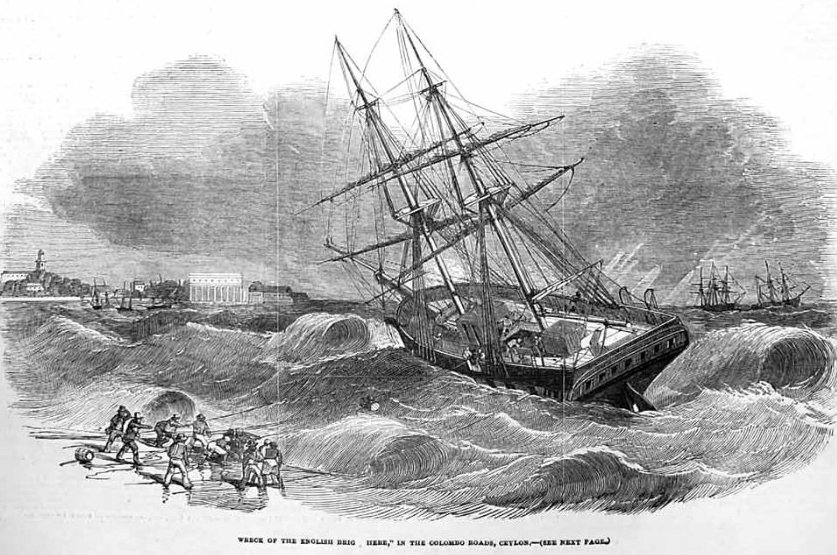
Image of Pugin's drawing of the Brig Hebe shipwreck.
|
Warren Hastings: voyage 1823-1824. |
|
|
| Hecata |
Royal Navy |
Launched in 1809, a sloop, armament 18. In 1811 she took part in the invasion of Java. Captain Rawes of the Juliana went on board her in the Sunda Straits on 31st January 1813 and recorded her commander as Captain Drury. She was purchased by the revolutionary government of Chile in 1817. See: https://sites.rootsweb.com/~pbtyc/18-1900/C/01156.html. |
Juliana: voyage 1812-1813. |
|
|
| Helen |
HEICS |
A Country ship noted in the journal of the Bridgewater as arriving at Toun-koo on Monday 14th December 1829. Nothing else known. |
Bridgewater: voyage 1828-1830. |
|
|
| Henrietta |
misc |
Commissioned in Bordeaux in late 1803, she served in the Bay of Biscay until mid-1804, and then in the Indian Ocean, based at Île de France (now Mauritius). The French privateer Henrietta captured a British merchant ship called James Sibbald between Bengal and Bombay, according to a Dutch newspaper Haagsche Courant dated 24 August 1805. HMS Powerful captured her off Ceylon in June 1806. Captain Jones of the Earl St Vincent records the French prize as arriving at Madras on Saturday 22nd November 1806 with HMS Albatross. |
Earl St Vincent: voyage 1806-1807. |
|
|
| Henry |
misc |
Not noted by Farrington. Recorded by Captain Rawes of the Warren Hastings as 'from Batavia' as arriving on the 29th March 1824. |
Warren Hastings: voyage 1823-1824. |
|
|
| Henry Addington |
HEICS |
Built by Wells and Launched 20th October 1800, length 165ft, 1252 tons. She made 7 voyages to the East. Her second was under Captain Thomas Wakefield when she was recorded by the Wexford as at Whampoa on 11th November 1803. In 1804, under Captain Kirkpatrick, she was one of the vessels involved in the Battle of Pulo Aura. On Tuesday 12th November 1805 she was reported by Captain Farrer of the Cumberland as being grounded near the Alike Islands in Indonesia, she was refloated and continued on her way. She was sold for breaking in 1815. |
Wexford: voyage 1803-1804; Cumberland: voyage 1805-1806, Ganges: voyage 1805-1807. |
|
|
| Henry Wellesley |
misc |
The Henry Wellesley is not listed by Farrington as a HEICS ship. There is however a slave ship called by this name listed on the Internet. She made several trips to Australia in the 1830's. |
Juliana: voyage 1812-1813. |
|
|
| Herculean |
HEICS |
She was built by Simon Temple at South Shields and launched 21 September 1799, length 121ft, about 610 tons, her owner was Robert Anderson. Noted in the log of the Georgiana on Tuesday 17th January 1804 as arriving at St Helena from Bencoolen, her commander was Captain John Robertson Franklin. She departed St Helena for England on 26th Feb. She foundered, along with other ships, on 23rd August 1806 on her return voyage to England from Jamaica in 'The Great Coastal Hurricane'. Information from Wikipedia. |
Georgiana: voyage 1803-1807. |
|
|
| Herefordshire |
HEICS |
Built 1814, 165ft long, 1279 tons. Sailed to China at least 11 times. Noted by the Repulse on her second voyage under Captain Charles Le Blanc; on her sixth voyage, under Captain William Hope; On her eighth voyage, under Captain John Claremont Whiteman by the Vansittart; noted in the journal of the Bridgewater as giving assistance to the Bridgewater at Whampoa on 10th August 1829; on her tenth voyage, under Captain William Hope by the Repulse. |
Warren Hastings: voyage 1815-1816; Warren Hastings: voyage 1823-1824, Vansittart: voyage 1826-1828; Bridgewater: voyage 1828-1830; Repulse: voyage 1831-1832. |
|
|
| Hero of Malone |
misc |
Noted by Captain Rawes of the Warren Hastings as arriving at Helena from Calcutta & the Isle de France [Mauritius] on 30th March 1824.. There is a reference to the ship in the 1830's on Trove, the Australian newspapers &c. website Trove. Another site Paperspast, records the ship in the 1840's. Both sites allude to voyages to Australia.
|
Warren Hastings: voyage 1823-1824. |
|
|
| Heroine |
HEICS |
Described by Captain Dalrymple as a Country ship arriving at Penang on Sunday 9th September 1827. Not traced but could have become a convict ship in the 1830's. |
Vansittart: voyage 1826-1828. |
|
|
| Hope (1) |
HEICS |
A hired packet noted in the log of the Georgiana as arriving at St Helena from Bengal to England on 12th November 1805, she sailed for England on 15th November 1805. |
Georgiana: voyage 1803-1807. |
|
|
| Hope (2) |
HEICS |
Built by Pitcher, launched 1797, length 177ft, 1471 tons. She made nine voyages to China. Her fifth was under Captain James Pendergrass. Captain Farrer of the Cumberland and Captain Harington of the Ganges recorded her on 16th October 1805 as part of the fleet leaving Penang under the Escort of HMS Blenheim. Her last voyage was in 1816, under Captain Pendergrass. Captain Farrer of the Cumberland recorded her on 16th October 1805 as part of the fleet leaving Penang under the Escort of HMS Blenheim. She was noted by Captain Rawes of the Warren Hastings as at Northfleet and preparing to sail on her last recorded voyage to the east with the Convoy on 19th March 1815. |
Cumberland: voyage 1805-1806, Ganges: voyage 1805-1807; Warren Hastings: voyage 1815-1816. |
|
|
| Horatio |
Royal Navy |
Launched 23 April 1807, 5th rate, armament 38, 1090 tons. Propulsion: sail - screw. On 21 Feb 1810 she captured a French frigate-built storeship called Nécessité. Much more history of her on: https://sites.rootsweb.com/~pbtyc/18-1900/C/01156.html. Disposed of in 1865. |
Lord Keith: voyage 1810-1811; Warren Hastings: voyage 1815-1816. |
|
|
| Howe |
Royal Navy |
Originally launched in 1799, length 150ft 1045 tons. A teak-built Indian merchant ship called Kaikusroo which Admiral Edward Pellew bought in 1805 to serve as a 40-gun frigate. See Wikipedia. She was noted in the log of the Georgiana as arriving at St Helena on Thursday 14th of November 1805. Her passenger was also noted in the log the Marquis of Wellesley to whom the Georgiana gave a 13-gun salute. Richard Colley Wellesley, 1760-1842, was the brother of the Duke of Wellington. She sailed for England on 20th November 1805 with the Marquis on board. In 1806 she was fitted out as a 24-gun store ship and renamed HMS Dromedary. She sailed to Australia and eventually became a prison ship in Bertmuda and in more recent times an archaeological site. |
Georgiana: voyage 1803-1807. |
|
|
| Huddart |
HEICS |
Built by Wells, launched 1802, length 124ft, 547 tons. Eight voyages to India are recorded. Noted in the log of the Georgiana as arriving at St Helena on 3rd March 1804, on her 1st voyage. She sailed for England on the 15th March. Noted again in the log on 1st November 1805 as at St Helena. She had arrived there on 22nd October from India. She sailed for England on 4th November. Noted on her third, under Captain Thomas Gabriel Bayliff Captain Harington of the Ganges and Captain Jones of the Earl St Vincent reported her arriving at Bombay on Sunday 11th January 1807. Noted on 15th March 1807 by Captain Lindsay of the Lady Jane Dundas as at Point de Galle. |
Georgiana: voyage 1803-1807, Ganges: voyage 1805-1807; Earl St Vincent: voyage 1806-1807; Lady Jane Dundas: voyage 1805-1807. |
|
|
| Hugh Inglis hoy |
HEICS |
A hoy recorded by Captain Barker of the Northampton on Tuesday 12th April 1803 while unloading at Deptford. |
Northampton: voyage 1801-1803. |
|
|
| Hugh Inglis |
HEICS |
Built by Clevely, launched 1799, length 146ft, 821 tons. Noted in the log of the Georgiana as at St Helena on 17th November 1804 and sailed on 7th December 1804. On her third trip to India she was commanded by Captain William Fairfax. Noted by Captain Lindsay of the Lady Jane Dundas at Portsmouth on 4th March 1806 as part of the outward bound convoy. Captain Harington of the Ganges, Captain Jones of the Earl St Vincent and Captain Bayliff of the Huddart record her as arriving at Point de Galle from Bengal on Sunday 15th March 1807. Her last and 7th recorded trip under Captain William Fairfax was in 1816. |
Georgiana: voyage 1803-1807; Lady Jane Dundas: voyage 1805-1807; Ganges: voyage 1805-1807; Earl St Vincent: voyage 1806-1807; Huddart: voyage 1806-1807. |
|
|
| Hume lighter |
HEICS |
A lighter noted in the Journal of the True Briton as coming alongside at Longreach on Thursday 3rd October 1805. |
True Briton: voyage 1804-1805. |
|
|
| Hunter |
misc |
An American ship noted in the log of the Georgiana as arriving at St Helena on 26th March 1804. |
Georgiana: voyage 1803-1807. |
|
|
| Hunter |
HEICS |
Described by Captain Bayliff as a HEICS Country ship at the Cape on 15th October 1806. |
Huddart: voyage 1806-1807. |
|
|
| Hunter sloop |
misc |
A sloop noted by Captain Campbell of the Lord Keith at Saugor on 12th Feb 1811. |
Lord Keith: voyage 1810-1811. |
|
|
| Huntley Castle |
HEICS |
Built in Bengal 1812. 167ft long, 1311 tons. Sailed to China at least nine times. Now on her eighth voyage under Captain Henry Andrews Drummond. |
Warren Hastings: voyage 1825-1826. |
|
|
| Hythe |
HEICS |
Built by Barnard, launched 1820, length 166ft, 1333 tons. Sailed to China at least six times. Noted on her second voyage under Captain John Peter Wilson by Captain Rawes of the Warren Hastings, on her fourth voyage, under Captain Wilson by Captain Dalrymple of the Vansittart. Noted by the Bridgewater as at Saugor arriving on Tuesday 19th May 1829, commanded by Captain George Clerk Arbuthnot. The journal of the Bridgewater again noted her on 24th November as being Toun-koo and assisting the Bridgewater to be towed downstream. Also on her sixth voyage, under Captain Thomas Shepherd by Captain Gribble of the Repulse. |
Warren Hastings: voyage 1823-1824; Vansittart: voyage 1826-1828; Bridgewater: voyage 1828-1830; Repulse: voyage 1832-1832. |
|
|
|
I |
| Imogene |
Royal Navy |
An 18-gun sloop captured by the British in 1800. She was originally the French privateer Diable-à-Quatre, see Wikipedia. She was recorded by Captain Barker of the Northampton as at St Helena on Sunday 16th January 1803. She foundered in 1805 on passage from the Leeward Islands under Captain Henry Vaughan. |
Northampton: voyage 1801-1803. |
|
|
| Imogine |
HEICS |
Noted by Captain Campbell as drawing alongside at Saugor on Sunday 24th September 1811 not traced. |
Lord Keith: voyage 1810-1811. |
|
|
| India Mary |
misc |
Noted in the log of the Georgiana as arriving at St Helena on 16th August 1804. |
Georgiana: voyage 1803-1807; Lord Keith: voyage 1810-1811. |
|
|
| indispensable |
misc |
A whaler noted in the log of the Georgiana as arriving at St Helena from the Coast of Peru on 10th November 1805. She sailed for England on 20th November. |
Georgiana: voyage 1803-1807. |
|
|
| Indus |
HEICS |
Built by Temple and launched 1804, length 122ft, 567 tons. Noted in the log of the Georgiana as arriving at St Helena on Saturday 20th July 1805. In the log she was described as 'a Hambro ship from Bombay'. Noted by Captain Bayliff of the Huddart, she was on her second voyage to India. Commanded by Captain George Weltden. Noted by Captain Campbell of the Lord Keith on her fourth voyage to India. Her last recorded voyage was in 1814/5. |
Georgiana: voyage 1803-1807; Huddart: voyage 1806-1807; Lord Keith: voyage 1810-1811. |
|
|
| Industry |
misc |
A sloop noted in the journal of the Bridgewater on Saturday 6th June 1829 at Saugor. She was employed transporting cargo from Calcutta to the ship at Saugor. |
Bridgewater: voyage 1828-1830. |
|
|
| Inglis |
HEICS |
Built at Penang 1811, 165ft long, 1298 tons. Sailed to China at least twelve times. Noted by Captain Rawes of the Warren Hastings on her third voyage in 1814/6, under Captain William Hay; by Captain Rawes of the Warren Hastings on her fifth voyage in 1818/20, under Captain Thomas Borrodale; by Captain Rawes of the Warren Hastings on her eighth voyage in 1824/6, under Captain Samuel Serle; and by Captain Dalrymple of the Vansittart on her ninth voyage in 1826/8, under Captain Samuel Serle. She was also noted in the journal of the Bridgewater at Northfleet on the 20th December 1828 and later as arriving at Saugor on Saturday 23rd May 1829. |
Warren Hastings: voyage 1815-1816; Warren Hastings: voyage 1819-1820; Warren Hastings: voyage 1825-1826; Vansittart: voyage 1826-1828; Bridgewater: voyage 1828-1830.
|
|
|
| Ingles hoy |
HEICS |
A hoy noted in 1804 in the journal of the True Briton at Blackwall on Friday 3rd March 1804 & 15th November 1805. Noted by Captain Rawes of the Warren Hastings at North Fleet on 26th March 1823. |
True Briton: voyage 1804-1805; Warren Hastings: voyage 1823-1824. |
|
|
| Inspector |
misc |
A whaler noted in the log of the Georgiana as arriving at St Helena on the 18th December 1803. She is noted again as arriving at St Helena on 17th March 1805. |
Georgiana: voyage 1803-1807. |
|
|
| Intrepid |
Royal Navy |
Built Woolwich, launched 1770, 3rd rate, armament 64, 1374 tons. See the website: https://sites.rootsweb.com/~pbtyc/18-1900/C/01156.html, for her history. She was sold in 1810. |
Northampton: voyage 1801-1803. |
|
|
| Iris |
misc |
She was launched in France in 1794 at about 360 tons and was probably purchased by Hurry & Co. as a whaler. She was noted in the log of the Georgiana as arriving at St Helena on Tuesday 19th November 1805. It appears she was condemned at St Helena as unseaworthy. Her cargo of oil was tranferred to the ship Union. |
Georgiana: voyage 1803-1807. |
|
|
| Irrawaddy lighter |
HEICS |
The Irrewaddy, along with the Ganges, were two Company steamers built, apparently in 1830, at Messrs Kyds & Co. Dockyard, Kidderpore near Calcutta. see https://collections.rmg.co.uk/collections/objects/110822.html for drawings etc. A steamer by her name is noted in the journal of the Bridgewater at Saugor on Thursday 7th May 1829 and again on 22nd April 1830, so perhaps she was earlier model. Lighter draft boats like her were used to take cargo etc. from Saugor up to Calcutta. |
Bridgewater: voyage 1828-1830. |
|
|
|
J |
| James & Mary |
misc |
Captain Rawes of the Juliana recorded her 'a South Sea whaler' as arriving at St Helena on 25th May 1813. |
Juliana: voyage 1812-1813. |
|
|
| James Watt |
misc |
On Friday 29th December 1826 while at Blackwall, Captain Dalrymple noted that the Vansittart was towed out of dock by the James Watt steam boat. See Wikipedia for Thames steam boats |
Vansittart: voyage 1826-1828. |
|
|
| Jane Duchess of Gordon |
HEICS |
Built by Dudman, 143ft, 822 tons. Two voyages are recorded by Farrington. She was noted in the log of the Georgiana as arriving inconvoy from the East at Cape of Good Hope on 30th December 1806. On 2nd February 1807 she was noted in the log of the Georgiana as leaving St Helena in convoy for England. On her second voyage she parted company from the fleet off Mauritius on 11th March 1808 and was not heard of again. |
Georgiana: voyage 1803-1807. |
|
|
| Jessey |
HEICS |
She was the pilot boat at Saugor when the Ganges arrived on 13th September 1805, the pilot was Mr Stewart Master. In 1813 she foundered on reefs at Saugor, India. |
Ganges: voyage 1805-1807. |
|
|
| John |
HEICS |
Noted in the log of the Georgiana as arriving at Simons Bay from England on 21st July 1806. She arrived with a ship possibly called Mercator. |
Georgiana: voyage 1803-1807. |
|
|
| John & Thomas |
misc |
Described as a West Indiaman in the journal of the True Briton as at Gravesend on Friday 2nd March 1804 when the ships collided. |
True Briton: voyage 1804-1805. |
|
|
| John & Mary |
misc |
Noted in the Journal of the Solebay when she came alongside at Deptford on Thursday 19th April 1764. |
Solebay: voyage 1764-1765. |
|
|
| John Foster |
misc |
A brig recorded in the journal of the Bridgewater on Wednesday 20th May 1828 and again on Sunday 2nd May 1830 as transporting cargo from Saugor to Calcutta. |
Bridgewater: voyage 1828-1830. |
|
|
| John Jay |
misc |
An American brig noted in the log of the Georgiana as arriving at St Helena on 11th July 1804. |
Georgiana: voyage 1803-1807. |
|
|
| John of London |
misc |
Recorded as a wreck supposed to be the John of London at Saugor by Captain Dalrymple of the Vansittart on Sunday 1st July 1827. Not traced. |
Vansittart: voyage 1826-1828. |
|
|
| John Palmer |
HEICS |
Built in Bengal 1810, 595 tons. One recorded voyage in 1811 to Bengal under Captain H A Reid. Captain Hugh Atkins Reid, was born London 5th April 1772. He became a midshipman in 1785/6, had an interesting career in the HEICS and the last mention of him by Farrington was as Captain of the Vansittart in 1814. She was lost on the coast of Portugal in 1814. |
Lord Keith: voyage 1810-1811. |
|
|
| John Palmer |
HEICS |
Recorded by Captain Dalrymple at Saugor as coming alongside for private trade on 4th July 1827. There was an earlier company ship built in Bengal called John Palmer, which was lost on the coast of Portugal in 1814.
|
Vansittart: voyage 1826-1828. |
|
|
| John Prottelo? |
misc |
A brig as 'sunk' recorded by Captain Dalrymple of the Vansittart at Saugor on Thursday 21st June 1827. Not traced. |
Vansittart: voyage 1826-1828. |
|
|
| John Palmer |
misc |
Recorded by Captain Dalrymple at Saugor as coming alongside for private trade on 4th July 1827. There was an earlier company ship built in Bengal called John Palmer, which was lost on the coast of Portugal in 1814. |
Vansittart: voyage 1826-1828. |
|
|
| John Taylor sloop |
misc |
A sloop noted at Saugor on 8th February 1811. |
Lord Keith: voyage 1810-1811. |
|
|
| Jolly Tar |
misc |
A brig noted in the log of the Georgiana as arriving at Cape Town from Gurnsey on 8th June 1806. She sailed for Table Bay on th 10th June and returned on 2nd July 1806. The log again mentions her arriving at St Helena as a'private brig' from the Cape of Good Hope. On the 11th September the same log stated that she had been 'bought into the 'H.C. Service'. It is likely that the Jolly Tar's captain up to the 11th was Captain Le Pelley, see the Georgiana's log under passenger list and the entry for 16th September. |
Georgiana: voyage 1803-1807. |
|
|
| Julia |
misc |
A Swedish ship noted by Captain Gribble of the Repulse in the North Atlantic on 10th March 1832. She was heading to Hamburg from Rio de Janeiro and had been at sea for 85 days. |
Repulse: voyage 1831-1832. |
|
|
| Juno |
misc |
Noted in the log of the Georgiana as arriving at Simons Bay, South Africa as a transport from Table Bay on 28th July 1806. See Wikipedia for possible matches.
|
Georgianas: voyage 1803-1807. |
|
|
| Juno |
misc |
Recorded as a passing ship on Monday 28th April 1828 out of London bound for Valparaiso.
|
Vansittart: voyage 1826-1828. |
|
|
|
K |
| Kelly Castle |
HEICS |
Built by Pitcher 1818, 166ft long, 1332 tons. Sailed to China at least seven times. Noted by Captain Rawes of the Warren Hastings on her fourth voyage under Captain Edward Lambert Adams and by Captain Dalrymple of the Vansittart on her 5th voyage, commanded by Captain William Henry Ladd. Noted in the journal of the Bridgewater at Whampoa on 5th December 1829. On this occasion she was commanded by Captain Edward Lambert Adams. |
Warren Hastings: voyage 1825-1826; Vansittart: voyage 1826-1828; Bridgewater: voyage 1828-1830. |
|
|
| Kingstone |
misc |
Sighted on Friday 12th March 1824. The website: eicships.threedecks.org/, records a ship called the Kingston, but gives little information so it is not clear whether it is the same ship. |
Warren Hastings: voyage 1823-1824. |
|
|
| Kent (7) |
HEICS |
Built by Wigram, launched 1820. Length 116ft, 1332 tons. Three voyages to China are recorded. On her second, her commander was Captain Henry Cobb. She was noted by Captain Rawes on the Warren Hastings as arriving at Whampoa on 15th Sept 1823 along with the Company ship Farquharson. |
Warren Hastings: voyage 1823-1824. |
|
|
| Kingston |
misc |
A whaler noted in the log of the Georgiana as sailing from St Helena to England in convoy on Friday 8th May 1804. She appears again in the same log as arriving at St Helena on 25th February 1806. |
Georgiana: voyage 1803-1804. |
|
|
| Kissore Persand sloop |
misc |
A sloop noted by Captain Campbell of the Lord Keith at Saugor on the 11th Feb 1811. |
Lord Keith: voyage 1810-1811. |
|
|
| Kite |
Royal Navy |
A sloop launched 1805, Captain Farrer of the Cumberland mentioned her off the Kent coast on Wednesday 3rd September 1806 when her Captain pressed a number of the Cumberland's crew. She was disposed of in 1815.
|
Cumberland: voyage 1805-1806. |
|
|
|
L |
| L'Egyptienne |
Royal Navy |
Originally a French frigate launched at Toulon in 1799. She was in Napoleon's Egyptian campaign of 1801 when she was captured at Alexandria. She famously carried the Rosetta Stone to Woolwich. She was noted in the log of the Georgiana as arriving at St Helena on 7th April 1804. She departed for a cruise on 6th May 1804 and returned on the 16th. On the 24th June she sailed for England. In 1817 she was sold for breaking. See Wikipedia.
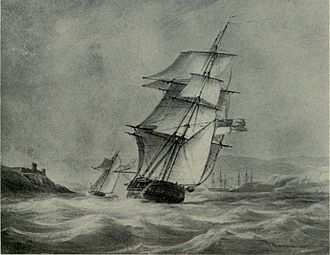
L'Egyptienne in 1806
from Wikipedia
|
Georgiana: voyage 1803-1807. |
|
|
| L'Espoir |
Royal Navy |
A cruiser-class brig/sloop launched in 1804. Noted in the log of the Georgiana as arriving at St Helena from England on 29th April 1805. On 6th May she sailed for a cruise and returned to St Helena on the 9th May. She took part in the capture of the Cape of Good Hope. She was again noted in the log of the Georgiana as arriving at St Helena on 23rd January 1806 with the news that the British had taken the Cape, she sailed the same day for ENgland. She was broken up in 1821. See Wikipedia for her history. |
Georgiana: voyage 1803-1807. |
|
|
| La Bellone |
Royal Navy |
A 34-gun French privateer captured off the coast of Ceylon by the HMS Rattlesnake and HMS Powerful under the command of Sir Edward Pellew on 12th July 1806. She was noted by Captain Jones of the Earl St Vincent as at Bombay on Sunday 4th January 1807. Captain Harington of the Ganges noted her still at Bombay on Wednesday 25th February 1807 and recorded that on the 27th February she acted as escort to the Ganges, Huddart and Lord Castlereagh. See Wikipedia. |
Ganges: voyage 1805-1807; Earl St Vincent: voyage 1806-1807. |
|
|
| La Cybelle |
Royal Navy |
Captain Barker of the Northampton records the La Cybelle as leaving St Helena on the 19th of January 1803. Not traced as a HMS ship but there is note of her as a French frigate in 1807. |
Northampton: voyage 1801-1803. |
|
|
| La Gloira |
Royal Navy |
Launched at Bayonne in 1799, she became a privateer in the Indian Ocean. She was captured on 23 March 1801 by HMS Albatross, under Captain William Waller. On Saturday 22nd November 1806, Captain Jones of the Earl St Vincent records her as a French prize that arrived at Madras with HMS Albatross. See Wikipedia for her history. |
Earl St Vincent: voyage 1806-1807. |
|
|
| La Psyché |
Royal Navy |
Taken 1805, presumably from the French in 1805, 5th rate, armament 32. Samuel Fish, midshipman joined the Psyche from the Ganges on 25th December 1806. John Samuel Yeats, Midshipman, was transferred to the La Psyché from the Earl St Vincent at Bombay on 24 December 1806. See: https://sites.rootsweb.com/~pbtyc/18-1900/C/01156.html, for information on her.
|
Ganges: voyage 1805-1807; Earl St Vincent: voyage 1806-1807. |
|
|
| Lady Amelia |
HEICS |
Listed by Farrington as Ann & Amelia (3). She was a chartered ship of 587 tons, owned by Joseph Somes of London. Three trips to China are recorded of which this her third, under Captain William Compton. Farrington records her as "went on shore 1st September 1832 at Berck near Boulogne and abandoned". She was built at Chittagong in 1816, sold at Calcutta in 1823 as a free trader. In 1824 she was a convict ship from England to Australia. She was driven ashore in a gale and lost four of her thirty crew. See Wikipedia has a detailed history of her. |
Repulse: voyage 1831-1832. |
|
|
| Lady Barlow |
HEICS |
Described as a Country ship. Noted in the log of the Georgiana as arriving at St Helena from Botany Bay on 5th April 1805. She departed for England on the 16th April. In 1805 she visited London with seal skins from Australasia under her Sydney based owner Robert Campbell but the Enderbys and the East India Company denied entry. On Friday 9th January 1807 Captain Jones noted of the Earl St Vincent that she sailed from Bombay. See: https://sites.rootsweb.com/~pbtyc/18-1900/C/01156.html, which records she trading for the Company 1806-1808. See the website; Danbyrnes. She is mentioned in Google Books, as being involved in the discovery of two islands on her voyage from Port Jackson to China called Mac Askill's Islands after her Captain on 29th October 1809. |
Georgiana: voyage 1803-1807; Huddart: voyage 1806-1807; Earl St Vincent: voyage 1806-1807. |
|
|
| Lady Burgess |
HEICS |
Built by Perry in Blackwall, London, launched 1799, length 146ft, 821 tons. She made four voyages to Bengal. Noted in the journal of the True Briton as sailing from the Motherbank on Tuesday 8th May 1804, commanded by Archibald Francis William Swinton. Noted in the log of the Georgiana that she set sail from St Helena on 4th September 1804. She had set off from Portsmouth on 30 Mar 1806 but was wrecked in a storm on the 20th April on Leytons Rock [John Letton's Rock], south-west of Boavista Island in the Cape Verde Islands. Most of her crew and passengers were saved. Captain Jones records the event in his entries on the 20th, 21st and 23rd April. See a full account of her on the 'Events' page.
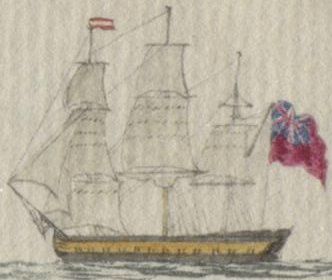
Vignette of the ship Lady Burgess
|
True Briton : voyage 1804-1805; Earl St Vincent: voyage 1806-1807. |
|
|
| Lady Castlereagh |
HEICS |
Built by Randall, launched 1802, length 146ft, 821 tons. Seven voyages are recorded. Noted in the log of the Georgiana as arriving at St Helena on 14th August 1804. She sailed on the 11th September. Noted by Captain Harington of the Ganges on her second, under Captain Thomas Garland Murray. Noted again in the log of the Georgiana as arrived at St Helena with stores from England on Saturday 20th July 1805. Her last voyage with the Honourable East Company was in 1817. In December 1817 she set sail for New South Wales, Australia as a convict ship landing on 11th June 1818.
| Georgiana: voyage 1803-1807; Ganges: voyage 1805-1807. |
|
|
| Lady Flora |
HEICS |
Built 1813, 756 tons. A chartered ship sailing from China under Captain Thomas Brown. Noted by Captain Rawes of the Warren Hastings north of St Helena on 29th April 1816. |
Warren Hastings: voyage 1815-1816. |
|
|
| Lady Jane Dundas |
HEICS |
Built by Clevely, launched 1800, length 146ft, 826 tons. Noted in the Journal of the True Briton as sailing with the Convoy back to England on 12th July 1805, her commander was Captain the Hon Hugh Lindsay. On her fourth trip to India, commanded by Captain Hon Hugh Lindsay. Captains Harington of the Ganges and Jones of the Earl St Vincent record her as arriving at Point de Galle from Bengal on Sunday 15th March 1807. Her last and fifth recorded trip under Captain John Eckford was in 1808 when on 14th March 1809 off Mauritius she parted company with the convoy and was not heard of again.
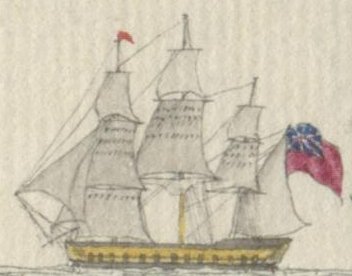
Vignette of the ship Lady Jane Dundas
|
True Briton: voyage 1804-1805; Ganges: voyage 1805-1807; Earl St Vincent: voyage 1806-1807; Huddart: voyage 1806-1807. |
|
|
| Lady Lushington |
HEICS |
Built by Mestaer 1809, length 132ft, 594 tons. Her second voyage to Bengal. Her commander was Captain John Hine. Her last recorded voyage was in 1818 under Captain Thomas Dormer. The Lady Lushington struck rocks and foundered near to Corings, New South Wales. See the website: www.ciaofamiglia.com/ehfburton/burtondocs/01_Hamptons-Senior-&James-&Palmers/1821-Lady-Lushington-sinks/LadyL-Sinks-21-Aug-1821_17-May-1822.pdf and www.ciaofamiglia.com. |
Lord Keith: voyage 1810-1811. |
|
|
| Lady Melville |
HEICS |
Built by Wells, launched 1813, length 165ft, 1263 tons. Ten voyages to China are recorded. Noted in the journal of the Bridgewater in the Channel on 9th January 1829 on commencement of their voyage to the East. Also noted by Captain Gribble of the Repulse on her ninth, under Captain Robert Clifford. The website: www.historic-shipping.co.uk/robwigram/lmelville%2013.html, has a detailed history of her. Owned by Sir Robert and Octavus Wigram. She was sold to John Campbell Aug 1832 for £10,000 and broken up in London in 1834.
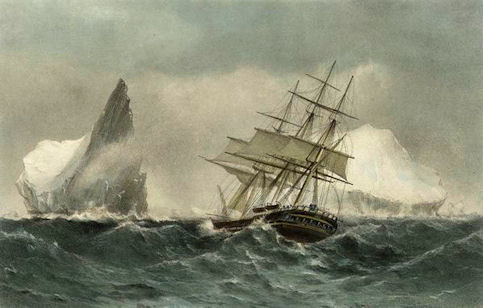
HEICS Lady Melville
|
Bridgewater: voyage 1828-1830; Repulse: voyage 1831-1832. |
|
|
| Lady Sinclair |
Royal Navy |
Otherwise the Lady Madeline Sinclair or Lady Madelina Sinclair. built of fir in Scotland and registered in Kingston upon Hull, England. She made two voyages to New South Wales and sailed from China under the East India Company flag. She was noted in the log of the Georigana as sailing from Cape Town for Botany Bay on 17th June 1806. She was commanded by Captain John Hardy Jackson. At this time she was acting as a supply and passenger ship and one of her passengers was Captain William Bligh of the Bounty fame, who was soon to be Governor of New South Wales. The Lady Sinclair was in a convoy escorted by the Porpoise which was supposed to be the flag ship under commender Joseph Short but there was continous disagreement between Commander Short and Captain Bligh who had assumed some kind of authority. See the Wikipedia article on the Sinclair . |
Georgiana: voyage 1803-1807. |
|
|
| Lancester |
Royal Navy |
Launched at Rotherhithe as the Pigot 29th Jsn 1797 but purchased from the East India company as a 3rd Rate, length 173ft, 1400 tons with 64 guns. In 1797 she took part in the Battle of Camperdown. She was noted in the Log of the Wexford as at Madras on 4th August 1803, along with HMS Trident HMS Centurion & HMS Victor. Her Commander at the time appears to have been Captain Fothergill. On 7th Nov 1803 the Trident, Tremendous, Centurion, and Lancaster, of the line; Dedaigneuse, frigate; and Albatross, sloop, arrived at Bombay from Madras. On 11th March 1815 she was converted to a storage ship She was moored at Deptford when put up for sail on 4 Jan 1832 and broken up. See https://sites.rootsweb.com/~pbtyc/18-1900/C/01156.html & https://en.wikipedia.org/wiki/HMS_Lancaster_(1797) for more information. |
Wexford: voyage 1803-1804; Cumberland: voyage 1805-1806. |
|
|
| Larkins (1) |
HEICS |
Built of teak in Calcutta by Hudson, Bacon & Co. and launched as the Louisa, in 1807, length 127ft, 637 tons. She sailed to England and in 1809 was bought by John Pascall Larkins. He named her Larkins after his nephew Captain Thomas Larkins, who at the time was in command of the HEICS ship Warren Hastings. It was probably at this time that she acquired a figurehead of a male warrior. In 1810 she was under the command of Captain Andrew Barclay. There continues a varied history of the ship on the website: www.museum.wa.gov.au/maritime-archaeology-db/wrecks/id-1333. The last recorded trip by Farrington was in 1818. In 1817, 1829 & 1831 it was used to transport convicts to Australia. It was used as a coal hulk and it ended its life in 1876 in Albany harbour, Australia, her figurehead survives. |
Lord Keith: voyage 1810-1811. |
|
|
| Leda |
Royal Navy |
36-gun frigate launched 18th November 1800, length 150ft, 1071 tons. Noted in the log of the Georgiana as arriving at St Helena from the recent capture of the Cape for supplies for the colony on 24th January 1806, she sailed back to the Cape on 27th January. On 1st January 1807 she was caught in a gale off Milford Hsven and wrecked. See Wikipedia for her history. |
Georgiana: voyage 1803-1807. |
|
|
| Leda |
Royal Navy |
Launched 1809, 5th rate, armament 36. In 1810 under Captain Sayer, the Leda led the fleet of HEICS, including the Lord Keith, to India and back. Captain Campbell writes of the 'Commodore' on many occasions. In this case he is referring Captain Sayer, Captain of Royal Navy Leda. The Leda was involved in the attack on Marrack near Batavia in 1811. Noted by Captain Rawes of the Warren Hastings near Sumatra on 16th August 1815 along with the Company ship Benares. She was disposed of in 1817. See: https://sites.rootsweb.com/~pbtyc/18-1900/C/01156.html, for further details. |
Lord Keith: voyage 1810-1811; Warren Hastings: voyage 1815-1816. |
|
|
| Leopard |
Royal Navy |
Built and launched at Sheerness 1790, 4th rate, armament 50, 1056 tons, complement 343. See Wikipedia and rootsweb.com for her history. On this occasion she acted as an armed escort in the North Atlantic for the annual fleet to the Far East. In 1814 she was wrecked off Anticosti Island in the Gulf of St Lawrence, while acting as a troop carrier, all lives were saved. She was commanded by Captain Edward Crofton. . |
Earl St Vincent: voyage 1806-1807. |
|
|
| Leviathan |
misc |
A whaler, probably based at London. Captain Farrer of the Cumberland noted her at St Helena on Wednesday 2nd July 1806. |
Cumberland: voyage 1805-1806. |
|
|
| Leyton |
misc |
Noted by Captain Rawes of the Warren Hastings in the South Atlantic on 20th April 1826, where he styled her as "the Leyton Transport, a troop carrier for the 56th Reg’t Infantry from the Mauritius". Not sure whether this is a description or the name of the ship. |
Warren Hastings: voyage 1825-1826. |
|
|
| Liberty lighter |
HEICS |
A lighter noted in the Journal of the True Briton as coming alongside at Longreach on Monday 21st October 1805. |
True Briton: voyage 1804-1805. |
|
|
| Lion |
HMS |
Launched 1777, 3rd rate armament 64. In May 1805 she was in Deptford undergoing repairs. By 17th October 1806 she was noted by Captain Lindsay of the Lady Jane Dundas as at Penang. By 1830 she was a hulk at Chatham and was disposed of in 1837. See https://sites.rootsweb.com/~pbtyc/18-1900/C/01156.html. |
Lady Jane Dundas: voyage 1805-1807. |
|
|
| Lively |
misc |
She was launched at Saint-Malo in 1765 as Duchess d'Aiguillon. Her entry in Wikipedia records a detailed history of her. She was renamed Abeille after the French Revolution and was captured by HMS Hebe in 1795. Daniel Bennett purchased her in 1798 and employed her in whaling. She was noted in the log of the Georgiana as sailing from St Helena to the 'south seas' (whaler) on Friday 2nd March 1804. She departed St Helena Botany Bay for England in convoy on 13th August 1804. She was noted again in the log as arriving at St Helena on 16th January 1806. She was lost on Mermaid's Reef near Timor in the Maluccas in early 1808. |
Georgiana: voyage 1803-1807. |
|
|
| Loire |
Royal Navy |
Frigate, launched at Nantes, France on 23rd March 1794; length 151ft, 1350 tons, 44 guns. She was captured by the British on 18th Oct 1798. Recorded in the journal of the Wexford on 4th Aug 1803 as at Madras. She had a long and full career and took part in the 1812 war with America. She was sold in 1817 and broken up in April 1818. See https://en.wikipedia.org/wiki/French_frigate_Loire_(1796) for her history. |
Wexford: voyage 1803-1804. |
|
|
| London Packet |
misc |
A privately owned merchantman. She was launched on the Thamas in 1791 and served in the Royal Navy as a hired ship from 1793 to at least 1800. She was noted in the log of the Georgiana as arriving at Cape Town from London on 5th December 1806. She then continued on private business until being captured by an American privateer in 1814. See Wikipedia. |
Georgiana: voyage 1803-1807. |
|
|
| Lord Bentinck |
HEICS |
Probably a local sloop noted in the journal of the Bridgewater as at Saugor on Saturday 16th May 1829 utilised for transporting cargo etc. between Saugor and Calcutta. She appears to be named after Lord William Bentinck, Governor-General of India. |
Bridgewater: voyage 1828-1830. |
|
|
| Lord Castlereagh (1) |
HEICS |
Built by Barnard 1802. Length 145ft, 812 tons. She made seven voyages to India and China. Noted in the Journal of the True Briton as at St Helena on 30th June 1805, commanded by Captain George Robertson. Noted in the log of the Georgiana as at St Helena on 6th July 1805. Her second was in 1806/7, under Captain Christopher Kymer. Noted by Captain Lindsay of the Lady Jane Dundas at Portsmouth on 4th March 1806 as part of the outward bound convoy. On 26th February 1807 she is recorded by Captain Harington of the Ganges as an 'Extra' ship. Captain Harington also records her as arriving at Point de Galle from Madras on Tuesday 17th March 1807, she sailed to Colombo on the 18th and then joined the Convoy back to England. She is here recorded by Captain Jones as arriving at Point de Galle from Bombay on Saturday 14th March 1807. She was at Madras on 26th February 1807. Her last recorded voyage was her seventh in 1817. In December 1817 she set sale for New South Wales, Australia as a convict ship landing on 11th June 1818.
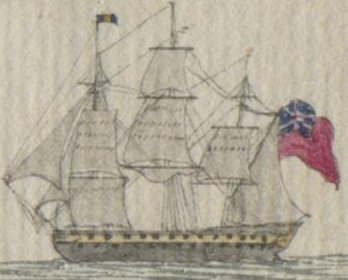
Vignette of the ship Lord Castlereagh
|
True Briton: voyage 1804-1805; Georgiana: voyage 1803-1807; Lady Jane Dundas: voyage 1805-1807; Earl St Vincent: voyage 1806-1807; Ganges: voyage 1805-1807, Huddart: voyage 1806-1807. |
|
|
| Lord Clive |
HEICS |
This ship was noted in the logs of the Packet ship Georgiana on Sunday 27th November 1803 as arriving at St Helena. She is described 'Lord Clive Passenger in the C E' (or C S). If it is C S then 'Company Service' may make sense but it is not clear what the log entry means unless she was only carrying passengers, which is not normal for this time. She was noted in the log as leaving St Helena on 5th January 1804. |
Georgiana: voyage 1803-1807. |
|
|
| Lord Duncan |
HEICS |
Built by Perry, launched 1798, 3 decks, 146ft long, 830 tons. She made seven voyages to the East. Noted in the log of the Georgiana as arriving at St Helena on Tuesday 14th Feb. 1804 under the command of Captain Anthony Murray. She departed for England on 26th Feb. Noted in the journal of the True Briton as arriving at the Motherbank from St Helena along with a number of Extra ships on 24th April 1804. Noted on her outward bound voyage on 21st May 1807 off South Africa by Captain Lindsay of the Lady Jane Dundas, under Captain Edward Chapman Bradford. Noted on her seventh voyage by Captain Rawes of the Juliana 1812/3, under Captain Thomas Price, which was her last recorded voyage. |
Georgiana: voyage 1803-1807; True Briton: voyage 1804-1805; Lady Jane Dundas: voyage 1805-1807; Juliana: voyage 1812-1813. |
|
|
| Lord Eldon |
HEICS |
Built by Temple 1802, length 123ft, 538 tons. Noted in the journal of the True Briton as arriving at the Motherbank on Sunday 20th May 1804, under Captain Jasper Swete. Noted in the log of the Georgian as arriving at St Helena from Bencoolen on 6th September 1805. Noted in the journal of the Huddart to India, commanded by Captain John William Young. Her seventh and last recorded voyage was in 1815.
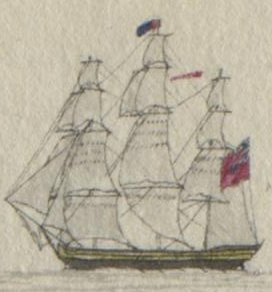
Vignette of the ship Lord Eldon
|
True Briton: voyage 1804-1805; Georgiana : voyage 1803-1807; Huddart: voyage 1806-1807. |
|
|
| Lord Hawkesbury |
HEICS |
Built by Randall, launched 1786, length 144ft, 803 tons. She is recorded by Farrington as making at least eight voyages to India. Recorded by Captain Jones of the Earl St Vincent on Monday 3rd March 1806 as off Long Reach, England. Farrington states that she returned from India in March 1806 and didn't sail to India again until Jan 1807 therefore she may have been on other business at this stage. |
Earl of Vincent: voyage 1806-1807. |
|
|
| Lord Keith |
misc |
A sloop at Saugor, Calcutta, noted by Captain Sanders of the Northampton on Saturday June 4th 1808. Along with the HEICS ship Lord , there was another ship with the same name. It was a sloop that foundered on the Farne Islands, Northumberland in August 1809, on a voyage from London. Its commander was Captain Baird. It is possible that this is one and the same ship. |
Northampton: voyage 1807-1809. |
|
|
| Lord Keith |
HEICS |
Described as a brig in a newspaper article in 1810, she was built by Mestaer and launched in 1804. Farrington describes the ship in detail: 3 decks, 4in bottom, length 132ft 2in, keel 107ft 4in, breadth 32ft 5in, hold 13ft, wing transom 21ft,7½in, port cell 28ft 11in, waist 11in, between decks 5ft 11in, roundhouse 6ft 2in, ports 10 upper, 599 tons. Principal Managing Owners: 1-2 Peter Everett Mestaer, (Peter Everett Mestaer died of a stroke in 1819.), 3-8 Robert Morris. Noted in the log of the Georgiana as at St Helena on 1st November 1805, she sailed for England on 4th November. She had arrived on 22nd October, her commander was Captain Patrick Ramage. Captain Bayliff recorded her as arriving at St Helena on 10th June 1806. She was noted again in the log of the Georgiana as arriving at St Helena in convoy on 27th August 1806. Captain Rawes of the Juliana noted her arriving at St Helena on 10th June 1813, he had sailed on her as 1st Mate in 1809/10. Her last recorded voyage was in 1818. |
Georgiana: voyage 1803-1807, Huddart: voyage 1806-1807, Juliana: voyage 1812-1813. |
|
|
| Lord Melville (1) |
HEICS |
Built by Dudman, launched 1803, length 146ft, 818 tons. Six voyages are recorded by Farrington. Noted in the log of the Georgiana as arriving in convoy at St Helena on 31st December 1804. She departed in convoy for England on 13th January 1805. On her second, under Captain Charles Lennox, Captain Jones of the Earl St Vincent noted her in the Channel, along with the Sovereign off the South Downs on Tuesday 11th March 1806. They were in fact part of the convoy to India. The Lord Melville narrowly avoided foundering on a reef in the Cape Verde Islands, see Events. |
Georgiana: voyage 1810-1811; Earl St Vincent: voyage 1806-1807. |
|
|
| Lord Nelson |
HEICS |
Built by Barnard, launched 1799, length 146ft, 819 tons. She made five voyages to India. Noted by the True Briton as sailing with a convoy back home from St Helena on 12th July 1805, her commander was Captain Wemyss Orok. On her fourth voyage she her commander was William Charles Hutton when Captain Farrer of the Cumberland noted her at St Helena on her out-going trip to India on Wednesday 2nd July 1806. Captain Bayliff of the Huddart also recorded her. Captain Harington of the Ganges noted her at Point de Galle on 26th March 1807. Her last voyage was in 1808 under Captain Hutton. She parted company from the fleet on 28 October 1808 in a gale and was not heard of again. Francis Graham, midshipman on the Huddart, sailed on the unfortunate vessel in 1808.
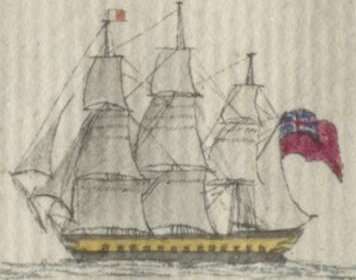
Vignette of the ship Lord Nelson
|
True Briton: voyage 1804-1805; Cumberland: voyage 1805-1806; Ganges: voyage 1805-1807; Huddart: voyage 1806-1807; Earl St Vincent: voyage 1806-1807. |
|
|
| Louisa |
HEICS |
On Saturday 20th December 1811 while off Ceylon, Captain Bayliff of the Huddart described sighting the Louisa, a Country ship for Bombay. Nothing else known. |
Huddart: voyage 1806-1807. |
|
|
| Lowther Castle |
HEICS |
Built 1811, 176ft long, 1427 tons. Sailed to China at least twelve times. Noted on her third voyage under Captain Charles Mortlock. On her seventh voyage, under Captain Thomas Baker and on her ninth voyage, under Captain Thomas Baker all by Captain Rawes of the Warren Hastings. She was sold to Joseph Somes for £8650 and her last recorded voyage was in 1834/4. For a painting of her see Bahar Amateur Lithographic Scrap Book (1828) pl. 15 Indiaman taking in cargo at the New Anchorage. IOL: X.1168(a). |
Warren Hastings: voyage 1815-1816; Warren Hastings: voyage 1819-1820; Warren Hastings: voyage 1823-1824; Warren Hastings: voyage 1825-1826. |
|
|
| Lucy lighter |
HEICS |
A lighter recorded by Captain Barker of the Northampton on Thursday 7th April 1803 while unloading at Deptford. |
Northampton: voyage 1801-1803. |
|
|
| Lusitania |
misc |
Sailed with the convoy until parting company for Cape Town on Monday November 30th 1807, nothing else known.
|
Northampton: voyage 1807-1809. |
|
|
| Lyon |
misc |
An American brig noted in the log of the Georgiana as arriving at Simons Bay, Cape of Good Hope on 17th July 1806.
|
Georgiana: voyage 1803-1807. |
|
|
|
M |
| MacQueen |
HEICS |
Built by Brindley 1821. 166ft long, 1333 tons. Sailed to China at least six times. Noted by Captain Rawes of the Warren Hasting on her third voyage under Captain James Walker. |
Warren Hastings: voyage 1825-1826. |
|
|
| Madras hoy |
HEICS |
A hoy Noted in the Journal of the True Briton at Blackwall on Saturday 16th November 1805. |
True Briton: voyage 1804-1805. |
|
|
| Madras |
misc |
On Thursday 11th March 1824, the Madras Commanded by Captain Fisher drew up alongside and asked for water. Captain Fisher informed Captain Rawes that he "had invalids & many passengers on board from Columbo and only two days water on board". Captain Rawes of the Warren Hastings supplied him with 1300 gallons. On Sunday 14th March 1824, another 1271 gallons was supplied. |
Warren Hastings: voyage 1823-1824. |
|
|
| Magnet |
HEICS |
Steam packet operating from Deptford. Also noted in the journal of the Bridgewater at Northfleet on 8th December 1828. Towed the Repulse on 11th Feb 1831. |
Bridgewater: voyage 1828-1830; Repulse: voyage 1831-1832. |
|
|
| Maitland |
misc |
A 'south seaman' in the log of the Georgiana as arriving at St Helena on 1st March 1804. She departed in convoy on 1st April 1804. |
Georgiana: voyage 1803-1807. |
|
|
| Makassar |
Royal Navy |
Launched 1781, 36 gunned frigate. length 145ft, 850 tons. She was a Dutch or Batavian Republic frgate called Pallas under the command of Captain N S Aalbers when she was captured in July 1806 by HMS's Greyhound & Harrier, suffering heavy losses. She taken into the Royal Navy as the Makassar and within a year was renamed Celebes, Commanded by Captain Edward Troubridge of the Harrier. In late 1807 a decision was made at Calcutta to sell her. See https://en.wikipedia.org/wiki/HMS_Celebes_(1806). |
Lady Jane Dundas: voyage 1805-1807. |
|
|
| Malcolm |
HEICS |
The only ship of this name found in Farrington, is a chartered ship of 600 tons which made four trips to Madras and Bengal between 1825 and 1831. Unfortunately this Malcolm was in the South Downs on 7th May 1831, which would rule it out as Captain Gribble of the Repulse notes the Malcom in the Strait of Malacca on 23rd Aug 1831. |
Repulse: voyage 1831-1832. |
|
|
| Mangles |
HEICS |
Extra ship, built in Bengal 1803, 2 decks 4in bottom, length 119ft 10in, keel 94ft 4½in, breadth 33ft 1in, hold 17ft 2in, wing transom 22ft 4½in, port cell 28ft 4in, waist 1ft 5in, between decks 6ft 3¼in, roundhouse 6ft, ports 11 upper, 549 tons. Principal Managing Owner: John William Buckle/Buckle & Co. On her third voyage, to China and Halifax, her commander was Captain William Carr. Noted in the journal of the Bridgewater as at Toun-koo on Saturday 26-28th December 1829. She was loading on lead and tea. |
Bridgewater: voyage 1828-1830. |
|
|
| Manilla |
Royal Navy |
Frigate launched 1809, armament 36. On the 28th June 1810, she arrived at Madeira and departed on the 30th. She was wrecked on the Haak sand, Texel, all crew except twelve, saved, but made prisoners. Her commander was Captain John Boyce. See: https://sites.rootsweb.com/~pbtyc/18-1900/C/01156.html. |
Lord Keith: voyage 1810-1811. |
|
|
| Manship (2) |
HEICS |
Nothing recorded by Farrington except this voyage to Bengal. She was commanded by Captain John Logan. |
Northampton: voyage 1801-1803. |
|
|
| Marchioness of Ely |
HEICS |
Built by Wells, launched 1812. 149ft long at 952 tons. She made nine voyages to the East. Noted by Captain Rawes of the Juliana as arriving at St Helena on 5th June 1813. Her Captain was Brook Kay. Farrington does not record her visit to St Helena but it is implied by her voyage.
|
Juliana: voyage 1812-1813. |
|
|
| Marchioness of Exeter |
HEICS |
Launched 1801, length 146ft, 820 tons. Recorded as making seven voyages to the East. Noted in the Journal of the True Briton she sailed from St Helena in convoy for England on 12th July 1805, her commander was Captain Alexander Nash. On her 3rd voyage she was commanded by Captain Alexander Nash. On 17th October 1806 she was noted by Captain Lindsay of the Lady Jane Dundas as at Penang. Her last recorded voyage was in 1817.
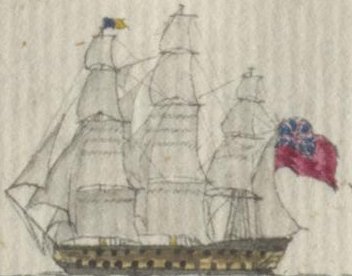
Vignette of the ship Marchioness of Exeter
|
True Briton: voyage 1804-1805; Lady Jane Dundas: voyage 1805-1807. |
|
|
| Margaret |
HEICS |
Noted in the log of the Georgiana as arriving at Cape Town from England on 10th December 1806. The log stated that she had left England on 15th September. She sailed for Bengal on 25th December. She is assumed to be the same ship noted by Farrington as being built at Chittagong weighing 250 tons, leaving Bengal 3rd December 1805 and arriving in England on 2nd July, commanded by Captain Benjamin Fergussan. She was later captured by the French but see Wikipedia for a possible conflation of two ships called Margaret. |
Georgiana: voyage 1803-1807. |
|
|
| Margaret |
misc |
Probably a local brig noted in the journal of the Bridgewater at Saugor on Friday 8th May 1829 utilised for transporting cargo etc. between Saugor and Calcutta. There was a 300-ton ship called the Margaret built at Chittagong and launched in 1794, but there are other possibilities, see https://en.wikipedia.org/wiki/Margaret_(1804_ship). |
Bridgewater: voyage 1828-1830. |
|
|
| Maria |
misc |
She was launched at Gainsborough in 1798. She is recorded by Farrington as making two voyages from Bengal to London. Noted in the log of the Georgiana as arriving at St Helena on 21st October 1804 from Penang. Her commander on this occasion was Captain William Brown Greenway. She sailed from St Helena on 8th November 1804. Farrington records that she did not arrive at London until 5th March 1805. She is last listed in 1833, see Wikipedia. |
Georgiana: voyage 1803-1807. |
|
|
| Maringo |
misc |
A Téméraire class Man of War ship of the line for the French Navy. launched 21st July 1795 under Captain Racord with 74 guns and called the Jean-Jacques Rousseau. She was renamed Marengo in 1802. She took part in operations in the Indian Ocean under the renowned Commander Charles-Alexandre Léon Durand Compte de Linois. The naval engagement with the East India Company and in particular with the Cumberland, as noted by her Captain Farrer on Wednesday 7th August 1805. See https://en.wikipedia.org/wiki/French_ship_Jean-Jacques_Rousseau_(1795) & https://en.wikipedia.org/wiki/Charles-Alexandre_L%C3%A9on_Durand_Linois.
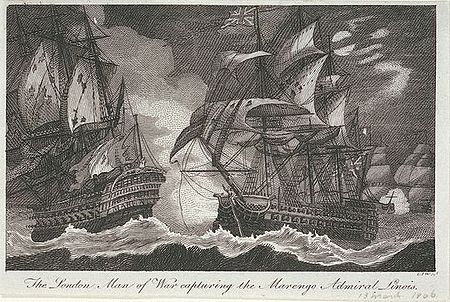
Marengo (left) engaging HMS London (right) in 1806,
taken from Wikipedia.
The Maringo was captured by the Royal Navy on 13th March 1806 and became a prison ship from 1809 onwards until she was broken up in 1816.
|
Cumberland: voyage 1805-1806. |
|
|
| Marie Thèrese |
misc |
A frigate on route from Rio de Janeiro to Brest recorded on Monday 26th March 1827. |
Vansittart: voyage 1826-1828. |
|
|
| Marquis Cornwallis |
HEICS |
Built at Bombay, the second of her name; length 171ft, 1360 tons. She became a Company frigate. She made one recorded trip from India in 1803 and was noted in the journal of the True Briton as sailing from Spithead with the India fleet on Tuesday 8th May 1804 and remained in the East, her commander was Captain Isaac Godsalve Richardson. She was noted again in the log of the Georgiana as arriving at 10am on Monday 23rd July 1804. She was also noted in the same log as a Company frigate when she set sail for India on the 1st August 1804. |
True Briton: voyage 1804-1805.
; Georgiana: voyage 1803-1807. |
|
|
| Marquis of Camden |
HEICS |
Built 1812, 165ft long, 1261 tons. Sailed to China at least 10 times. Her second voyage, under Captain Henry Morse Samson was noted by Captain Rawes of the Warren Hastings in the South China Sea. Her fourth voyage, under Captain Thomas Larkins was noted by Captain Rawes of the Warren Hastings. Her last recorded voyage was in 1931/3. |
Warren Hastings: voyage 1815-1816; Warren Hastings: voyage 1819-1820. |
|
|
| Marquis of Ely |
HEICS |
Built by Perry, launched 1801. length 165ft, 1262 tons. Noted in the log of the Georgina as at Blackwall on 18th July 1803, commanded by Captain Andrew Hannay. Noted again in the same log as arriving from China in convoy at St Helena on 2nd April 1805. Upon antering harbour the Georgiana lowered its flag in consequence of Captain Andrew Hannay's death four days before on 29th March. Noted by the True Briton as sailing from St Helena with the Convoy back to England on 12th July 1805, commanded by Captain Andrew Hannay. On 17th October 1806 she was noted by Captain Lindsay of the Lady Jane Dundas as at Penang. This was her third voyage, under Captain James Dalrymple, out of eight recorded. Her last recorded voyage was in 1820.
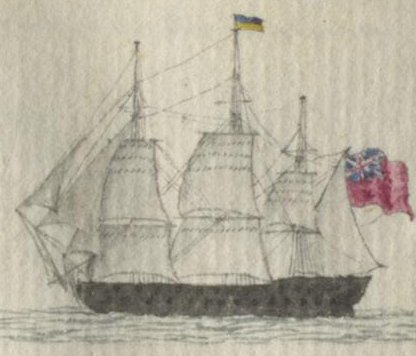
Vignette of the ship Marquis of Ely
|
Georgiana: voyage 1803-1807; True Briton: voyage 1804-1805; Lady Jane Dundas: voyage 1805-1807. |
|
|
| Marquis of Huntley |
HEICS |
Built by Brent and launched in 1811, length 167ft, 1279 tons. Sailed to China eleven times and now on her tenth voyage under Captain John Hine. Noted by Captain Gribble of the Repulse at Penang on 18th August 1831. |
Repulse: voyage 1831-1832. |
|
|
| Marquis Wellesley |
HEICS |
Built by Randall, launched 1799. length 146ft, 818 tons. Six recorded voyages to India. Noted in the Journal of the True Briton as leaving St Helena for England on 12th July 1805, commander was Captain Charles Le Blanc. She was commanded by Captain Charles Le Blanc when on 17th October 1806 she was noted by Captain Lindsay of the Lady Jane Dundas as at Penang and on 30th December she was at Kedgeree. She was also noted by Captain Bayliff of the Huddart. On Her sixth and last recorded voyage was in 1811 when she was recorded as going aground in the harbour at Bombay 16 April 1813.
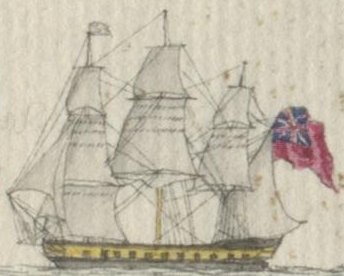
Vignette of the ship Marquis Wellesley
|
True Briton: voyage 1804-1805; Huddart: voyage 1806-1807; Lady Jane Dundas: voyage 1805-1807. |
|
|
| Mary |
HEICS |
A Company ship mentioned by Captain Rawes, as arriving at Batavia on 22nd December 1812 from Bengal. Mentioned again as arriving at Cape Town on 19th May 1813 and is probably one of the three 'Country' ships Captain Rawes recorded arriving at St Helena on 8th June 1813. She has been matched with the ship Mary recorded by Farrington:- ninth of that name, sailing to New South Wales and Bengal. Farrington records her route:- Portsmouth 26 Nov 1811 to Madeira 1st Dec; to Rio de Janeiro 2nd Jan 1812; to Port Jackson 5th May; to Malacca 28th Sep; to Diamond Harbour 27th Oct; to Calcutta 1st Nov; to Diamond Harbour 7th Feb 1813; to Point de Gaile [Galle] 13 Mar; to St Helena 9th Jun; to Downs 10th Aug. Her Captain is not recorded.
She may or may not be the Mary noted in the journal of the Bridgewater as a Country ship arriving, along with the Samdany, at Whampoa on Sunday 10th January 1830, on Monday 18th January she was still alongside the Bridgewater unloading tea. |
Juliana: voyage 1812-1813. |
|
|
| Mary |
misc |
A British whaler in the Southern Ocean. She was noted in the log of the Georgiana as arriving at St Helena on Wednesday 22nd February 1804. The entry stated that she had arrived from the Cape of Good Hope where she had been involved in a rather unusual and unclear event involving the term 'cartel'. She then had some assistance from the crew of the Georgiana before departing on the 26th February. Subsequent research revealed a fascinating story of her being detained and her crew imprisoned. An Admiralty Report on Google Books detailed a court case. This event is recorded in more detail near the log entry on 22nd February 1804. |
Georgiana: voyage 1803-1807. |
|
|
| Mary |
misc |
An American ship noted in the log of the Georgiana as arriving at St Helena from Canton on 11th April 1804. |
Georgiana: voyage 1803-1807. |
|
|
| Mary Ann |
misc |
An American whaler that was noted in the log of the Georgiana at arriving at St Helena on 5th December 1805. She may be the same Mary Ann that Captain Rawes of the Juliana recorded her as 'With a South Sea Mast' as at St Helena on 12th April 1813. |
Georgiaa: voyage 1803-1807; Juliana: voyage 1812-1813. |
|
|
| Matilda |
misc |
Noted in the log of the Georgiana as an American ship arriving at St Helena on 8th March 1804. She sailed for America on the 11th March. |
Georgiana: voyage 1803-1807. |
|
|
| Matilda |
misc |
A country ship noted in the log of the Georgiana as arriving at the Cape of Good Hope on 23rd December 1806. Her commander was Captain Scott. She sailed for Bengal on 26th December. |
Georgiana: voyage 1803-1807. |
|
|
| Matilda |
misc |
An English whaler noted in the log of the Georgiana as arriving at St Helena on 23rd May 1804. There was an incident in the Cape involving the whaler Mary in which the Matilda was involved. See the Georgina's log for 27th February 1804. The Matilda is described there as a 'cartel ship', a term relating to humanitarian ships carrying communications or prisoners between belligerents. The Georgiana's records that on 26th May she set sail for France with her French prisoners. |
Georgiana: voyage 1803-1807. |
|
|
| Mediator |
Royal Navy |
An East Indian purchased in 1804 as a 5th Rate frigate & store ship; armament 44. On 4th August 1804 Captain Sir T Livingstone was appointed her commander. Noted in the log of the Georgiana as arriving at St Helena on 2nd May 1805. She was noted in the Journal of the True Briton as at St Helena on 30th June 1805, and helped to escort the East India Convoy back to England. She was noted in the log of the Georgiana as sailing from the Island on 7th July, maybe this was for a short cruise before departing for England. She was disposed of on 11th April 1809 and burnt as a fire ship in Basque Roads. Her then Commander was Captain James Wooldridge.
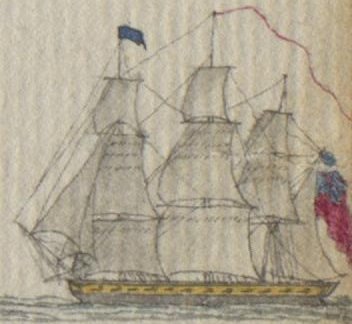
Vignette of the ship Mediator
|
True Briton: voyage 1804-1805; Georgiana: voyage 1803-1807. |
|
|
| Medusa |
Royal Navy |
A frigate built at Northfleet by Pitcher, launched on 14th April 1801 as a 32-gun 5th rate frigate, armament 32, complement 254, 520 tons. Commanded by Lord Nelson on 2nd August 1801. On 15th April 1805 she sailed for Bengal commanded by Sir John Gore. In September 1805 at Saugor she took on board 609 men, women and children of the 67th Regiment. They had boarded at Madras on the Ganges. On Saturday 14th September 1805, she was moored at Saugor. She was noted in the log of the Georgiana as arriving at St Helena from Calcutta on 23rd December 1805. She was carrying dispatches of the death of the Marquis Cornwallis in India. She sailed for England on 25th December 1805. In 1806/7 she served on the River Plate. See: https://sites.rootsweb.com/~pbtyc/18-1900/C/01156.html and https://en.wikipedia.org/wiki/HMS_Medusa_(1801), for her eventful history. She was decommissioned on 17th November 1816.

HMS Medusa
http://www.admiralnelson.info/Ships.htm
|
Ganges: voyage 1805-1807. |
|
|
| Mercator? |
HEICS |
Noted in the log of the Georgiana as arriving at Simons Bay from England on 21st July 1806. She arrived with a ship called John. |
Georgiana: voyage 1803-1807. |
|
|
| Mermaid |
HEICS |
A private merchantman noted in the log of the Georgiana as arriving at the Cape of Good Hope on 23rd December 1806 from England. |
Georgiana: voyage 1803-1807. |
|
|
| Mercury |
HEICS |
Not to be confused with the Company ship Mercury (2), listed by Farrington, which happened to be at Madras at the same time. The ship that Captain Jones of the Earl St Vincent described was the Company’s cruiser Mercury, which he recorded as arriving at Madras from Busorah [Basra] on Saturday 25th October 1806. She sailed again to Busorah on Tuesday 18th November. |
Earl St Vincent: voyage 1806-1807. |
|
|
| Metcalf |
HEICS |
Built by Barnard and launched 1804, length 146ft, 819 tons. She made six voyages to the Far East. Noted by Captain Farrer of the Cumberland on her maiden, under Captain Matthew Isacke, on Saturday 6th July 1805 she was in the Roaring Forties on her way to the East. She was noted on 21st May 1807 on her outward bound voyage off Sough Africa by Captain Lindsay of the Lady Jane Dundas. Her last recorded voyage was in 1816. |
Cumberland: voyage 1805-1806; Ganges: voyage 1805-1807; Earl St Vincent: voyage 1806-1807; Lady Jane Dundas: voyage 1805-1807. |
|
|
| Milford |
HEICS |
Built in Bombay 1786, 625 tons, a country owned by Bruce Fawcett & Co. She was spotted by Captain Barker of the Northampton on Thursday 18th November 1802 as out from the Cape of Good Hope bound for Calcutta. He does not however specify which flag she was under. Her only recorded trip under the HEICS flag was in 1805, sailing between Bombay to England. Later on in the log on Wednesday 23rd March 1803, while off the Downs, Captain Barker recorded a schooner called the Milford. He noted her as Her Majesty's schooner the Milford. A Lieut came on board and pressed a number of the Northampton's hands. Captain Barker however does not record this event against the ship's crew. Noted in the log of the Georgiana as arriving at St Helena on 21st January 1806, her commander was Captain George Douglas. On Tuesday 3rd February 1807 while off the coast of India, Captain Jones of the Earl St Vincent |
Northampton: voyage 1801-1803; Georgiana: voyage 1803-1807; Earl St Vincent: voyage 1806-1807. |
|
|
| Milford |
HEICS |
On Tuesday 3rd February 1807 while off the coast of India, Captain Jones records that the ship's jolly boat returned from the 'Milford'. There is an assumption here that this is probably a Country ship which Farrington recorded under two headings as making two voyages: one from Bengal to England in 1799 under Captain Michael Jordan, and another from Bengal to England in 1805/6 under Captain George Douglas. Farrington records on the latter voyage that she was built at Bombay in 1786, weighed 625 tons and was owned by Bruce Fawcett & Co. |
Earl St Vincent: voyage 1806-1807. |
|
|
| Milford |
HEICS |
Believed to be the Milford recorded by Farrington as being built at Bombay 1786 weighing 625 tons. The only trip recorded was from to England in 1805/6. Captain Rawes recorded her as arriving at St Helena on Wednesday 31st March 1824 from 'from Bombay'. |
Warren Hastings: voyage 1823-1824. |
|
|
| Minerva (3) |
HEICS |
There are several HEICS ships of this name existing around this time. The most likely one is Minerva (3). Not much is known about this ship. Its only recorded HEICS voyage was to New South Wales and Bengal in 1798-1801 under captain Joseph Salkeld. On its return voyage it had arrived at the Downs on 26 May 1801. |
Northampton: voyage 1801-1803. |
|
|
| Minerva |
misc |
Recorded by Captain Clarke of the Wexford on Tuesday 19th April as in the North Atlantic out from Tenerife 48 hours and bound for London. |
Wexford: voyage 1803-1804. |
|
|
| Minerva (7) |
HEICS |
Built Bombay 1813, 976 tons. Made at least eight voyages to India and two to China. Noted by Captain Rawes of the Warren Hastings on her third under Captain John Mills. |
Warren Hastings: voyage 1819-1820. |
|
|
| Monarch |
HEICS |
Extra ship, built by Mestaer 1801. Length 124ft, 609 tons. Her maiden voyage to Bengal out of five recorded by Farrington was commanded by Captain Thomas Mortimer and noted by Captain Barker of the Northampton. Noted by the True Briton as sailing from St Helena with the Convoy back to England on 12th July 1805, commanded by Captain Stephen Hawes. On her her third trip to India, she was commanded by Captain Stephen Hawes. On 17th October 1806 she was noted by Captain Lindsay of the Lady Jane Dundas as at Penang. Captain Harington of the Ganges, Captain Jones of the Earl St Vincent and Captain Bayliff of the Huddart record her as arriving at Point de Galle from Bengal on Sunday 15th March 1807. She was noted by Captain Campbell of the Lord Keith, under Captain Thomas Havard. On Friday 29th June 1810, while at Madeira, the carpenter of the Lord Keith was onboard the Monarch repairing their Bowsprit. Her last recorded voyage was in 1812. |
Northampton: voyage 1801-1803; True Briton: voyage 1804-1805; Lady Jane Dundas: voyage 1805-1807; Ganges: voyage 1805-1807; Earl St Vincent: voyage 1806-1807; Huddart: voyage 1806-1807; Lord Keith: voyage 1810-1811. |
|
|
| Monmouth |
Royal Navy |
Launched at Rotherhithe 23rd April 1796 by Randell & Co. for the HEICS under the name 'Belmont'. She was however purchased by the Royal Navy as a 3rd rate with armament of 64. She served through the Napoleonic Wars. She saw action at Camberdown (The Battle of Camperdown was a major naval action fought on 11 October 1797), under her Captain Commander James Walker (1764-1831), in 1797. In 1807 she acted as escort ship for the HEICS fleet to India, under Rear-Admiral William O'Bryen Drury. See: rootsweb.com and Wikipedia for further details. On 30th August 1811 while off Margate she pressed a number of crew from the ship Lord Keith. She served as a hulk at Woolwich from 1814 until she was broken up in 1834. |
Northampton: voyage 1807-1809; Lord Keith: voyage 1810-1811.. |
|
|
| Montezuma |
misc |
She was launched in Philadelphia, America in 1804, between 170-300 tons. Noted in the log of the Georgiana as arriving at St Helena from Batavia on 22nd December 1805. Her commander appears to have been Captain John Anley. She was later seized by the British for violating trade restrictions with the HEICS. She had a lengthy military career ending in Chilli and became a merchant ship again in 1828. See her story in Wikipedia.
|
Georgiana: voyage 1803-1807. |
|
|
| Montrose |
HEICS |
Captain Jones of the Earl St Vincent noted her on Tuesday 16th June 1807 as a 'stow' ship at St Helena, otherwise not traced.
|
Earl St Vincent: voyage 1806-1807. |
|
|
| Montague |
Royal Navy |
Built at Chatham, launched 1779, 3rd rate, armament 74; 1631 tons, complement 594. Disposed 1818. Quite a lot is known about this ship. She is recorded as leading this convoy of HEICS ships from Portsmouth to the East Indies. See: rootsweb.com and Wikipedia. Captain Rawes records her Commodore at this time as being Admiral [Manley] Dixon. His biography is published on Wikipedia.
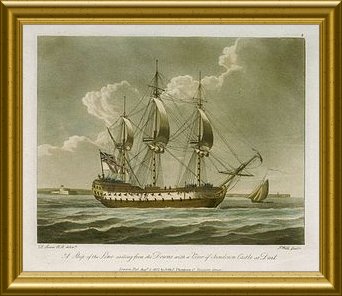
HMS Montague
|
Juliana: voyage 1812-1813. |
|
|
| Mornington |
HEICS |
1/ Farrington only records two voyages for the Mornington, 1799-1800 & 1801-1802, both to Bengal. He gives no further details.
2/ Farrington also records the Earl of Mornington, a 241-ton Company packet launched in 1799, which made two recorded voyages to India, 1799-1802 & from Madras to England in 1803. It states that she was purchased by the Royal Navy in 1804. See Wikipedia for the history of this ship.
A ship named Mornington was noted in the log of the Georgiana as arriving at St Helena on 4th October 1804.
The Mornington was recorded by Captain Harington of the Ganges in the Indian Ocean on Monday 15th July 1805 and several times subsequently as part of the convoy. She was in the Madras/Ceylon area in October 1806 as she, under her Commander Captain Robert Nicholas, had assisted in cornering the French privateer Superbe, which the schooner Pitt, under the command of Lieutenant Michael Fitton, was engaging. She was broken up at Sheerness in 1808. See Wikipedia for the history of this ship.
Captain Jones of the Earl St Vincent records the Mornington as a Company sloop arriving Bombay Wednesday 24th December 1806. Later on he describes it as a Company cruiser. It is not clear to which ship Captain Jones was referring.
|
Georgaina: voyage 1803-1807; Ganges: voyage 1805-1807; Earl St Vincent: voyage 1806-1807. |
|
|
| Mount Etna |
misc |
An American brig. Noted in the log of the Georgiana as arriving at St Helena from Mocha on Tuesday 11th December 1804. She is recorded as sailing on the 15th December.
|
Georgiana: voyage 1803-1807. |
|
|
|
N |
| Narcissus |
Royal Navy |
A frigate launched Deptford 1801, length 142ft 908 tons. In 1805 under the command of Commadore Sir Home Popham she was part of a squadran to take the Cape form the Dutch. She was noted in the log of the Georgiana as arriving at St Helena on 25th November 1805 and leaving on the 27th November. She noted again in the log on 22nd January 1806 when HMS L'Espoir brought news to St Helena that the British had captured the Cape on the 10th January and also that the Narcissus had run on shore French privateers. She had a long career and ended up as a convict ship 1823 and sold for breaking in 1837.
|
Georgiana: voyage 1803-1807. |
|
|
| Nautilus |
HEICS |
A company brig/sloop. A Packet at Madras from Busorrah (Basra) on Wednesday 26th November 1806. Captain Harington of the Ganges records her as arriving at Point de Galle from Madras on Wednesday 18th March 1807. It is possible that this is the same East India Company ship that was involved in a confrontation with an American Navy sloop called the Peacock on 30 June 1815. See Wikipedia. |
Ganges: voyage 1805-1807; Earl St Vincent: voyage 1806-1807. |
|
|
| Nelson lighter |
HEICS |
A 'lighter' at Blackwall Docks recorded in the journal of the Northampton as coming alongside on 16th July 1807. |
Northampton: voyage 1807-1809. |
|
|
| Neptune |
HEICS |
Built by Wells, launched 1796. length 176ft, 1468 tons. On Friday 27th January 1804 she was noted at Blackwell on the Thames when the True Briton moored along her. On 17th October 1806 she was noted by Captain Lindsay of the Lady Jane Dundas as at Penang. This was her fifth voyage, commanded by Captain Thomas Buchanan. Her eighth and last recorded voyage was in 1814. She was broken up in 1819.
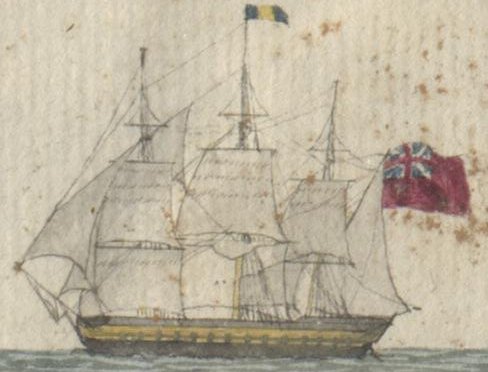
Vignette of the ship Neptune
|
True Briton: voyage 1804-1805; Lady Jane Dundas: voyage 1805-1807. |
|
|
| New York |
misc |
On Wednesday 4th July 1810 the American ship New York left Madeira. This could be a private ship since the US Navy ship New York was apparently at this time permanently moored in the Washington Navy Yard, She was burnt by the British on 24th August 1814. |
Lord Keith: voyage 1810-1811. |
|
|
| Newcastle |
misc |
A barge at Deptford noted by Captain Barker of the Northampton on 24th July 1801. |
Northampton: voyage 1801-1803. |
|
|
| Niemen |
Royal Navy |
A sloop with armament of 40. 1090 tons. "In 1809, the Amethyst chased & captured the French frigate Niemen, with the assistance of the Emerald. The Niemen became a great acquisition to the British Navy". See: https://sites.rootsweb.com/~pbtyc/18-1900/C/01156.html. Captain Rawes of the Juliana recorded her as arriving at St Helena on 26th May 1813 along with HMS Astrea. |
Juliana: voyage 1812-1813. |
|
|
| Nile lighter |
heics |
A lighter noted in the Journal of the True Briton as coming alongside at Longreach on Wednesday the 25th September 1805. |
True Briton: voyage 1804-1805. |
|
|
| Niobe |
Royal Navy |
A French frigate captured on 24th Aug. 1800, 5th rate, armament of 38, 1142 tons. Disposed of in 1816 while lying at Deptford. See: https://sites.rootsweb.com/~pbtyc/18-1900/C/01156.html. |
Juliana: voyage 1812-1813. |
|
|
| Nisus |
Royal Navy |
Launched 1810, 5th rate, armament 38, 1st July 1810, arrived at Madeira & sailed hence for the Cape. Broken up in 1822, See Wikipedia and rootsweb.com for more information. |
Lord Keith: voyage 1810-1811. |
|
|
<
| Northampton (2) |
HEICS |
An extra ship repaired by Mestaer 1801. Eight voyages are recorded, the last ending in 1819. She was noted in the log of the Georgiana as arriving at the Cape in convoy from the East on 30th December 1806. On 2nd February 1807 she was noted in the log of the Georgiana as leaving St Helena in convoy for England. For more details see under Northampton on this site. |
Georgiana: voyage 1803-1807. |
|
|
tr>
Northumberland (5) |
HEICS |
Built by Brent 1805. Length 135ft, 637 tons. She made six voyages to India. Noted in the log of the Georgiana as arriving at St Helena with stores from Cork on 13th December 1805. She sailed for the Cape on 28th January 1806. Noted by Captain Bayliff of the Huddart on her first, under Captain George Raincock. Her last recorded voyage was in 1817. |
Georgiana: voyage 1803-1807; Huddart: voyage 1806-1807. |
|
|
| Northumberland |
Royal Navy |
Built by Barnard, Deptford 1798, 3rd Rate, 1907 tons. Carried Napoleon to St Helena in 1815. Noted by Captain Rawes of the Warren Hastings at St Helena on 26th March 1816 along with HMS Havannah. A hulk from 1827, broken up 1850. See Wikipedia website:- Royal Navy Northumberland (5)
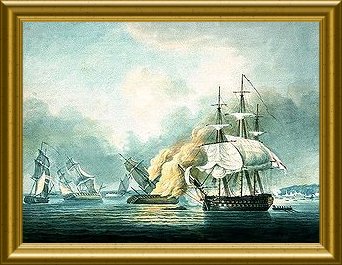
Royal Navy Northumberland (5)
Taken from Wikipedia.
|
Warren Hastings: voyage 1815-1816. |
|
|
|
O |
| Ocean (4) |
HEICS |
Caution is needed here as there were several ships of the same name sailing at roughly the same time, in Farrington they are numbered as 1, 2, 3, 4, 5 and 6. There is also in existance a whaler called Ocean.
Built by Pitcher, launched 1800, fourth of the name, length 165ft, 1273 tons. She made four voyages to China. Her second was Commanded by Captain Andrew Patton and her third by Captain John Williamson. She participated in the Battle of Aura on 14th February 1804. She was noted in the Indian Ocean by Captain Farrer of the Cumberland on Sunday 27th April 1806. She foundered on her fifth recorded voyage in 1811. |
Georgiana: voyage 1803-1807; Cumberland: voyage 1805-1806. |
|
|
| Ocean (5) |
HEICS |
Caution is needed here as there were several ships of the same name sailing at roughly the same time, in Farrington they are numbered as 1, 2, 3, 4, 5 and 6. There is also in existance a whaler called Ocean.
She was launched at Quebec in 1801 at 567 tons. Farrington gives no details of this ship other than the details of one voyage to New South Wales and China, which voyage commenced on 25 April 1803. She appears to have been a Country Ship and the Farrington entry reads: Portsmouth 25th April 1803, Rio de Janeiro 30th June 1803, Port Philip 7th October 1803, Port Jackson 26th August 1804, Whampoa 20th 1804. She was noted in the log of the Wexford as at Whampoa on 11th November 1803 Macao 24th January 1805, Malacca 25th February 1805 and St Helena 1st July 1805. Judging from their positions in 1803,4 & 5, this one appears to be the Ocean appearing in the Journal of True Briton, commanded by Captain John Mertho. On Sunday 20th January 1805 she was recorded as setting sail by Captain Hughes of the True Briton, when she met up again with the True Briton for the home leg.
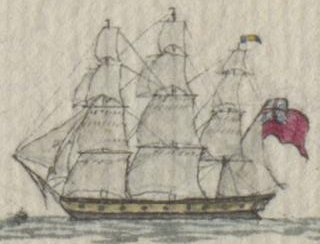
Vignette of the ship Ocean
|
Wexford: voyage 1803-1804; True Briton: voyage 1804-1805. |
|
|
| Ocean (6) |
HEICS |
Caution is needed here as there were several ships of the same name sailing at roughly the same time, in Farrington they are numbered as 1, 2, 3, 4, 5 and 6. There is also in existance a whaler called Ocean.
Repaired by Brent 1804, length 117ft, 532 tons. Five voyages are recorded by Farrington. Her first recorded voyage was between 1804-1806 India. On her return voyage she reached St Helena 22nd October 1805 and was noted in the log of the Georgiana as at St Helena on 1st November. She sailed for England on 4th November. On her second voyage she was commanded by Captain Thomas MacTaggart and was noted by Captain Bayliff of the Huddart and her fourth voyage, under the same Captain. Her last recorded voyage was in 1812. |
Georgiana: voyage 1803-1807; Huddart: voyage 1806-1807. |
|
|
| Ocean |
misc |
Caution is needed here as there were several ships of the same name sailing at roughly the same time, in Farrington they are numbered as 1, 2, 3, 4, 5 and 6. There is also in existance a whaler called Ocean.
She was possibly built at South Shields in 1794 and acted as a merchantman, supply ship, whaler, and transporter of convicts in Australia. She continued as a London-based transport until at least 1823. There is much detail concerning her on Wikipedia. Either this Ocean or the whaler was built at South Shields in 1794. She continued as a London-based transport until at least 1823. There is much detail concerning her on Wikipedia. The 'Botany Bay' whaler named Ocean is noted in the log of the Georgiana as arriving at St Helena on 1st July 1805 and departing on 11th September 1804 along with another whaler named Cornwall. She may the same 'whaler' that was noted in the log of the Lord Keith as at St Helena on 18th June 1811. |
Georgiana: voyage 1803-1807; Lord Keith: voyage 1810-1811. |
|
|
| Ocean |
misc |
Caution is needed here as there were several ships of the same name sailing at roughly the same time, in Farrington they are numbered as 1, 2, 3, 4, 5 and 6. There is also in existance a whaler called Ocean.
This Ocean was noted in the log of the Georgiana as in the South Atlantic on 27th April 1806 as a 'transport last from the Cape', possibly an English whaler. She may be the same ship as noted again in the log of the Geogiana as arriving in convoy at St Helena on 27th August 1806. |
Georgiana: voyage 1803-1807. |
|
|
| Orpheus |
Royal Navy |
Launched on the river Thames in 1780, 5th rate, armament 32, complement 217, 688 tons. Wrecked on the coral reef at Jamaica station under Captain Thomas Briggs on 23rd Jan 1807, her crew were saved. See: https://sites.rootsweb.com/~pbtyc/18-1900/C/01156.html, for her history. On Wikipedia there is a report of her disposal:- "Orpheus, under the command of Captain Thomas Briggs, arrived off Jamaica from England in the evening of 22 January 1807. Being short of water, Briggs decided to try to sail her into Port Royal, rather than wait for a pilot. Around midnight Orpheus grounded on a reef that was not accurately marked on her charts. Efforts to lighten her failed and she took on water. When the water reached her main deck, the crew took to the boats, abandoning her."

Mention of the Chiffonne, Orpheus and the Virginie
in the Hampshire Telegraph 18th April 1803.
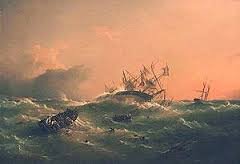
Orpheus in 1807
|
Northampton: voyage 1801-1803. |
|
|
| Orpheus |
HEICS |
Captain Rawes of the Warren Hastings records boarding this ship on Saturday 10th April 1824, as "from London 18 February with Troops for the Isle of France [Mauritius]". The website https://sites.rootsweb.com/~pbtyc/18-1900/C/01156.html, lists a Navy ship Orpheus as "Launched in 1809, 5th rate; Armament 36. It also records the disposal year as 1819. The next Royal Navy ship by the name Orpheus listed is launched in 1830. Mauritius came under British control in 1810. |
Warren Hastings: voyage 1823-1824. |
|
|
| Orynthia |
misc |
She departed London and arrived at Bombay on 1st February 1825. She had departed Bombay on 22nd February 1825 and arrived at Portsmouth on 9th June 1825 under Captain Holton. She departed London under Captain W Rixon and arrived at Singapore on 8th August 1827. She sailed from Singapore on 20th June 1829 under Captain W Rixon to Batavia and Singapore. The Lloyds Register 1838, states that she was built at Chepstow in 1823, her master was Captain Cox, she weighed 318 tons, Owned by Johnson's of London, sailing from London to Bermuda.
|
Repulse: voyage 1831-1832. |
|
|
|
P |
| Pandora |
Royal Navy |
a Cruiser-class sloop launched in 1813. She was noted at Penang by the Bridgewater on 10th July 1829. In Sept 1829 she departed for Madras and eventually England. She was sold in 1831. See https://sites.rootsweb.com/~pbtyc/18-1900/C/01156.html. |
Bridgewater: voyage 1828-1830. |
|
|
| Panther |
HEICS |
A Company cruiser that arrived at Point de Galle on Friday 13th March 1807. |
Earl St Vincent: voyage 1806-1807. |
|
|
| Paragon |
Royal Navy |
Launched Whitby in 1800. Between 1803 and 1805 she served as an armed coastal defender. In 1805 she became a 'transporter' to the Cape and was noted in the log of the Georgiana in the South Atlantic returning home to England from Cape on 13th February 1807. She was carrying General Sir David Baird 1757-1829, 1st Baronet Newbyth. She had left the Cape on the 19th January 1807 and arrived in England in March of that year. She later became a merchantman and was captured by the French 1814 only to be recaptured the same day. She served under the HEICS flag and was wrecked in March 1819. See Wikipedia. |
Georgiana: voyage 1803-1807. |
|
|
| Peace & Plenty |
misc |
An American ship noted in the log of the Georgiana as arriving at St Helena on Tuesday 21st Feb. 1804 from Bengal. She sailed from St Helena for America on the 28th. |
Georgiana: voyage 1803-1807. |
|
|
| Pearl |
Royal Navy |
A frigate launched at Chatham Dockyard in 1762, 6th rate, armament 32, length 125 feet, 683 tons. She served in North America until 1773 when she sailed to England. In 1776 she returned to serve in the American War of Independence until 1786 when she was transferred to the Mediterranean only to return the American scene. In 1802 she became a sloop and receiving ship in Portsmouth when noted by Captain Farrer of the Cumberland in 1805. She was sold in disposed of in 1832. See https://en.wikipedia.org/wiki/HMS_Pearl_(1762) for her history.
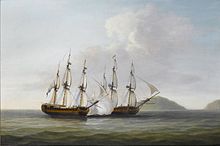
HMS Pearl engaging the Santa Monica 1779,
taken from Wikipedia.
|
Cumberland: voyage 1805-1806. |
|
|
| Penang Packet |
misc |
Probably a packet from Penang noted by Captain Campbell of the Lord Keith near Saugor. |
Lord Keith: voyage 1810-1811. |
|
|
| Perseverance lighter |
HEICS |
A lighter recorded by Captain Barker of the Northampton on Tuesday 29th March 1803 while unloading at Long Reach. |
Northampton: voyage 1801-1803. |
|
|
| Perseverance lighter |
misc |
A whaler noted in the log of the Georgiana as arriving at St Helena [from the South Seas] on 12th January 1806 along with the whaler Elliot. See Wikipedia for further information.
|
Georgiana: voyage 1803-1807. |
|
|
| Perseverance (2) |
HEICS |
Built by Pitcher, launched 1801, length 166ft, 1271 tons. She made seven voyages to the Far East. Noted in the journal of the True Briton as sailing from the Motherbank in convoy to the East on Saturday 9th June 1804, under Captain James Tweedale. On her third voyage, under Captain James Tweedale. Noted on 4th March 1906 as at Portsmouth as part of the convoy. On Thursday 8th May 1806 she parted Company at Lat 24.48S Long 13.46W and went her way. She was sold for breaking in 1819.
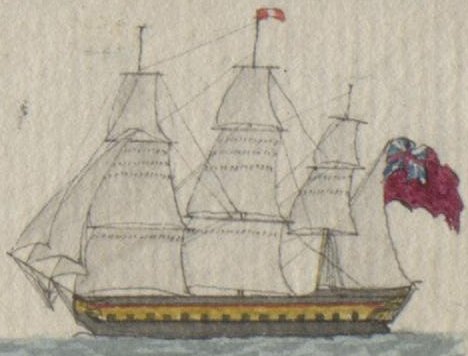
Vignette of the ship Perseverance
|
True Briton: voyage 1804-1805; Lady Jane Dundas: voyage 1805-1807. |
|
|
| Phaeton |
Royal Navy |
Built by John Smallshaw at Liverpool in 1782, Minerva-class 5th rate, armament 38, 944 tons. Recorded by Captain Harington of the Ganges as passing near Singapore from China on Monday 9th December 1805, her Commander at this time was Captain John Wood. See: https://sites.rootsweb.com/~pbtyc/18-1900/C/01156.html and https://en.wikipedia.org/wiki/HMS_Phaeton_(1782) for her detailed history. She was sold in 1828 for breaking.
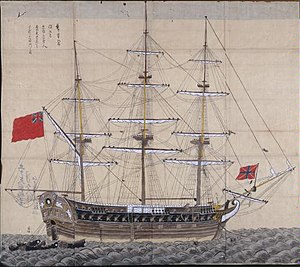
Contemporary Japanese drawing of HMS Phaeton
(Nagasaki Museum of History and Culture)
|
Ganges: voyage 1805-1807. |
|
|
| Phoenix (5) |
HEICS |
Built by Barnard, launched 1804, length 145ft, 592 tons. She sailed to India six times. Noted in the log of the Georgiana as sailing from St Helena to Bengal on 17th July 1805. Her commander was Captain John Ramsden. Captain Harington of the Ganges noted her at Saugor on Saturday 28th September 1805. She was noted again in the log as arriving in convoy at the Cape of Good Hope on 30th December 1806 and again when leaving in convoy for England on 2nd February 1807. Her last recorded voyage was in 1818. |
Georgiana: voyage 1803-1807; Ganges: voyage 1805-1807. |
|
|
| Phoenix |
Royal Navy |
The website https://sites.rootsweb.com/~pbtyc/18-1900/C/01156.html, records a number of ships called Phoenix, but does not appear to record this ship. Wikipedia records a Phoenix, built in 1783 as a 36-gun fifth rate. She was wrecked in 1816 in the Bay of Chisme near Smyma. Our Phoenix is mentioned by Captain Rawes of the Juliana on many occasions as being in convoy with the fleet to Batavia, where her Commander, Captain Bowen, is recorded as dying on Saturday the 26th December 1812. Captain Rawes then records her setting sail from Batavia to Madras on 30th December 1812. |
Juliana: voyage 1812-1813. |
|
|
| Pitt |
Royal Navy |
Schooner built in Portsmouth, purchased 1805, armament 12 (10x18-pounder carronades; 2xsixes), complement 54. 23-25 Oct 1806, after a 67 hour chase captured the celebrated French privateer Superbe. See: https://sites.rootsweb.com/~pbtyc/18-1900/C/01156.html, for the story of the capture. Captain Bayliff of the Huddart reported sighting the Pitt 26 December 1811 while of the coast of India and as she was approaching Bombay she pressed a number of the Huddart' crew. A hulk in 1853 she was finally broken up in 1877. |
Huddart: voyage 1806-1807. |
|
|
| Pitt |
Royal Navy |
Built by the East India Company of teak at the Bombay Dockyards in 1805. She was purchased by the Royal Navy and classified as a 5th rate frigate, armament 42. Captain Jones of the Earl St Vincent recorded her as arriving at Madras on Tuesday 25th November 1806. In October. under her commander Lieutenant Michael Fitton, she had succeeded in cornering the French privateer Superbe. She was recorded again by Captain Jones on Wednesday 10th December as patrolling off the coast of India and by Captain Harington of the Ganges on Saturday 28th February 1807 as passing him near Bombay. In 1807 she was renamed the Salsette. Her history is recorded by https://sites.rootsweb.com/~pbtyc/18-1900/C/01156.html, under both names. In 1835 she became a receiving ship at Woolwich and was broken up in 1874. |
Ganges: voyage 1805-1807; Earl St Vincent: voyage 1806-1807. |
|
|
| Plantagenet |
Royal Navy |
Designed by Sir Willim Rule, launched 22nd Oct 1801, 3rd rate, length 181ft, 1777 tons, 74 guns. Noted in the log of the Georgiana as arriving from England at St Helena on 19th May 1804. She was at St Helena on Wednesday 13th June 1804 and escorted the China fleet &c. back to England on the 18th June. Her Commander was Captain De Courcy. She was broken up in 1817. See: https://en.wikipedia.org/wiki/HMS_Plantagenet_(1801) for her history. |
Georgiana: voyage 1803-1804; Wexford: voyage 1803-1804. |
|
|
| Plassey |
misc |
A schooner noted in the Journal of the Solebay as arriving at Batavia from China on the 8th May 1765. She was probably named after the Battle of Plassey 7 years before which terminated French designs on India. |
Solebay: voyage 1804-1805. |
|
|
| Pluto |
Royal Navy |
A sloop launched in 1782, armament 18. Recorded in the journal of the Wexford when George Lea, John Tiffen and William Tully were pressed by the Pluto on 7th Aug 1804. She was sold but foundered on her way from Portsmouth to London at Foreness Rock on 31st Aug 1817 and filled with water. See https://sites.rootsweb.com/~pbtyc/18-1900/C/01156.html for her history. |
Wexford: voyage 1803-1804. |
|
|
| Polyphemus |
Royal Navy |
Built Sheerness, launched 27th April 1782, 3rd rate, armament 64, 1369 tons. She participated in the 1801 Battle of Copenhagen, the Battle of Trafalgar, and the Siege of Santo Domingo. See Wikipedia. She was noted by Captain Lindsay of the Lady Jane Dundas at Portsmouth on the 4th March 1806. She was probably on her way back from operations in the Rio de la Plata when she passed the Northampton on Sunday October 25th 1807. She was a powder hulk in 1813 and broken up in 1827. Built Sheerness, launched 27th April 1782, 3rd rate, armament 64, 1369 tons. She participated in the 1801 Battle of Copenhagen, the Battle of Trafalgar, and the Siege of Santo Domingo. See Wikipedia. She was probably on her way back from operations in the Rio de la Plata when she passed the Northampton on Sunday October 25th 1807. See https://sites.rootsweb.com/~pbtyc/18-1900/C/01156.html, for her story. In 1813 she became a powder hulk and was broken up in 1827.
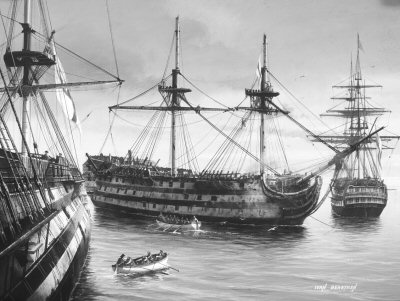
Royal Navy Polyphemus coming home with Royal Navy Neptune
and Royal Navy Victory after the Battle of Trafalgar.
|
Lady Jane Dundas: voyage 1805-1807; Northampton: voyage 1807-1809. |
|
|
| Porpoise |
Royal Navy |
Purchaed in 1804 as a store ship, formerly a merchant quarter-decked sloop, length 100ft 400 tons, called Lord Melville. She was noted in the log of the Georgiana as at Cape Town on 12th May 1806. She sailed to Botany Bay, Australia on 17th June 1806. She became the flag ship of Captain William Bligh who was trhen Governor of New South Wales. She was sold in 1816 and became a merchant ship again. Last listed in 1820. See Wikipedia. |
Georgiana: voyage 1803-1807. |
|
|
| Powerful |
Royal Navy |
Built by Perry at Blackwall, launched on 3rd April 1783. 3rd rate, armament 74, 1627 tons. See: https://sites.rootsweb.com/~pbtyc/18-1900/C/01156.html, for her history. she was at Madras on Wednesday February 17th 1808, see under Royal Navy Culloden. She was broken up in 1812. |
Northampton: voyage 1807-1809. |
|
|
| Preston |
HEICS |
Built by Barnard and launched 1798, length 138ft, 671 tons. She made six voyages to the East. Noted in the log of the Georgiana as arriving at St Helena on 14th August 1804. She sailed on the 11th September. Noted by Captain Harington of the Ganges on her fourth, under Captain Henry Sturrock. On Sunday 26th May 1805 she was off Madeira on her way to the East. She was noted again in the log of the Georgiana as arriving in convoy at the Cape of Good Hope on 30th December 1806, commanded by Captain Henry Sturrock. On 2nd February 1807 she was noted in the log of the Georgiana as leaving St Helena in convoy for England. In 1815 she sailed in a convoy from Jamaica to London. The convoy encountered a gale. A number of ships were not seen again including the Preston. See Wikipedia. |
Georgiana: voyage 1803-1807; Ganges: voyage 1805-1807. |
|
|
| Prince Henry |
HEICS |
Recorded in Farrington as the Company's packet, 167 tons, 26 crew with 6 guns. Noted by the Solebay as sailing from Bencoolen on Wednesday the 19th June 1765, commanded by Captain Johnson. |
Solebay: voyage 1764-1765. |
|
|
| Prince of Denmark |
HEICS |
Not recorded as a Company ship by Farrington. Noted by Captain Rawes of the Warren Hastings at St Helena on 27th March 1824. On the website: www.myancestorsstory.com/shiplist_19.html#princeofdenmark, a ship called the Prince of Denmark is recorded as a whaler in New Zealand in 1825, under Captain William Stewart, otherwise nothing known. |
Warren Hastings: voyage 1823-1824. |
|
|
| Prince of Orange |
misc |
A brig that collided with the Warren Hastings at Northfleet on 2nd April 1825. Ship is otherwise unknown. |
Warren Hastings: voyage 1825-1826. |
|
|
| Prince of Wales hoy |
HEICS |
A hoy recorded in the journal of the True Briton at Blackwall on Friday 10th February 1804. |
True Briton: voyage 1804-1805. |
|
|
| Prince of Wales |
misc |
A packet arrived at Bombay Monday 29th September 1806 from Bussorah (Basra) in Iraq and again on Monday 26th of January 1807. Possibly a sloop of 148 or 151 tons, with 14 guns, launched in 1805 at the Bombay Dockyard for the Bombay Marine. She had an active military career and after the end of the First Anglo-Burmese War (1822–24), was sold at public auction. See Wikipedia. |
Earl St Vincent: voyage 1806-1807. |
|
|
| Princess Amelia |
Royal Navy |
A frigate packet recorded by Captain Barker as arriving at St Helena on Monday 24th January 1803. On Wednesday 23rd March 1803, while off the Downs, a Lieut from her pressed a number of the Northampton's hands. |
Northampton: voyage 1801-1803. |
|
|
| Princess Amelia |
misc |
An American ship noted in the log of the Georgiana as arriving at St Helena on Friday 27th April 1804. |
Georgiana: voyage 1803-1807. |
|
|
| Princess Amelia (4) |
HEICS |
Built 1808, 166ft long, 1275 tons. Sailed to China at least 10 times. Noted by Captain Rawes of the Warren Hastings on her fifth voyage, under Captain Edward Balston. Her last recorded voyage was in 1825/6. |
Warren Hastings: voyage 1815-1816. |
|
|
| Princess Charlotte (2) |
HEICS |
There is a Princess Charlotte listed by Farrington as a chartered ship of 400 tons. Her only recorded voyage is to Bengal in 1819-20 under Captain William Vaughan. Captain Rawes records the ship Princess Charlotte 'from Brixham' near the English Channel on Wednesday 26th May 1824. |
Warren Hastings: voyage 1823-1824. |
|
|
| Princess Charlotte of Wales |
HEICS |
Built by Dudman, launched 1812, 3 decks, 121ft long, 978 tons. On her maiden voyage, her Captain was John Craig when on 7th May 1812 she sailed from Portsmouth with the Convoy. On her eighth voyage, when noted by Captain Dalrymple of the Vansittart she was commanded by Captain Christopher Biden. She was sold in 1831 for £3000 and broken up. |
Juliana: voyage 1812-1813; Vansittart: voyage 1826-1828. |
|
|
| Princess Mary (2) |
HEICS |
Extra ship, launched in 1796, repaired by Mestaer 1799. Length 116ft, 462 tons. Third voyage out of four recorded by Farrington. Commanded by Captain Andrew Grieve. Noted in the log of the Georgiana as arriving at St Helena on 18th October 1804 on her way to England. She sailed for England on 8th November 1804. In 1805 she became a West Indiaman and mostly sailed between London and Jamaica. She was broken up in 1816. |
Northampton: voyage 1801-1803; Georgiana: voyage 1803-1807. |
|
|
| Procris |
Royal Navy |
Launched 1807, Brig sloop; armament 18. She served in the second Battle of Copenhagen and in 1811 and also took part in the invasion of Java against the Dutch and French forces. See: rootsweb.com and Wikipedia. She set sail from Batavia to Madras from 25th December 1812. She was disposed of in 1815. |
Juliana: voyage 1812-1813. |
|
|
| Prospero Bomb |
Royal Navy |
Built 1803, type 'bomb' armament 8. She accompanied the Earl St Vincent in the English Channel from Sunday 23rd March 1806 till 26th March 1806. See: https://sites.rootsweb.com/~pbtyc/18-1900/C/01156.html. Her commander at the time was Captain Gustavus Stupart. She foundered off Dieppe in a storm on 18th Feb 1807 under her Commander William King, Captain King was drowned. |
Earl St Vincent: voyage 1806-1807. |
|
|
| Protector |
Royal Navy |
Built in rightlingsea, Essex in 1804, completed at Chatham as a gun brig, length 65ft, 177 tons. She was commanded by Lieutenant Thomas Morley Blainey when noted in the log of the Georgiana as arriving at Simons Bay, Cape of Good Hope from Madras on 29th July 1806. She was noted again in the same log as arriving at St Helena on 3rd September for going on to Buenas Ayres. She left St Helena for Buenas Ayres on 5th September with H.M.S. Adamant, Columbine, Diadem. She was sold for breaking in 1833. |
Georgiana: voyage 1803-1807. |
|
|
| Protector General |
misc |
A Portuguese ship noted in the log of the Georgiana in the South Atlantic near the Island of Ascension on 4th October 1806. She was from Lisbon bound for Rio Janeiro. |
Georgiana: voyage 1803-1807. |
|
|
| Prudent |
misc |
A French privateer captured 19th October 1805 by HMS Narcissis off the coast of Liberia. Noted in the log of the Georgiana on as arriving at St Helena on 1st February 1806. She appears to have sailed for the Cape of Good Hope on 5th February 1806. |
Georgiana: voyage 1803-1807. |
|
|
|
Q |
| Queen |
Royal Navy |
Built at Woolwich and launched 18th Sept 1769, 2nd rate, length 177ft, armament 98, complement 758, 1876 tons. She took part in the Battle of Trafalgar. Noted by Captain Jones of the Earl st Vinvent on Friday 19th April 1805 while off Motherbank (Isle of Wight). Broken up in 1822. See: https://sites.rootsweb.com/~pbtyc/18-1900/C/01156.html and https://en.wikipedia.org/wiki/Battle_of_Trafalgar for her history.
|
Ganges: voyage 1805-1807. |
|
|
|
R |
| Rambler |
misc |
A brig recorded in Wikipedia as a ship built in France and captured by the British in 1797. She assumed her name Rambler in 1803 when William Bennett purchased her as a whaler. She was noted in the log of the Georgiana as arriving at St Helena on 21st April 1804 after returning from a whaling expedition in the South Seas. She left St Helena on 4th May and arrived in London on 13th July. Her commander as this time was Captain Richards. She was recaptured by the French in 1807. |
Georgiana: voyage 1803-1807. |
|
|
| Ranger |
misc |
A whaler Not in the log of the Georgiana as arriving at St Helena on 18th January 1806. Recorded by Captain Sanders of the Northampton at St Helena on Wednesday September 28th 1808. |
Georgiana: voyage 1803-1807; Northampton: voyage 1807-1809. |
|
|
| Rattlesnake |
Royal Navy |
A 16 gun Royal Navy sloop from 1791. Noted at Madras by Captain Farrer of the Cumberland on Friday 13th Aug 1805. In 1806 she was involved, along with HMS Powerful, in the capture of the French privateer Bellone in the Indian Ocean. On 10th August 1806 she arrived at Diamond Harbour and on 17th August one of her Lieutenants impressed eleven of the crew of the Lady Jane Dundas, she sailed on Saturday 23rd. She was sold in 1814. |
Lady Jane Dundas: voyage 1805-1807; Cumberland: voyage 1805-1807. |
|
|
| Rebecca |
misc |
A whaler noted in the log of the Georgiana as arriving at St Helena on Monday 13th Feb. 1804. She departed on 26th Feb. Captain Farrer of the Cumberland noted her at St Helena on Wednesday 2nd July 1806. |
Georgiana: voyage 1803-1807; Cumberland: voyage 1805-1806. |
|
|
| Recovery |
misc |
This ship was noted in the Journal of the True Briton as sailing with the homeward-bound Convoy from St Helena on the 12th July 1805. There are a number of candidates on Wikipedia but the most likely is a 24-gun post ship launched in 1778 and after a number of adventures as the Hyaena, became a whaler in 1803. She was broken up in 1813.
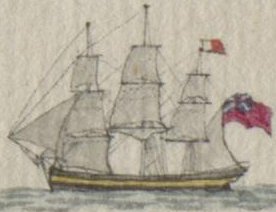
Vignette of the ship Recovery
|
True Briton: voyage 1804-1805. |
|
|
| Reliance |
HEICS |
A Country ship that arrived at Madras from Bengal on Wednesday 26th November 1806. |
Earl St Vincent: voyage 1806-1807. |
|
|
| Repulse |
HEICS |
Built by Wigram, launched 1820. Length 166ft, 1334 tons. At least six voyages to China. Noted on her second voyage by Captain Rawes of the Warren Hastings, under her commander was Captain John Paterson and again on her 3rd voyage. On her fourth voyage she was noted by Captain Dalrymple of the Vansittart, under Captain Charles Besly Gribble. She was noted in the journal of the Bridgewater at Whampoa on 19th October 1829 and again when she sailed for Hong Kong on Sunday 6th December 1829.
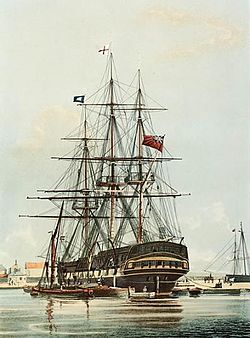
The Repulse.
|
Warren Hastings: voyage 1823-1824; Warren Hastings: voyage 1825-1826; Vansittart: voyage 1826-1828; Bridgewater: voyage 1828-1830.
|
|
|
| Resource |
HEICS |
A Country ship delivering 5327 chests of tea to the Bridgewater at Toun-koo on Tuesday 22nd December 1829. On the 24th she departed with 1292 bales of cotton. Nothing else is known of her. |
Bridgewater: voyage 1828-1830. |
|
|
| Resolution |
Royal Navy |
Believed to be one of the ships called Resolution, listed on the website: https://sites.rootsweb.com/~pbtyc/18-1900/C/01156.html. A cutter hired 1807; armament 8; disposed of in 1814. In 1809. the Vanguard, Cyan, and hired armed cutter Resolution, captured the Dutch ketch Jeltzomine den Rofke, the Tigress gun brig in company. Prize money was paid on the 13th December 1809. |
Juliana: voyage 1812-1813. |
|
|
| Resolution of Aberdeen |
misc |
A page found on the Internet taken from the Edinburgh Advertiser dated 9th October 1821. The page has obviously been scanned in without correction, this an attempt at translation: "The Resolution of Aberdeen, McGregor, from ijusa[??] to London, was driven on shore on Tuesday night near Cucq." She was noted by Captain Rawes of the Warren Hastings at North Fleet on 10th April 1823 when at "At half past 5pm The Resolution of Aberdeen came athwarthause & carried away our Jib Boom & Dolphin Striker. |
Warren Hastings: voyage 1823-1824. |
|
|
| Retreat |
HEICS |
Built by Perry and launched 1805, length 116ft, 505 tons. Made at least five voyages to the Far East, of which this was her first, under Captain William Hay. On Friday 3rd May 1805 letters were sent to her from the Ganges while in the English Channel. She was noted in the log of the Georgiana as arriving at St Helena from England on 28th January 1806, carrying the news that Admiral Lord Nelson had died. She sailed for England from St Helena on 1st February 1806. |
Ganges: voyage 1805-1807; Geogiana: voyage 1803-1807. |
|
|
| Richmond lighter |
HEICS |
A lighter noted in the Journal of the True Briton as coming alongside at Longreach on Tuesday the 17th September 1805. |
True Briton: voyage 1804-1805. |
|
|
| Richmond |
misc |
An American brig noted in the log of the Georgiana arriving at St Helena on 22nd July 1804, she was from Virginia on her way to Isle de France. She moored the following day. The following item appears in the Georgiana's log on 6th August: 'Sent an officer with most of our people on board the American brig Richmond to get her ready for sea. She being detained by Government'. She departed for England in convoy on 13th August 1804. |
Georgiana: voyage 1803-1807. |
|
|
| Robart |
misc |
A whaler noted in the log of the Georgiana as arriving at St Helena from the west coast of Patagonia on 19th February 1806.
|
Georgiana: voyage 1803-1807. |
|
|
| Roger William |
misc |
A schooner noted in the log of the Georgiana as arriving at St Helena from Rhode Island on 31st December 1805. She sailed from St Helena on 10th February 1806.
|
Georgiana: voyage 1803-1807. |
|
|
| Rolla |
misc |
A brig built at Sough Shields launched 18th July 1800, 450 tons. She was a private merchantman but also sailed under the flag of the East India Company to the Far East and is associated with Botany Bay, noted in the log of the Georgiana as arriving at St Helena on 11th July 1804. She departed for England in convoy on 13th August 1804. She is possibly the same brig that is noted in the same log on 29th May 1806, while the Georgiana was at Cape Town. No longer listed after 1858. See Wikipedia for her history.
|
Georgiana: voyage 1803-1807. |
|
|
| Romney |
Royal Navy |
4th rate quarter decked. Launched at Woolwich in 1762. 1046 tons. Noted in the Log of the Georgiana as at the Mother Bank on Monday 22nd August 1803; her commander was Captain William Browne. She stayed with the Convoy until it reached St Helena. Wrecked on the Haaks near Texel on 19th November 1804. See rootsweb.com & Wikipedia for more information.
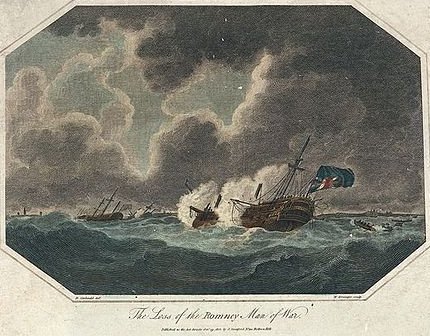
HMS Romney wrecked in a storm.
from Wikipedia.
|
Georgiana: voyage 1803-1807. |
|
|
| Rose (4) |
HEICS |
Built 1810, 950 tons. Made at least nine voyages to India and two to China. Noted by Captain Rawes of the Warren Hastings off the coast of the Isle of Wight on 21st March 1819, under Captain Thomas MacTaggart. |
Warren Hastings: voyage 1819-1820. |
|
|
| Rose |
misc |
Described by Captain Sanders of the Northampton as a transport ship which joined the convoy at Madeira. This could be a sloop called the Rose E with an armament of 18. She was taken on by the Royal Navy in 1805 and was disposed of in 1817. |
Northampton: voyage 1807-1809. |
|
|
| Royal Charlotte (5) |
HEICS |
Built by Pitcher, launched 1796. length 176ft, 1453 tons. Noted on Thursday 12th April 1804 at Portsmouth as from Gravesend in the journal of the True Briton, her commander was Captain Richard Francklin. On 17th October 1806 she was noted by Captain Lindsay of the Lady Jane Dundas as at Penang. Her eighth and last recorded voyage was in 1814. See Wikipedia for more information.
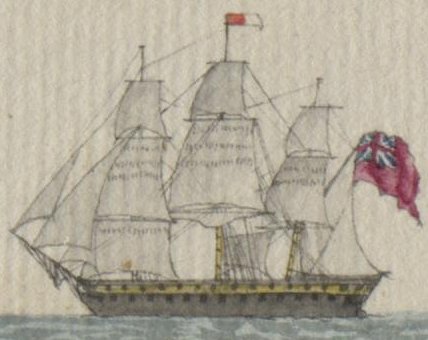
Vignette of the ship Royal Charlotte
|
True Briton : voyage 1804-1805; Lady Jane Dundas: voyage 1805-1807; Huddart: voyage 1806-1807. |
|
|
| Royal George (4) |
HEICS |
Built by Perry, launched 1802, length 165ft, 1260 tons, fourth of her name. Seven voyages to China are recorded. On her maiden voyage, under Captain John F Timins she was recorded in the journal of the Wexford as at Whampoa on 3rd December 1803. On Friday 30th May 1806 Captain Farrer of the Cumberland noted her, under her commander Captain Charles Besly Gribble, in the Indian Ocean. Recorded again on her 6th voyage, again under Captain Gribble, by Captain Rawes of the Warren Hastings. |
Wexford: voyage 1803-1804, Cumberland: voyage 1805-1806; Juliana: voyage 1812-1813; Warren Hastings: voyage 1815-1816. |
|
|
| Royal George (5) |
HEICS |
Built by Wigram and launched in 1820. 166ft long, 1333 tons. On her third recorded voyage to China she was noted by Captain Rawes of the Warren Hastings, under Captain Christopher Biden. Captain Rawes noted her near to Whampoa on 13th Sept 1823. Her last recorded voyage was in 1824/5 when on the 24th December 1825 (Christmas Eve), while at Whampoa, she caught fire and exploded. Her crew were saved and her log book has survived. This event was observed & assisted by the crew of the Warren Hastings. |
Warren Hastings: voyage 1823-1824. |
|
|
| Royal George |
HEICS |
Built 1820, 166ft long, 1333 tons. Sailed to China at least three times. On her third and last voyage under Captain Charles Sheldon Thomas. On the 24th December 1825, (Christmas Eve) while at Whampoa, she caught fire and exploded. Her crew were saved and her log book has survived. This event was observed & assisted by the crew of the Warren Hastings on the 24th. |
Warren Hastings: voyage 1825-1826. |
|
|
| Royal George (5) |
Royal Navy |
Built in Deptford by Phineas Pett the Younger and Launched on 3rd December 1670 as 100 gun 1st rate flagship called HMS Prince. Rebuilt in 1692 and renamed as Royal William, rebuilt again in 1719 and rearmed to 84 guns. 1st rate, 1918 tons. Fitted as a guard ship in 1790 and moored at Spithead from at least 1799 and was then moved to Portsmouth. She was mentioned in the Absence Book of the Ganges and may suggest that the Royal William was still at Spithead in October 1807. HMS Royal William was broken up in 1813. See: https://en.wikipedia.org/wiki/HMS_Prince_(1670) for her history.
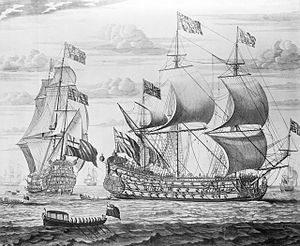
Sketch of the Royal William when she was called the Prince.
Copied from Wikipedia.
|
Ganges: voyage 1805-1807. |
|
|
| Ruby (4) |
HEICS |
A Country ship built in Calcutta, launched 1800, 248 tons. She was noted in the log of the Georgiana as passing up river Gravesend on Tuesday 2nd August 1803. She had just arrived from Calcutta on her only recorded voyage in Farrington, commanded by Captain John Hutching. Subsequently she traded in the Far East and Australia. May have been lost on sandbanks in 1818 or 1820. See Wikipedia for more information.
|
Georgiana: voyage 1803-1807. |
|
|
| Russell |
Royal Navy |
Launched at Deptford on 10 November 1764. 3rd rate, armament 74, 1642 tons, complement of 594. She left Penang on Thursday 3rd October 1805 with a fleet commanded by Sir Edward Pellew. At Madras on Sunday March 6th 1808 when she acted as escort for the Northampton and other HEICS ships. At Madras on Sunday March 6th 1808 when she sailed with the Northampton and other HEICS ships. See: https://sites.rootsweb.com/~pbtyc/18-1900/C/01156.html, for her history. Disposed of in 1811. |
Cumberland: voyage 1805-1806; Northampton: voyage 1807-1809. |
|
|
|
S |
| St Jago |
misc |
A Spanish brig noted in the journal of the True Briton on Wednesday 25th July 1804 in the South Atlantic. She was on her way from Cuba to Montevideo. There is a port on Cuba called St Jago. |
True Briton: voyage 1804-1805. |
|
|
| Saint (San) Fiorenzo |
Royal Navy |
A 40-gun frigate originally the Minerve under the French flag. She was recommissioned into the Royal Navy as a 38-gun fifth rate, armament 38, complement 253, 1032 tons. She was scuttled by the French at Saint-Florent off Corsica in 1797 but the British managed to refloat her. She became a valuable asset to the British in the Napoleonic Wars, see Wikipedia for more details. She also captured the Piémontaise among other ships in 1808. On Tuesday 15th October 1805 she was spotted in the Bay of Bengal by Indiamen Ganges and Dorsetshire. On Thursday 3rd July 1806 she was recorded by the Captain of the Lady Jane Dundas at Diamond Harbour as joining the Convoy at Diamond Harbour on Thursday 3rd July 1806, she departed Tuesday 8th July 1806. She is recorded by Captain Sanders as arriving at St Helena on Wednesday 19th October 1808. She was disposed of in 1837. For her history see: https://sites.rootsweb.com/~pbtyc/18-1900/C/01156.html and https://en.wikipedia.org/wiki/HMS_St_Fiorenzo_(1794).
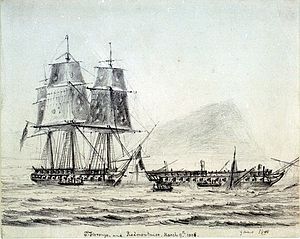
HMS Saint Fiorenzo and Piémontaise.
|
Ganges: voyage 1805-1807; Northampton: voyage 1805-1807; Lady Jane Dundas: voyage 1805-1807. |
|
|
| Saint Vincent |
misc |
A whaler noted in the log of the Georgiana at arriving at St Helena on 11th August 1805. |
Georgiana: voyage 1803-1807. |
|
|
| Salamanca |
misc |
A brig noted in the journal of the Bridgewater on Monday 8nd June 1829 at Saugor. She was employed transporting cargo from Calcutta to the ship at Saugor. |
Bridgewater: voyage 1828-1830. |
|
|
| Salvador de Mundo |
Royal Navy |
A Spanish ship of the line built at Ferrol, launched 2nd May 1787, one of eight Santa Ana class ships. She was also known as the Los Meregildos. She served in the French Revolutionary Wars until she was captured at the Battle of Cape St Vincent on 14th February 1797. Note in the Ledger of the Wexford that William Cocker, Seaman was pressed by HMS Salvador de Mundo on 13th Oct 1804. She was sold and broken up in 1815. See https://en.wikipedia.org/wiki/Salvador_del_Mundo_(ship) for her history.
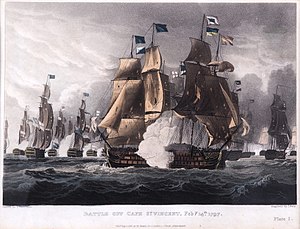
The Salvador de Mundo and HMS Victory at the Battle of Cape St Vincent. |
Wexford: voyage 1803-1804. |
|
|
| Samdany |
HEICS |
A Country ship noted in the journal of the Bridgewater at arriving at Whampoa, along with the Mary on Sunday 10th January 1830. On 21st September 1846, she was driven ashore at Saugor, while on a voyage from Calcutta to Ceylon. |
Bridgewater: voyage 1828-1830. |
|
|
| Sampson |
misc |
An American ship noted in the log of the Georgiana as arriving at Simons Bay, Cape of Good Hope from Madeira on Wednesdy 4th June 1806. |
Georgiana: voyage 1803-1807. |
|
|
| Sampson |
Royal Navy |
H.M.S. Sampson was noted in the log of the Georgiana as arriving at St Helena on 27th January 1807. On the 30th an officer and 116 men were loaned to assist the Georgiana to get ready for sail. Her commander is named as Captain Cuming. On 2nd February 1807 she escort a merchant fleet back to England. There is a article on the distinguished Captain Cuming in Wikipedia in which HMS Sampson is noted as the flagship of Rear-Admiral Charles Stirling. The history of the ship however has not been traced. The only Royal Navy ship called Sampson that was a 3rd rate ship of the line launched in 1781, however this ship was apparently designated a hulk by 1802, so we are left with a question mark on the origins and history of this ship. |
Georgiana: voyage 1803-1807. |
|
|
| Samuel |
misc |
A coal barge noted at Balckwall by Captain Campbell of the Lord Keith on 11th April 1810. |
Lord Keith: voyage 1810-1811. |
|
|
| Santa Cruz |
misc |
An English coasting ship recorded by Captain Harington of the Ganges off the southern tip of Malasia on Friday 13th December 1805 as sailing from Balambanger Island bound for Malacca. |
Ganges: voyage 1805-1807. |
|
|
| Santa Rosario |
misc |
Portuguese from Lisbon. Noted by Captain Rawes of the Warren Hastings in the South China Sea on 13th Sept 1815. |
Warren Hastings: voyage 1815-1816. |
|
|
| Sapho |
misc |
Noted by Captain Rawes of the Warren Hastings in the mid Atlantic on 19th May 1826 where he described her as "A ship from Bordeaux bound for Lima". |
Warren Hastings: voyage 1825-1826. |
|
|
| Sarah |
misc |
Described by Captain Gribble as a wreck [damaged] buoy a Collier brig on Saturday 19th Feb 1831 when she collided with the Repulse at Gravesend. Her master was John Richardson. |
Repulse: voyage 1831-1832. |
|
|
| Sarah Christiana |
HEICS |
Built by Randall 1798. length 124ft, 557 tons. On her second voyage to India out of five recorded by Farrington she was commanded by Captain Charles Graham and noted by Captain Barker of the Northampton and again on her fourth voyage by Captain Sanders of the Northampton, under Captain Thomas Mackeson. She was also noted in the log of the Georgiana as arriving at The Cape from Batavia on 11th December 1806, she sailed on the 24th December. Her last recorded voyage was in 1809. |
Northampton: voyage 1801-1803; Georgiana: voyage 1803-1807; Northampton: voyage 1807-1809. |
|
|
| Sarah Bolt lighter |
HEICS |
A lighter that came alongside the True Briton at Longreach on Friday 25th October 1805. |
True Briton: voyage 1804-1805. |
|
|
| Scaleby Castle |
HEICS |
Built at Bombay 1798, 163ft 6½in long, 1242 tons. Sailed to China at least 17 times. On her third voyage, under Captain John Guise, Captain Harington of the Ganges noted her at Whampoa on Friday 31st January 1806 and Captain Farrer of the Cumberland noted her in the Atlantic on Friday 20th June 1806. On her fourteenth voyage under Captain David Rae Newall she was noted by Captain Rawes of the Warren Hastings She was also noted by Captain Dalrymple of the Vansittart. The Scaleby Castle's launch was noted in the journal of the Bridgewater at Whampoa on Tuesday 29th September 1829. She was noted again on Thursday 24th December when signal 369 was raised (signal suggesting mutiny) and a manned and armed boat, with officers 2nd, 4th & 5th boarded her and "found the ship in a state of mutiny, succeeded in getting two of the ringleaders into a boat and sent them to the Commodore, the Officers of the Fleet assembled and after punishing five men with six dozen lashes each, restored tranquillity of the ship". had to be sent to her last voyage was her seventeenth in 1832/3. In the 1840's she was involved in shipping opium to China, see Google Books for more details. |
Ganges: voyage 1805-1807; Cumberland: voyage 1805-1806; Warren Hastings: voyage 1825-1826; Vansittart: voyage 1826-1828; Bridgewater: voyage 1828-1830. |
|
|
| Sceptre |
Royal Navy |
Built at Deptford by Dudman after a design by Sir William Rule and launched in December 1802. 3rd rate, armament 74, 1727 tons. Recorded by the Wexford near to Penang on 28th February 1804. Noted in the log of the Georgiana as arriving at St Helena on 9th June 1804, escorting a large fleet of merchant ships from the Far East. Noted in the same log as departing St Helena on 3rd July 1804 for China. Noted by Captain Harington of the Ganges as arriving at Madras on Sunday 1st September 1805. She served in the Napoleonic Wars and the War of 1812. She left Penang on Thursday 3rd October 1805 with a fleet commanded by Sir Edward Pellew. She was sighted by Captain Jones of the Earl St Vincent and Captain Bayliff of the Huddart off the coast of India on Tuesday 24th February 1807, at the time her Captain was probably Joseph Bingham. She was broken up in 1820. For her history see Wikipedia and the website: rootsweb.com. |
Wexford: voyage 1802-1803; Georgiana: voyage 1803-1807; Cumberland: voyage 1805-1806; Ganges: voyage 1805-1807; Earl St Vincent: voyage 1806-1807; Huddart: voyage 1806-1807. |
|
|
| Scorpion |
misc |
A whaler noted by Captain Jones of the Earl St Vincent on Saturday 20th June 1807 and also by Captain Lindsay of the Lady Jane Dundas on the 27th June 1807, as setting sail under convoy from St Helena for England, otherwise not traced. |
Earl St Vincent: voyage 1806-1807; Lady Jane Dundas: voyage 1805-1807. |
|
|
| Sea Bird |
misc |
A sloop at Culpee recorded by Captain Sanders of the Northampton on Thursday May 26th 1808. |
Northampton: voyage 1807-1809. |
|
|
| Sea Horse |
misc |
A three-masted merchant ship of 293 tons built at Gravesend in 1782 for the Hudson Bay Company. She had ten years trading with the native Americans and was then sold to a London ship owner. After having various adventures, she was converted as a south-sea whaler, during this time she was noted in the log of the Georgiana as arriving at St Helena on 17th March 1804. She departed on 1st April 1804. Later on she was converted again, this time as a troop ship. In 1815, along with the Lord Melville and the Boadicea she foundered in a storm off the coast of Ireland with the loss of hundreds of men, women and children. See various websites including: https://www.liverpool.ac.uk/~cmi/books/miscWr/tramore.html |
Georgiana: voyage 1803-1807. |
|
|
| Sea Horse |
Royal Navy |
Launched at Stalkart's Yard, Rotherhithe 1794. Frigate, 998 tons, armament 38, complement 281. She took part on the attack on Santa-Cruz, Tenerife in which Lord Nelson lost his arm. She was the HM convoy ship on the 1801 voyage to India. See: https://sites.rootsweb.com/~pbtyc/18-1900/C/01156.html, for her history. She was disposed of in 1819. |
Northampton: voyage 1801-1803. |
|
|
| Semeramis |
misc |
An American ship noted in the log of the Georgiana as arriving at St Helena from the Cape of Good Hope with stores for the Island on 14th April 1805. |
Georgiana: voyage 1803-1807. |
|
|
| Seringapatam |
misc |
She was noted in the log of the Georgiana at arriving at St Helena on 5th March 1804. She was noted again in the log on 6th December 1805 as arriving at St Helena. The following was taken verbatum from an excellent history of her in Wikipedia. 'She was built in [the Bombay Dockyard, about 336 tons] in 1799, of teak, as a warship for Tippu Sultan, the ruler of Mysore. However, the British stormed his citadel at Seringapatam that year and he was killed in the action. The vessel was sailed to England in the hopes that the Admiralty would buy it. The Admiralty did not, and British merchants bought her to use as a whaler. She made six voyages to the Southern Atlantic and the Pacific until 1813, on her sixth voyage, when during the War of 1812, a US frigate captured her. She served briefly as a tender to the frigate before mutineers and British prisoners recaptured her and sailed to Australia. After her return to her owners, she returned to whaling until 1846, making another nine voyages. She then sailed between London and New South Wales until 1850. In the 1850s and 1860s she sailed to Aden and Hamburg, ending her years trading between Shields and Quebec.' She is no longer listed in 1870.' She was recorded in the log of the Georgiana as arriving at St Helena on 5th March 1804. She departed St Helena in convoy on 1st April 1804. Her commander was Captain John Bird. |
Georgiana: voyage 1803-1807. |
|
|
| Sesostris |
--- |
Built by James Shephard, Paull, Hull, launched 2 March 1818. Length 119ft 8in, beam 30ft 5in, 488 tons. She traded with India, the Baltic and Russia, carried troops and convicts. See https://en.wikipedia.org/wiki/Sesostris_(1818_ship). On 5th Aug 1827 she sailed to Bombay, commanded by Captain Boucher. She was noted in the journal of the Bridgewater as at Bombay on Sunday 19th April 1829. She was broken up in 1843. |
Bridgewater: voyage 1828-1830. |
|
|
| Sherburne |
HEICS |
Probably the Sherbourne, a Company ship, described by Farrington as a chartered ship of 645 tons, owned by Smart & Co. In 1833 this ship sailed to Bengal under Captain Joseph Corbyn. This was her only recorded voyage by Farrington. Noted in the journal of the Bridgewater as a 'Country ship' at Whampoa on Thursday 13th Aug 1829. Also noted by Captain Gribble of the Repulse at Penang on 16th August 1831. |
Bridgewater: voyage 1828-1830; Repulse: voyage 1831-1832. |
|
|
| Sir Charles McCarthy |
misc |
A brig on voyage to Demerara under Captain Coast. Under the Calcutta Monthly Journal for July 1836, she is listed as sailing to Mauritius. In 1837 she is listed, if the same ship, as sailing between Launceston, Tasmania to Glenelg in Australia.

Distant View Of The Landing Place And Iron Stores At Port Adelaide
with The South Australian Company's Store ship Sir Charles McCarthy At Anchor.
This ship was stranded in Holdfast Bay in October 1837.
The wreck was bought for whaling but was used as a floating depot due to the difficulty of landing goods here.
Copied from:- http://thebertonandeastbridge.onesuffolk.net/thebarton/william-light-painting.
|
Warren Hastings: voyage 1825-1826. |
|
|
| Sir Edward Hughes |
Royal Navy |
She started her life as an East Indiaman. In 1804 she was sold to the Royal Navy and commissioned as a 38-gun frigate. On 30th July 1806 Richard Gayes, Seaman was transferred from the Ganges to the Sir Edward Hughes. At the time she was commanded by Captain Edward Ratsay. Captain Farrer of the Cumberland recorded her on 24th October 1805 as part of the fleet leaving Malacca under the Escort of HMS Blenheim. She became a store ship called Tortoise in 1807 as a 5th rate, armament 38, 962 tons. In 1844 she became a receiving ship at Ascension Island. She was lost there in 1859, or broken up there in 1860, or 1863. Details from: https://sites.rootsweb.com/~pbtyc/18-1900/C/01156.html and https://en.wikipedia.org/wiki/Sir_Edward_Hughes_(1784_EIC_ship). |
Cumberland: voyage 1805-1806; Ganges: voyage 1805-1807. |
|
|
| Sir Francis Drake |
Royal Navy |
Purchased 1805, 5th rate frigate, armament 38. Noted by Captain Campbell of the Lord Keith on route from Madeira to Bengal on 18th November 1810. In 1811 she took part in the invasion of Java. Departed Devonport for Chatham to be paid off and disposed of in 1825. |
Lord Keith: voyage 1810-1811. |
|
|
| Sir Godfrey Webster |
HEICS |
Repaired by Mestaers, measured 1811, 2 decks, 121ft long, 518 tons. This is her only recorded voyage under the Company's flag. Her Captain was James Pearson. On 7th May 1812 she sailed with the Convoy from Portsmouth. In 1823, she, or her successor, is recorded as a convict ship. See Convict Records . |
Juliana: voyage 1812-1813. |
|
|
| Sir Stephen Lushington |
HEICS |
Built by Randall 1796, length 129ft, 608 tons. Noted in the log of the Georgiana as arriving at St Helena on 8th March 1804. She was from Saugor bound for England, commanded by Captain George Gooch. She left St Helena in convoy on the 1st April 1804. Noted by Captain Campbell of the Lord Keith in the mid Atlantic on 26th July 1810 her seventh and last recorded voyage to India. Commanded by Captain James Hay. See Google books for more information. |
Georgiana: voyage 1803-1807; Lord Keith: voyage 1810-1811. |
|
|
| Sir William Bensley |
HEICS |
Built by Bayley at Ipswich 1802, length 125ft, 547 tons. Noted by the True Briton as sailing from St Helena with the Convoy back to England on 12th July 1805, commanded by Captain Robert Rhode. Noted by Captain Lindsay of the Lady Jane Dundas at Portsmouth on 4th March 1806 as part of the outward bound convoy. There is one more recorded trip in 1812/3. In 1816 she was transporting convicts to Australia arriving at Port Jackson, New South Wales 10th March 1817 with 199 passengers under Captain Lew E Williams. Sir William Bensley was a Director of the HEICS.
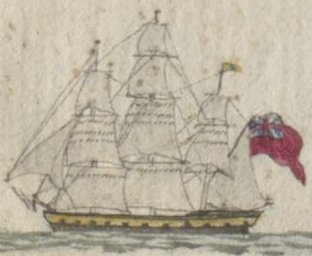
Vignette of the ship Sir William Bensley
|
True Briton: voyage 1804-1805; Lady Jane Dundas: voyage 1805-1807; Lord Keith: voyage 1810-1811. |
|
|
| Sir William Pulteney |
HEICS |
Repaired by Barnard in 1805, length 123ft, 656 tons. Seven voyages are recorded to India. Noted in the log of the Georgiana as arriving at St Helena on 25th June 1804 on her way from Bengal to England. She departed St Helena on 8th July 1804. She sailed from England between 1805 and 1807 and she was at Bombay May and June 1806. Her commander was Captain Henry Christopher. One of the charter passengers of the Earl St Vincent was George Grassley, 3rd mate of the Sir William Pulteney, who was picked up at Bombay 28th day of January 1807. On 2nd February 1807 she was noted in the log of the Georgiana as leaving St Helena in convoy for England. She landed at Gravesend September 10. For more details of George Grassley, see under the passenger entry on page 14. She was noted again in the log of the Georgiana at arriving at the Cape in convoy from the East on 30th December 1806. She was also noted by Captain Sanders of the Northampton at Madeira on 4th October 1807 and by Captain Campbell of the Lord Keith. |
Georgiana: voyage 1803-1807; Earl St Vincent: voyage 1806-1807; Northampton: voyage 1807-1809, Lord Keith: voyage 1810-1811. |
|
|
| Sirus? |
misc |
or Sirens - A whaler noted in the log of the Georgiana as arriving at St Helena on 20th March 1806. |
Georgiana: voyage 1803-1807. |
|
|
| Sisters Way |
misc |
Assumed to be a small boat used for ferrying cargo in the East India dock, London, on the 18th September 1807, in this case wine. |
Huddart: voyage 1806-1807. |
|
|
| Skelton Castle hoy |
HEICS |
Built by Wells and launched 1800, length 129ft, 583 tons. Four voyages are recorded to India. Noted in the log of the Georgian as arriving at St Helena on 28th August 1805. While at St Helena the carpenter of the Georgiana spent much time working on the Skelton Castle. She sailed for England on 4th November. Her commader was Captain James Normand. On her next voyage under Captain Henry Vaughan she was approaching the Cape of Good Hope on on her outward bound vayage and parted company from the Union on 21st December 1806 and was not heard of again. |
Georgiana: voyage 1803-1807. |
|
|
| Smith hoy |
HEICS |
A hoy or barge noted by Captain Rawes of the Warren Hastings at North Fleet on 29th March 1823. |
Warren Hastings: voyage 1823-1824. |
|
|
| Snow |
HEICS |
A Country Ship noted in the Journal of the Solebay as at Batavia on Sunday April the 7th 1765. Her name could be generic term for sailing under licence. |
Solebay: voyage 1764-1765. |
|
|
| Snow |
misc |
On Wednesday 9th February 1803 the journal records that "The Snow - Friends of Liverpool - Jones Master, bound to Dublin collided with the Wexford at 5.30 AM". |
Wexford: voyage 1803-1804. |
|
|
| Sophia |
misc |
Described by Captain Dalrymple as a wreck at Saugor on Sunday August 19th 1827. Not traced. |
Vansittart: voyage 1826-1828. |
|
|
| Sophia |
misc |
A Dutch Brig from Antwerp bound for Batavia recorded by Captain Dalrymple of the Vansittart on Monday 25th Feb 1828. |
Vansittart: voyage 1826-1828. |
|
|
| Southampton |
Royal Navy |
Built Deptford Dockyard, launched 7th November 1820, fourth rate Southampton-class frigate, 52 guns, Noted by the Bridgewater at Saugor on Friday 23rd April 1830. In 1912 she was sent to Blyth to be broken up. See https://en.wikipedia.org/wiki/HMS_Southampton_(1820). |
Bridgewater: voyage 1828-1830. |
|
|
| Sovereign (2) |
HEICS |
Built by Randall 1801. length 132ft, 617 tons. Seven voyages are recorded. Her maiden was under Captain Gilbert Mitchell, noted by Captain Barker of the Northampton. Noted by the True Briton as sailing from St Helena with the Convoy back to England on 12th July 1805, commanded by Captain Richard Meriton. She was also noted on 26th February 1807 by Captain Lindsay of the Lady Jane Dundas as leaving in convoy from Saugor to Point de Galle. Her third, under Captain Alexander Campbell was noted by Captain Harington of the Ganges who recorded her as arriving at Point de Galle from Bengal on Sunday 15th March 1807. On Friday 20th March her mast was struck by lightning, and carpenters were sent on board for inspection. Also noted on this voyage by Captain Bayliff of the Huddart and Captain Jones of the Earl St Vincent. Her last recorded voyage was in 1816.
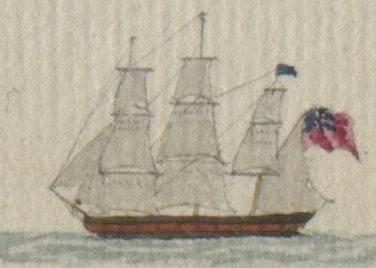
Vignette of the ship Sovereign
|
Northampton: voyage 1801-1803; True Briton: voyage 1804-1805; Lady Jane Dundas: voyage 1805-1807, Ganges: voyage 1805-1807, Huddart: voyage 1806-1807; Earl St Vincent: voyage 1806-1807. |
|
|
| Spinder |
HEICS |
Described as a HEICS Country ship at Madras on 26th February 1807. |
Huddart: voyage 1806-1807. |
|
|
| Spritley/Spritely |
misc |
A whaler noted in the log of the Georgiana as arriving at St Helena on the 1st May 1804. . |
Georgiana: voyage 1803-1807. |
|
|
| Star |
misc |
A whaler noted in the log of the Georgiana as part of the Convoy which left the Motherbank in late August 1803. The Star left the Convoy to head south on Monday 12th September 1803. She is mentioned again in the same log as arriving at St Helena on 10th March 1805, presumably on her return journey from the South Seas. |
Georgiana: voyage 1803-1807. |
|
|
| Streatham (4) |
HEICS |
Built by Dudman and launched in 1805, 143ft, 819 tons. Seven voyages are recorded by Farrington. Noted in the log of the Georgiana as arriving from India in convoy at the Cape of Good Hope on 30th December 1806, her commander was Captain John Dale. She was referred to again on the 23rd January 1807 while the Georgiana was at St Helena. On 2nd February 1807 she left St Helena in convoy for England. On her second voyage she was captured by the French but regained by the Rotal Navy. She was broken up in 1821. |
Georgiana: voyage 1803-1807. |
|
|
| Success |
HEICS BPS |
A British Pilot Service sloop noted in the journal of the Bridgewater on Monday 25th May 1829. She was employed in transporting cargo from Calcutta to the ship at Saugor. |
Bridgewater: voyage 1828-1830. |
|
|
| Surat Castle |
HEICS |
Built in India 1796, repaired by Wells, measured 1806, (Although Farrington records her as being measured in 1806, she is recorded in the journal of the Wexford as at Blackwall on Sunday 26th August 1804 and sailing for Gravesend on the 27th.) Her length 157ft, 1149 tons. Six voyages to the East are recorded between 1806 and 1816. Her first recorded voyage was under Captain David Ibister. Recorded by Captain Harington of the Ganges as at Whampoa on 4th April 1806 and near Sumatra on 3rd May 1806, she subsequently in the Convoy back to England and was noted in the log of the Georgiana as at St Helena on 24th August 1806 and sailed, again in convoy, on 7th September. She was no longer registered after 1819. |
Wexford: voyage 1803-1804; Georgiana: voyage 1803-1807; Ganges: voyage 1805-1807. |
|
|
| Surat hoy |
HEICS |
A hoy noted in the log of the Georgiana at Gravesend on Thursday 4th August 1803. Noted in the Journal of the True Briton as coming alongside at Longreach on Wednesday 16th October 1805. Noted at Blackwall in the journal of the Juliana on 1st April 1812.
|
Georgiana: voyage 1803-1807; True Briton: voyage 1804-1805; Juliana: voyage 1812-1813. |
|
|
| Surprize hoy |
HEICS |
A hoy recorded by Captain Barker on Friday 1st April 1803 while unloading at Long Reach. |
Northampton: voyage 1801-1803. |
|
|
| Swift |
HEICS |
A Company yacht noted in the log of the Georgiana as off the Downs on Tuesday 16th August 1803. Described by Captain Bayliff on Friday 25 April 1806 while at Gravesend. This is possibly the same boat as that described by Captain Gribble of the Repulse on 19th February 1831, where he called it a 'pilot sloop' which towed the Repulse from Gravesend. |
Georgiana: voyage 1803-1807; Huddart: voyage 1806-1807; Repulse: voyage 1831-1832. |
|
|
| Swallow |
HEICS |
Company packet built of teak in Bombay and launched in 1779, length 99ft, 331 tons. She made eight voyages (1782-1802) between India and Britain. She was noted in the log of the Georgiana as at Gravesend on Sunday 31st July 1803. Her commander was Captain George Pitt. The Royal Navy purchased her in 1804 and named her the Lily. She had various exploits and was sold to J. Lyney of London in 1815 and sailed her to the West Indies and then to India under the East India Company. She was wrecked on the James and Mary shoal near Calcutta on 16th June 1823. see Wikipedia for her full history.
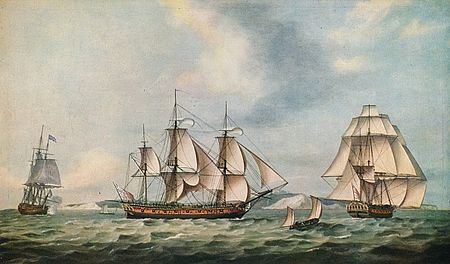
The Swallow From Wikipedia.
|
Georgiana: voyage 1803-1807. |
|
|
| Swallow |
Royal Navy |
A Royal Navy Revenue cruiser/cutter. This vessel was noted in the log of the Georgiana on Saturday 20th August 1803 as conveying convoy instructions off the Downs as she sailed towards the Motherbank. The Log states that her commander was Captain Rowe.
|
Georgiana: voyage 1803-1807. |
|
|
| Syren |
HEICS |
Ship noted by Captain Gribble at Saugor as setting sail on Sunday 29th May 1831. She may have been the Country ship trading between India and China, which was noted in the Bay of Bengal in 1818.
|
Repulse: voyage 1831-1832. |
|
|
|
T |
| Taunton Castle |
HEICS |
Built by Barnard, launched 1790, length 165ft, 1200 tons. She made nine trips to the Far East. Noted in the journal of the True Briton as arriving at Spithead from the Downs on Saturday 15th June 1804 under Captain Thomas Burston Pierce. Declared worn out in 1813.
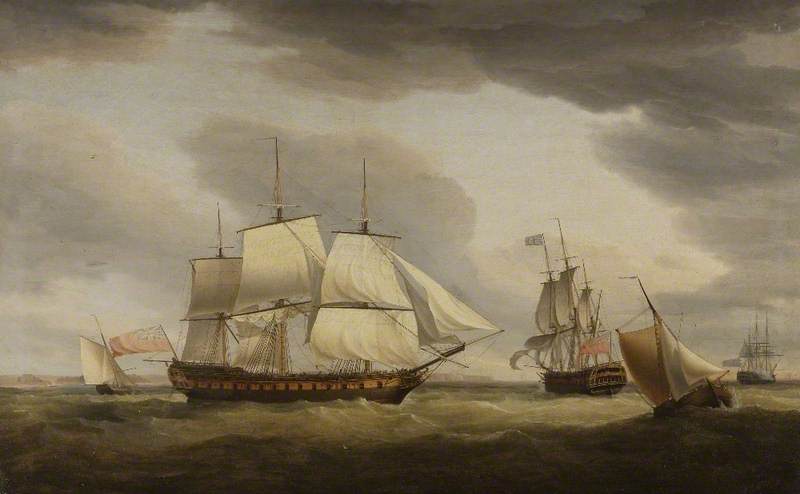
Taunton Castle
from Wikipedia.org.
|
True Briton : voyage 1804-1805. |
|
|
| Tees |
Royal Navy |
Launched 1817, 6th Rate. St Helena 14 Jun 1820, had sailed to the Cape. Based at Mauritius later that year. Involved in the 1824-1826 Burmese War. From 1826 she was a 'Church ship' based at Liverpool. Disposal year 1872.
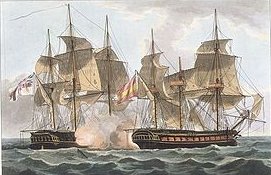
Royal Navy Terpsichore
|
Warren Hastings: voyage 1819-1820. |
|
|
| Teignmouth |
HEICS |
Farrington does not mention the Teignmouth, there is however a Teignmouth built in Bombay in 1799. It is described as a 'Sloop of War', see wiki-fibis. A Company ship Teignmouth is also noted in the log of the Georgiana as arriving at St Helena from Bengal on 5th September 1805. |
Georgiana: voyage 1803-1807; Huddart: voyage 1806-1807. |
|
|
| Tellicherry |
HEICS |
Extra ship built by Young, launched 1796, length 125ft, 465 tons. Three voyages recorded between 1796 and 1801. Reported by Captain Barker of the Northampton as at Calcutta on Thursday 16th September 1802. |
Northampton: voyage 1801-1803. |
|
|
| Terpsichore |
Royal Navy |
A frigate launched at Mistleythorn in 1785, 5th rate, armament 32, 682 tons. Part of the fleet under Admiral Pellew in the Far East. Recorded as chasing the Semillante off the coast of Ceylon in March 1808. Joined the Northampton in the same area on Monday July 4th 1808. See: https://sites.rootsweb.com/~pbtyc/18-1900/C/01156.html, for history and an extract from her log in 1809 experiencing a hurricane. Also see Wikipedia. She was broken up in 1832. |
Northampton: voyage 1801-1803; Northampton: voyage 1807-1809. |
|
|
| Thames (2) |
HEICS |
Built by Perry, launched 1796. length 176ft, 1432 tons. Noted in the log of the Georgiana as arriving at St Helena from England on 19th May 1804 on her way to China. Her commander was Captain John Skottowe. Noted again again in the same log as arriving in convoy from China at St Helena on 2nd April 1805. Noted in the same log as departing St Helena on 3rd July 1804 for China. Noted in the Journal of the True Briton as sailing from St Helena on 12th July 1805 for England, under Captain John Skottowe. On 17th October 1806 she was noted by Captain Lindsay of the Lady Jane Dundas as at Penang on her fifth voyage, commanded by Captain Matthew Riches. Her eighth and last recorded voyage was in 1814.
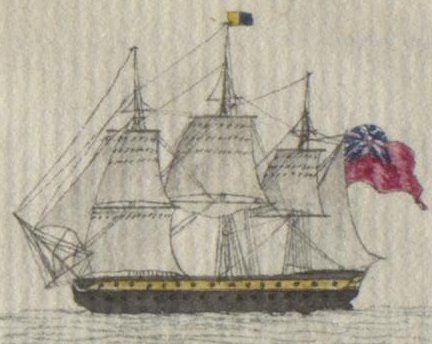
Vignette of the ship Thames
|
Georiana: voyage 1803-1807; True Briton: voyage 1804-1805; Huddart: voyage 1806-1807; Lady Jane Dundas: voyage 1805-1807. |
|
|
| Thames hoy |
HEICS |
A hoy or lighter, a small sailing craft used on the Thames for loading crew and passengers and cargo. |
Vansittart: voyage 1826-1828; Repulse: voyage 1831-1832. |
|
|
| Thames (5) |
HEICS |
Built by Barnard, launched 1819, length 166ft, 1330 tons. Noted on her five voyage in the journal of the Bridgewater at Whampoa on 23rd Nov 1829 when her cutter assisted the Bridgewater to move downstream. Seven voyages to China are recorded of which her sixth was commanded by Captain James Keith Forbes. |
Bridgewater: voyage 1828-1830; Repulse: voyage 1831-1832. |
|
|
| Thetis |
misc |
A whaler noted in the log of the Georgiana as arriving at St Helena on 2nd April 1804. This is also noted in the same log as arriving on the 1st May 1804, unless we are dealing with two by the same name. This may be the same ship as recorded in Wikipedia as launched at Rotherhithe in 1793, she was certainly a whaler for a time later in her life. |
Georgiana: voyage 1803-1807. |
|
|
| Thomas Coutts |
HEICS |
Built by Barnard 1817, 166ft long, 1334 tons. Sailed to China at least eight times. This was her fifth voyage, under Captain Alexander Chrystie. |
Warren Hastings: voyage 1825-1826. |
|
|
| Thomas Grenville |
HEICS |
Company's own ship built at Calcutta, launched 1808, 3 decks, 145ft 10in long, 886 tons. She was sold to Ward & Somes in 1834 for £66.50. This was her third voyage, her Captain was William Patterson.
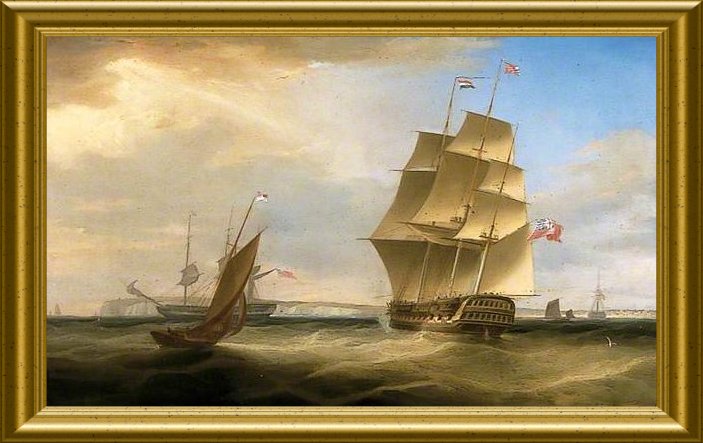
HEICS Thomas Grenville
|
Juliana: voyage 1812-1813. |
|
|
| Thornton lighter |
HEICS |
A lighter at Deptford noted by Captain Barker of the Northampton on 22nd July 1801. |
Northampton: voyage 1801-1803. |
|
|
| Tigris (2) |
HEICS |
Repaired by Barnard 1803. Length 122ft, 527 tons. Six voyages recorded to India. Noted in the log of the Georgiana as arriving at St Helena on 30th September 1804, having some difficulty in mooring, her commander was Captain Charles Graham. During subsequent days some of the crew from the Georgiana worked on her. She sailed for England at midnight on the 5th October. She was noted again in the same log as arriving in convoy from the East at the Cape of Good Hope on 30th December 1806. Noted again in the same log as at St Helena on 29th January 1807. On the 30th she assisted the Georgiana with 3 a loan of men. On 2nd February 1807 she was noted in the log of the Georgiana as leaving St Helena in convoy for England. On her way home in the north Atlantic the Georgiana noted that she had sprung her bowsprit. On her third voyage to India she was noted in the log of the Northampton, commanded by Captain Dugald MacDougall. She was wrecked off Teignmouth in a gale in 1823. |
Georgiana: voyage 1803-1807; Northampton: voyage 1807-1809. |
|
|
| Topaze |
Royal Navy |
Built 1814. 27 Mar 1814 l'Etoile taken off La Hogue by Hebrus. Renamed Topaze. Fifth rate, 1060 tons, 38 guns. Trincomalee 18th Aug 1819, had returned from China, and was due to relieve the Liverpool at Mauritius and was to proceed to the Gulf to conduct an expedition against the pirates". Used as a target in 1850. |
Warren Hastings: voyage 1819-1820. |
|
|
| Torigsae |
misc |
A Portuguese ship noted in the log of the Georgiana as arriving at St Helena from Bengal on 2nd March 1805. |
Georgiana: voyage 1803-1807. |
|
|
| Tornate |
HEICS |
A company sloop arriving Bombay Wednesday 24th December 1806. Probably a 'Country' ship, she sailed for Surat on Thursday 8th January 1807. |
Earl St Vincent: voyage 1806-1807. |
|
|
| Torturia |
misc |
A Swedish ship noted by Captain Jones on Saturday 20th June 1807 as setting sail under convoy from St Helena for England, otherwise not traced. |
Earl St Vincent: voyage 1806-1807. |
|
|
| Tottenham |
HEICS |
An Extra ship, built at Stockton-on-Tees, repaired by Perry 1802. Length 124ft, 517 tons. Noted in the journal of the True Briton as arriving at Spithead from the Downs on Saturday 12th June 1804 under Captain James Dalrimple. On her third voyage to India she was commanded by Captain Thomas Jones when she noted in the log of the Georgiana as arriving at St Helena from Bencoolen on 6th September 1805. Her last recorded voyage was her sixth in 1813.
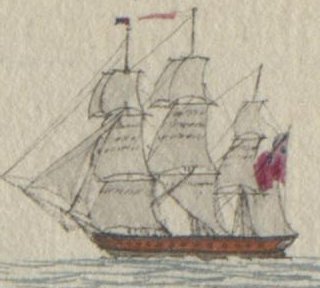
Vignette of the ship Tottenham
|
True Briton : voyage 1804-1805; Georgiana : voyage 1803-1807; Huddart: voyage 1806-1807. |
|
|
| Travers |
HEICS |
An extra ship built by Wells and launched in 1800. She is recorded as making five voyages to India. Noted in the log of the Georgiana as a company supply ship from England arriving at St Helena on Sunday 23rd December 1804. In February 1805 she, along with the Georgiana and Union, sailed on a cruise near the Island. She sailed in convoy from St Helena on 13th April 1806. On 7th November 1807 she was wrecked in the Andaman Islands. Her commander was Captain John Collins. See Wikipedia for her history and fate.
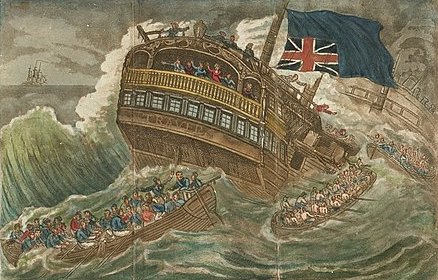
Wreck of the Travers
by Thomas Tegg 1809.
|
Georgiana: voyage 1803-1807. |
|
|
| Tremendous |
Royal Navy |
Built by Barnard at Deptford & launched 30 Oct 1784, 3rd rate, armament 74, 1680 tons, complement 594. See the website: https://sites.rootsweb.com/~pbtyc/18-1900/C/01156.html, for her full and complex history. Renamed the Grampus in 1845, a powder hulk in 1856, she was eventually disposed of in 1897 after over one hundred years service.
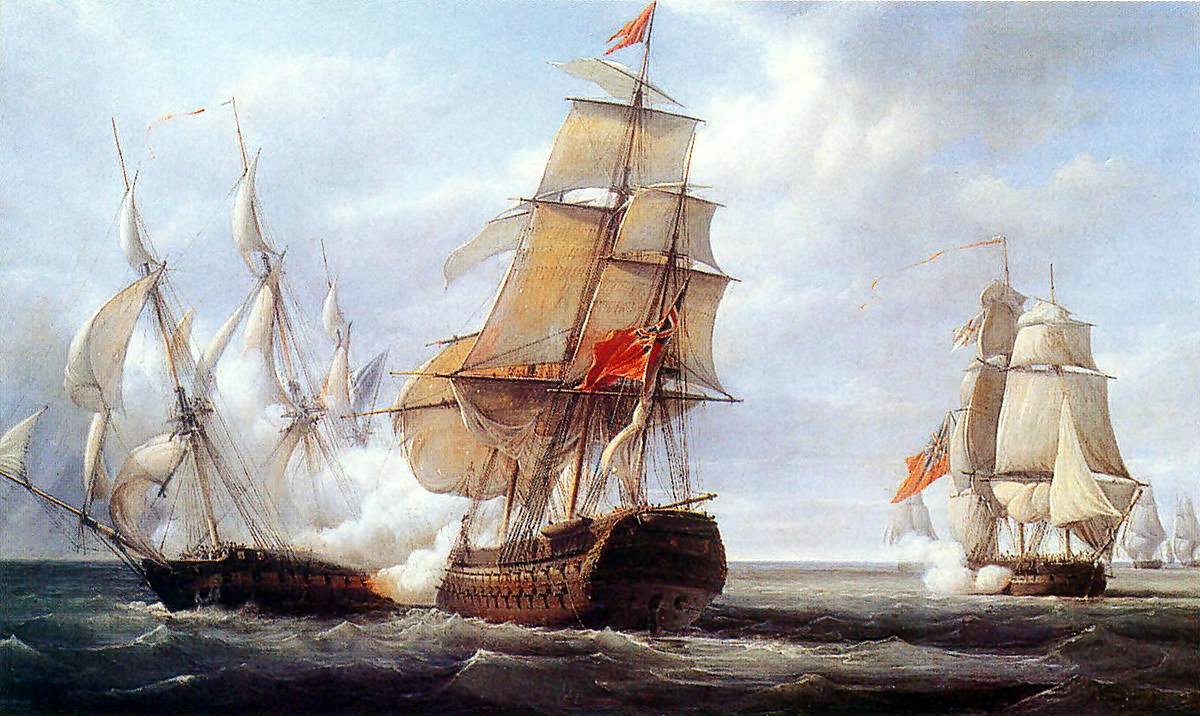
Royal Navy Tremendous
|
Northampton: voyage 1801-1803. |
|
|
| Trident |
Royal Navy |
Launched on 20 April 1768 at Portsmouth, 3rd rate, armament 64. She arrived at Bombay on Saturday 6th March 1802. She was noted in the Log of the Wexford as at Madras on 4th August 1803, along with HMS Centurion HMS Lancaster & HMS Victor. On 7th Nov 1803 the Trident, Tremendous, Centurion, and Lancaster, of the line; Dedaigneuse, frigate; and Albatross, sloop, arrived at Bombay from Madras. Noted in the Journal of the True Briton as at St Helena on 30th June 1805. The Trident, commanded by Captain Page, acted as Flag Ship for the Convoy on its return to England. On board was Vice-Admiral Peter Rainier who presumably, as the senior ranking officer, took charge. The Convoy left on the 12th June 1805, note an interesting collection of illustrations indicating positioning and signalling instructions in the Journal of the True Briton. She was noted in the log of the Georgiana as at St Helena on 28th June 1805. The log also states that she and the Mediator sailed from the Island on 7th July. Maybe this was a sgort cruise before heading for England. In 1816 the Trident was stationed at Malta and was sold the same year. See the website: https://sites.rootsweb.com/~pbtyc/18-1900/C/01156.html, for her history. This was Vice-Admiral Rainier's last voyage before his retirement after serving , see Wikipedia for more information on Vice Admiral Rainier.
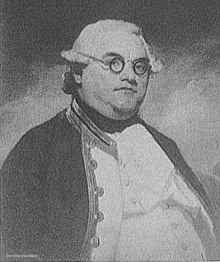
Vice-Admiral Rainier.
|
Northampton: voyage 1801-1803; Wexford: voyage 1803-1804; True Briton: voyage 1804-1805; Georgiana: voyage 1803-1807 . |
|
|
| Triumphant |
misc |
An American ship from Salem, USA. She was noted in the log of the Georgiana as arriving at St Helena from Tranguebar, Bengal on 2nd January 1806.
|
Georgiana: voyage 1803-1807. |
|
|
| True Briton (4) |
HEICS |
Built by Wells, launched 1790, length 165ft, 1209 tons. She made eight voyages to the Far East and had just returned from her fifth voyage, being Commanded by William Stanley Clarke. She was at Gravesend on Monday 21st Feb 1803 when the Wexford came alongside. Captain Clarke of the took over from Captain Pelly on the Wexford which was about to set sail for China. Both ships were owned by Robert Wigram. While on her eighth voyage, Commanded by Captain George Bonham, the True Briton parted company in the South China sea on 19th Oct 1809 and was not heard of again.
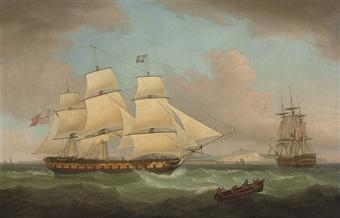
True Briton (4) taken from Wikipedia. |
Wexford: voyage 1803-1804. |
|
|
| Tullock Castle |
misc |
Recorded as a passing ship on Friday 9th May 1828 six weeks from England. A Tullock Castle is recorded as taking passengers from England to Australia in 1852. |
Vansittart: voyage 1826-1828. |
|
|
| Tyne |
HEICS |
She was an extra ship built by Brent, launched 1807, length 112ft, 462 tons. She sailed with the the convoy but not under the HEICS flag until parting company for Cape Town on Monday November 30th 1807, presumably her maiden voyage. Her only recorded trip under the HEICS was is 1810 under Captain Robert Brooks. |
Northampton: voyage 1807-1809; Lord Keith: voyage 1810-1811 . |
|
|
|
U |
| Udney |
misc |
Noted in the log of the Georgiana as arriving at Cape Town from Bengal on 30th November 1806. |
Georgiana: voyage 1803-1807. |
|
|
| Ulysses |
misc |
Built at Haverhill, Massachusetts and registered in Salem, USA in 1798. She weighed 340 tons and was 100ft long. In 1804, under her commander, Captain Mugford, she sailed from Salem to Marseille when she was hit by a major storm, which took away her rudder. Captain Mugford and her crew rigged up a new rudder. On 22nd July 1806 Captain Jones of the Earl St Vincent recorded: "saw a sail to the East and at half past 4 spoke her, she proved to be the American ship Ulysses of Salim, John Robert Dallinge Master from Bengal which places she left the 30th May informed us a general peace was concluded with the Country Powers in India". The following picture is of her with her temporary rudder at Marseille, painted by Antoine Roux.
She was still trading in 1806 when on Tuesday 22nd July 1806, while near to Madagascar, Captain Charles John Jones passed and spoke to her Master John Robert Dallinge. Captain Jones states that "she proved to be the American ship Ulysses of Salim John Robert Dallinge Master from Bengal which place she left the 30th May, he informed us a general peace was concluded with the Country Powers in India".
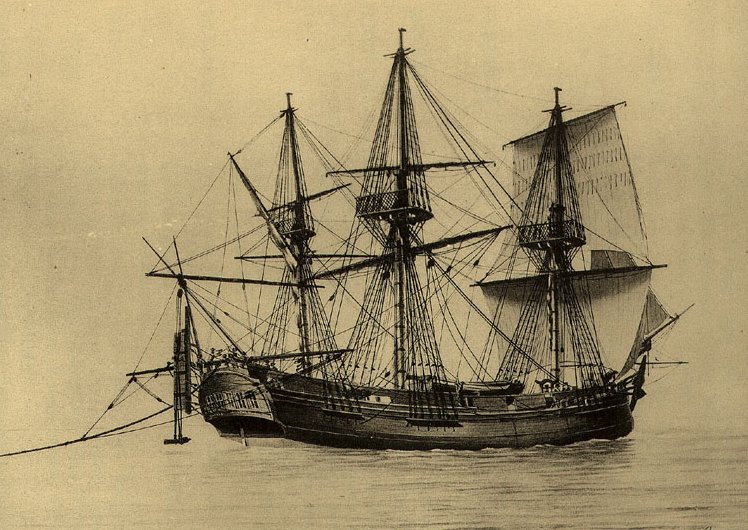
The Ulysses with her rudder.
|
Earl St Vincent: voyage 1806-1807. |
|
|
| Ulysses |
Royal Navy |
Launched at Liverpool in 1779, 887 tons with armament of 44. Described as a recruit brig while at Madeira by Captain Sanders of the Northampton. See: https://sites.rootsweb.com/~pbtyc/18-1900/C/01156.html, for more details of her history. She was disposed of in 1816. |
Northampton: voyage 1807-1809. |
|
|
| Union |
HEICS |
She was noted in the log of the Georgiana as arriving at St Helena on Thursday 12th January 1804. She noted again in the same log as arriving at the Cape in convoy from the East on 30th December 1806. On 2nd February 1807 she was noted in the log of the Georgiana as leaving St Helena in convoy for England. The entry describes her as Union No.2 but this be an error. She is described as a Company ship but is not to be confused with Union (4) which apparently only left Calcutta for England on 17th January 1804. |
Georgiana: voyage 1803-1807. |
|
|
| Union (4) |
HEICS |
Built by Randall and launched 1802, length 125ft, 550 tons. Noted in the log of the Georgiana as sailing from St Helena to England on 10th Feb. 1804. Noted in the log of the Georgiana as a company supply ship from England arriving at St Helena on Sunday 23rd December 1804. Her commander was Captain John Mackintosh. She left for Bengal in February 1805 and returned to St Helena with stores on 30th November 1805 and sailed for England on 1st February 1806. She was noted again in the same log as arriving at the Cape of Good Hope on 23rd December 1806 from England under Captain John Mackintosh and sailing on the 26th for Bengal. Noted by Captain Sanders of the Northampton on her fourth recorded voyage 1807-9. Commanded by Captain George Simpson. Captain Campbell of the Lord Keith described her as a store ship while at St Helena on 18th June 1811. Her last recorded voyage was in 1817/8. |
Georgiana: voyage 1803-1807; Northampton: voyage 1807-1809; Lord Keith: voyage 1810-1811. |
|
|
| Union (5) |
HEICS |
launched at Calcutta 1801, repaired by Brent in 1805, length 132ft, 723 tons. She sailed England and then made 5 voyages. Noted in the log of the Georgiana as arriving at St Helena on 28th June 1804 on her way to England. She departed on 8th July 1804. She was wrecked late in 1815 or early 1816. Her commander was Captain William Stokoe. See Wikipedia for her detailed history. |
Georgiana: voyage 1803-1807. |
|
|
| United Kingdom |
HEICS |
At 850 tons and owned by John Atkins. Noted in the log of the Georgiana as at St Helena on 1st November 1805. According to Farrington she had arrived on 22nd October from Saugor, her commander was Captain Henry Pelly. She sailed for England on the 4th November. She was on her third voyage to India, commanded by Captain William Parker D'Esterre when described as a store ship at St Helena by Captain Bayliff. She was also noted in June 1807 as at St Helena by Captain Lindsay of the Lady June Dundas. On her fourth trip, commanded by Captain D'Esterre, she was captured by two French ships, the La Manche and the La Vénus on 19 Nov 1809. Her officers were landed at Vizagapatam, Madras on the 7 Dec 1809.
|
Georgiana: voyage 1803-1807, Huddart: voyage 1806-1807, Lady Jane Dundas: voyage 1805-1807. |
|
|
|
V |
| Vansittart (4) |
HEICS |
Built by Gilmore at Calcutta in 1813, by 165ft long, 1273 tons. Sailed to China and India at least eleven times. Captain Rawes of the Warren Hastings noted her on her second voyage, under Captain Robert Stair Dalrymple. The ship is not mentioned by Captain Rawes of the Warren Hastings but he attended its Captain Robert Stair Dalrymple's funeral at or near Whampoa on Tuesday 18th January 1820. In the 1823/24 voyage her Captain was William Henry Clarence Dalrimple. Noted in the journal of the Bridgewater at Toun-koo on Saturday 19th December 1829, her commander was Captain Robert Scott. On the 1831/32 voyage her captain was Robert Scott. |
Warren Hastings: voyage 1815-1816; Warren Hastings: voyage 1819-1820; Warren Hastings: voyage 1823-1824; Bridgewater: voyage 1828-1830; Repulse: voyage 1831-1832. |
|
|
| Varuna |
HEICS |
Extra ship, built in Calcutta 1795, repaired by Barnard 1797. Length 116ft, 526 tons. Farrington records four voyages: 1796/17, 1797/8, 1800 & 1803. Captain Barker describes her as an Indiaman so it is assumed that on this voyage she was sailing on her own business. Farrington does not record her owners. |
Northampton: voyage 1801-1803. |
|
|
| Venus |
misc |
A whaler, no information except that Captain Campbell of the Lord Keith describes her as a whaler at St Helena on the 18th June 1811 on his homeward voyage. She is later recorded as accidentally ramming HMS Leda and damaging the Leda's rudder. |
Lord Keith: voyage 1810-1811. |
|
|
| Victor |
Royal Navy |
Launched in 1798, sloop, armament (1816x32 pdr carronades, 2xsixes), complement 120. (See: https://sites.rootsweb.com/~pbtyc/18-1900/C/01156.html, for more details of this ship.) She was noted in the Log of the Wexford as at Madras on 4th August 1803, along with HMS Trident HMS Centurion & HMS Lancaster. On 7th Nov 1803 the Trident, Tremendous, Centurion, and Lancaster, of the line; Dedaigneuse, frigate; and Albatross, sloop, arrived at Bombay from Madras. She captured the French privateer Les Amis Reunis near the Persian Gulf on 7 May 1805. On Saturday 10th January 1807, she was recorded by Captain Bayliff of the Huddart as moored at Madras. On Monday 29th December 1806 Captain Jones of the Earl St Vincent recorded her arriving at Bombay. On 8 October 1808 she was cruising off Sandshead in the Bay of Bengal, and after a nine hour chase and fight she captured the French corvette Jéna, which was added to the British Navy under the name Victor, while the original Victor was presumably scuppered. She was sighted by Captain Sanders of the Northampton at Madras on Wednesday February 17th 1808. She was broken up in October 1808 after capturing the French ship Jéna in the bay of Bengal. See https://sites.rootsweb.com/~pbtyc/18-1900/C/01156.html, for her history. |
Wexford: voyage 1803-1804; Earl St Vincent: voyage 1806-1807; Huddart: voyage 1806-1807. |
|
|
| Victorious |
Royal Navy |
Launched at Blackwall 1785, 3rd rate, armament 74. Took part in the taking of the Cape of Good Hope in 1795. Her captain was William Clark. Disposed of in 1803 after leaving some of her guns at Madras. See Wikipedia for a report of her disposal:- "On her homeward passage from the East Indies in 1803, Victorious proved exceedingly leaky. When she met with heavy weather in the North Atlantic, her crew had difficulty keeping her afloat till she reached the Tagus, where she was run ashore and broken up." |
Northampton: voyage 1801-1803. |
|
|
| Virginie |
Royal Navy |
A Frigate built at Brest and launched 26th July 1794. Length 156ft, 44 guns, 720 tons. On 22nd April 1796 she was captured by the Royal Navy off the coast of Ireland. Described as a frigate belonging to the Cork Squadron noted in the English Channel on 1st September 1807 by Captain Lindsay of the Lady Jane Dundas. She was out of service by 1827. See https://en.wikipedia.org/wiki/French_frigate_Virginie_(1794) for her history.

Mention of the Chiffonne, Orpheus and the Virginie
in the Hampshire Telegraph 18th April 1803.
|
Lady Jane Dundas: voyage 1805-1807. |
|
|
| Volage |
Royal Navy |
Built 1807, 6th rate, 529 tons. On Thursday 19th November 1812 Captain Rawes of the Juliana noted that she arrived at Batavia from Madras. She was disposed of 1818. On 27th August 1815 she pressed crew from the Warren Hastings. See website: Royal Navy Volage
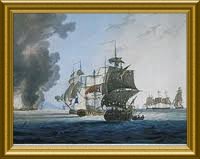
Royal Navy Volage
|
Juliana: voyage 1812-1813; Warren Hastings: voyage 1815-1816. |
|
|
| Voltair |
misc |
An American merchant ship noted in the journal of the Wexford as at Madras on 9th August 1803 when she and the Wexford fouled and she lost her jib boom, otherwise unknown. |
Wexford: voyage 1803-1804. |
|
|
| Vulture |
misc |
Launched in 1777, she was captured and became a Liverpool-based privateer, then a slave ship until she was captured by the French and became a French privateer. Captured by the Royal Navy in 1800 and under new owners in 1801 she became a whaler. She was noted in the log of the Georgiana as departing in convoy from St Helena for England in convoy on 13th August 1804. In 1809 she became a Spanish privateer.
|
Georgiana: voyage 1803-1807. |
|
|
| Vrow Helena |
misc |
A Dutch ship recorded by Captain Dalrymple of the Vansittart on Saturday Nov 10th 1827 as sailing from Batavia to China. Not traced. |
Vansittart: voyage 1826-1828. |
|
|
|
W |
| Warley |
HEICS |
Built by Perry, launched 1796, length 176ft, 1460 tons, second of that name. She made nine voyages to China of which this was her fifth, under Captain Henry Wilson. She was involved in the so called Battle of Pulo Aura off Java against the French in 1804. She was sold for breaking in 1816.
|
Ganges: voyage 1805-1807. |
|
|
| Walmer Castle |
HEICS |
Built 1796, 176ft long, 1460 tons. Sailed to China at least nine times. Noted in the log of the Georgiana as arriving at St Helena on Sunday 15th April 1804 from England. Her commander was Captain Essex Henry Bond. She sailed southward on 6th May 1804. In the same log she arrived in convoy from China at St Helena on 2nd April 1805. Noted in the Journal of the True Briton as part of the Convoy returning to England, her commander was Captain Henry Bond. Noted by Captain Lindsay of the Lady Jane Dundas at Portsmouth on 4th March 1806 as part of the outward bound convoy, under her Commander Captain Luke Doods. Noted by Captain Rawes of the Warren Hastings at Northfleet on 19th March 1815 preparing to set sail on her last recorded voyage to the East. This was her last recorded voyage under Captain David Sutton.
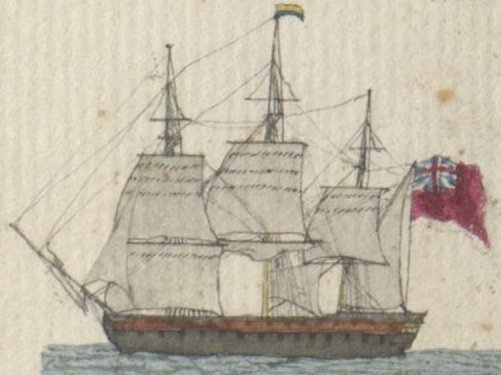
Vignette of the ship Walmer Castle
|
Georgiana: voyage 1803-1807; True Briton: voyage 1804-1805; Lady Jane Dundas: voyage 1805-1807; Warren Hastings: voyage 1815-1816. |
|
|
| Walpole (5) |
HEICS |
Built by Perry 1798. Length 146ft, 823 tons. She sailed five times to the East. On her third, Commanded by Captain James Sandilands she was noted in the journal of the Wexford as at Madras on 4th August 1803. By Sunday 27th November 1803 she was noted by Georgiana as arriving at St Helena from Madras and leaving on the 5th January 1804. Noted in the journal of the True Briton near the North Reach on Monday 26th March 1804. She was wrecked in a storm in Margate Roads, 18th Dec 1808 on her return from India. See Jackson's Hampshire Journal for some detail of the storm. Many ships had difficulties including the Northampton detailed elsewhere. |
Wexford: voyage 1803-1804; Georgiana: voyage 1803-1807; True Briuton: voyage 1804-1805; Northampton: voyage 1807-1809. |
|
|
| Walthamstow |
HEICS |
Built by Randall, launched 1799, length 118ft, 824 tons. Noted in the journal of the True Briton as arriving at the Motherbank from the Downs on Wednesday 2nd May 1804. On her fourth trip to India, commanded by Captain Donald Macleod, Captain Farrer of the Cumberland noted her at St Helena on Wednesday 2nd July 1806 and Captain Harington of the Ganges records her as arriving at Point de Galle from Bengal on Sunday 15th March 1807. Noted at Saugor on 30th January 1807 by Captain Lindsay of the Lady Jane Dundas. Captain Bayliff of the Huddart also recorded her on this voyage as did Captain Jones of the Earl St Vincent. Her last and sixth recorded trip was in 1811.
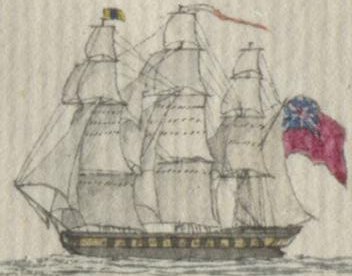
Vignette of the ship Walthamstow
|
True Briton: voyage 1804-1805; Lady Jane Dundas: voyage 1805-1806; Cumberland: voyage 1805-1806; Ganges: voyage 1805-1807; Huddart: voyage 1806-1807; Earl St Vincent: voyage 1806-1807. |
|
|
| Warley (1) |
HEICS |
Built by Perry, launched 1788, length 160ft, 1175 tons, first of that name. She made two voyages to China. She was sold to the Royal Navy in 1795 who changed her name to Calcutta, was captured by the French in 1805 and burnt in 1809. She was notedin the log of the Georiana as arriving at St Helena on Saturday 20th July 1805. See under HMS Calcutta for further information. |
Georgiana: voyage 1803-1807. |
|
|
| Warley (2) |
HEICS |
Built by Perry, launched 1796, length 176ft, 1460 tons, second of that name. She made nine voyages to China. The fourth was under Captain Henry Wilson. Recorded by the Wexford as arriving at Macao on 7th November 1803. On her fifth she was involved in the so called Battle of Pulo Aura off Java against the French in 1804. During this voyage she was noted by Captain Farrer of the Cumberland. She was sold for breaking in 1816.
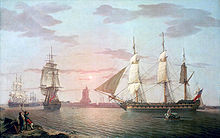
The Warley, by Robert Salmon, National Maritime Museum as per
https://en.wikipedia.org/wiki/Battle_of_Pulo_Aura.
|
Wexford: voyage 1803-1804; Cumberland: voyage 1805-1806. |
|
|
| Warren Hastings (2) |
HEICS |
Built by Barnard, launched 1802, length 165ft, 1276 tons. She made two trips to China under Captain Thomas Larkins. On her first she was noted was recorded by the Wexford as being at Whampoa on 29th October 1803. Noted in the log of the Georgiana as close to St Helena on 1st May 1805 finally moored on the 3rd. She sailed for Benkulen on 17th July 1805. Her commander was Captain Thomas Larkin. She was on her way from Benkulen when on 24th November 1805 she was noted by Captain Harington of the Ganges as arriving at Malacca from Benkulen. She subsequently joined up with the Ganges and Dorsetshire on convoy to China on what proved to be a lengthy voyage to China. Presumably, to avoid the French, they took a lengthy route to the south of Borneo and to the east of the Philippines. On 5th April 1806 they left China, along with the Surat Castle for the return voyage to England. It was a slow and tedious voyage as the Ganges had severe problems with water ingress. They were in the middle of the Indian Ocean returning to England and escorted by HMS Sir Edward Hughes, when on 7th June 1806 Captain Harington of the Ganges handed over to Captain Larkins the Honourable Company's packets and all private letters on board for England, as he had to turn his ship north towards Bombay for repairs. On 9th June the Convoy was split and the Ganges and Sir Edward Hughes headed to Bombay. This weakened the Convoy and unfortunately on 11th June 1806 the Warren Hastings was captured by the French frigate La Piédmontaise. She was noted again in the log of the Georgiana on 13th September when an unnamed American ship arrived at St Helena with Captain Larkins and officers from the recently captured Warren Hastings. |
Wexford: voyage 1803-1804; Georgiana: voyage 1803-1807; Ganges: voyage 1805-1807. |
|
|
| Warren Hastings (3) |
HEICS |
Built by Perry, launched 1808. 128ft long at 1000 tons. She made eleven voyages to the Far East. Notes by Captain Rawes of the Juliana as arriving at St Helena on 5th June 1813. Her Captain was Charles Jones. |
Juliana: voyage 1812-1813. |
|
|
| Waterloo (1) |
HEICS |
Built 1816. 1325 tons. Made at least nine voyages to China. Noted by Captain Rawes of the Warren Hastings as arriving at Penang on 22nd August 1819 and at Whampoa on 13th Sept 1823, under Captain Richard Alsager. Noted in the journal of the Bridgewater exchanging cotton at Whampoa on Friday 11th December 1829. Her commander on this occasion was Captain David Rae Newall. Noted on 6th October 1831, under Captain was William R Blakely, she was noted by Captain Gribble of the Repulse as leaving Whampoa. |
Warren Hastings: voyage 1819-1820, Warren Hastings: voyage 1823-1824, Bridgewater: voyage 1828-1830; Repulse: voyage 1831-1832. |
|
|
| Wellesley |
HEICS |
A country ship built at Calcutta in 1796 for the Company and called Wellesley. The Admiralty purchased her in 1804 as a 44-gun fifth rate and renamed her the Weymouth. See under that name for further details. |
Ganges: voyage 1805-1807. |
|
|
| Wellington |
misc |
A Barque recorded as a passing ship on Friday 23rd May 1828 on free trade between Madras to London. |
Vansittart: voyage 1826-1828. |
|
|
| Wexford |
HCS |
Built by Smith, launched 1802, length 167ft, 1271 tons. She made seven voyages to the east of which this was her second, commanded by Captain William Stanley Clarke. She was involved in the Battle Aura in 1804 and was noted on Tuesday 6th May 1806 in the Indian Ocean by Captain Farrer of the Cumberland. She was broken up in 1819. |
Cumberland: voyage 1805-1806. |
|
|
| Weymouth |
Royal Navy |
Previously an HEICS Country ship called the Wellesley. No description under Farrington but to say that she made two voyages to the East under the HEICS flag, one in 1801 from Bengal and one in 1803 from Saugor to England, both under Captain Peter Gordon. In 1800, under Captain Gordon, she was involved in a fight with a French warship and fought her off. She was built in Calcutta in 1796, The Admiralty purchased her in May 1804 as a 44-gun fifth rate and used her as a store ship. On Friday 23rd Aug 1805 she was noted by Captain Farrer of the Cumberland and Captain Harington of the Ganges as at or near Madras. On Sunday 25th August 1805 Lieut Gilcrist along with 32 men went onboard the Cumberland to carry out repairs. Her last voyage was in 1820 carrying settlers to South Africa. In 1828 she was converted to a prison ship and sailed to Bermuda where she served as a prison hulk until 1865 when she was sold for breaking. See: https://en.wikipedia.org/wiki/HMS_Weymouth_(1804). |
Cumberland: voyage 1805-1806; Ganges: voyage 1805-1807. |
|
|
| Wilding |
misc |
Recorded by Captain Sanders of the Northampton as a West Indiaman at St Helena on Saturday October 15th 1808. See Google Books for a record of her sinking in 1824. She was in a convoy from Honduras carrying wood when sinking in a hurricane off Charleston, USA. |
Northampton: voyage 1807-1809. |
|
|
| Wilhelmina |
Royal Navy |
A Dutch frigate Furie, built by Flushing in 1778. Captured 24th October 1798 and entered the Royal Navy under the name Wilhelmina as a 5th rate, armament 32, 827 tons. See: https://sites.rootsweb.com/~pbtyc/18-1900/C/01156.html and Wikipedia for a detailed history of her. Mentioned in the Ledger of the Wexford on her voyage 1803/4. On 4th December 1806 she was noted by Captain Lindsay of the Lady Jane Dundas as in the Bay of Bengal. Captain Harington of the Ganges and Captain Jones of the Earl St Vincent record her as arriving at Point de Galle on Sunday 15th March 1807. She spent most of her career in the Far East and ended up as a guardship at Penang before being sold in 1813.
|
Wexford: voyage 1803-1804; Lady Jane Dundas: voyage 1805-1807; Ganges: voyage 1805-1807; Earl St Vincent: voyage 1806-1807. |
|
|
| William IV |
HEICS |
Steam packet operating from Deptford. Towed the Repulse on 11th Feb 1831. |
Repulse: voyage 1831-1832. |
|
|
| William and Elizabeth |
misc |
A whaler noted in the log of the Georgiana as arriving at St Helena on 16th March 1805. |
Georgiana: voyage 1803-1807. |
|
|
| William Fairlie |
HEICS |
Built by Bayley at Ipswich, measured 1821, 3 decks, 4in bottom, length 167ft, keel 134ft 5in, breadth 43ft 5in, hold 17ft, wing transom 26ft, port cell 29ft 6in, waist 1ft 4in, between decks 6ft 7½ & 6ft 5in, roundhouse 6ft 5in, ports 14 middle & 13 upper, deck range 98ft, 1348 tons. Six voyages to the Far East are recorded. Noted in the journal of the Bridgewater at Saugor on Tuesday 20th April 1830. Her commander was Thomas Blair. |
Bridgewater: voyage 1828-1830. |
|
|
| William Pitt lighter |
HEICS |
A lighter noted in the Journal as coming alongside the True Briton at Blackwall on Saturday 9th November 1805. |
True Briton: voyage 1804-1805. |
|
|
| William Pitt (2) |
HEICS |
Built by Barnard and launched in 1805, 145ft, 819 tons. Severn voyages to India and beyond are recorded by Farrington. She was noted in the log of the Georigana as arriving in convoy from India at Cape of Good Hope on 30th December 1806, she was commanded by Captain William Edmeades. She was referred to again on the 26th January 1807 while the Georgiana was at St Helena. On 2nd February 1807 she left St Helena in convoy for England. She was sold for breaking in 1820. |
Georgiana: voyage 1803-1807. |
|
|
| Winchelsea |
HEICS |
Built by Well, launched 1803, length 165ft, 1265 tons. She made eleven voyages to the Far East. Noted in the log of the Georgiana as arriving at St Helena on 28th Mar 1805. In the same passage it was stated that the Winchelsea was the last to see off Ceylon the ship Brunswick. Noted in the Journal of the True Briton as sailing from St Helena with the Convoy back to England on 12th July 1805, under Captain Walter Campbell. Her second was under the command of Captain William Moffat. Noted by Captain Lindsay of the Lady Jane Dundas at Portsmouth on 4th March 1806 as part of the outward bound convoy. On 7th July 1806 Captain Harington of the Ganges noted the Winchelsea at Bombay. Her last recorded voyage was in 1830.
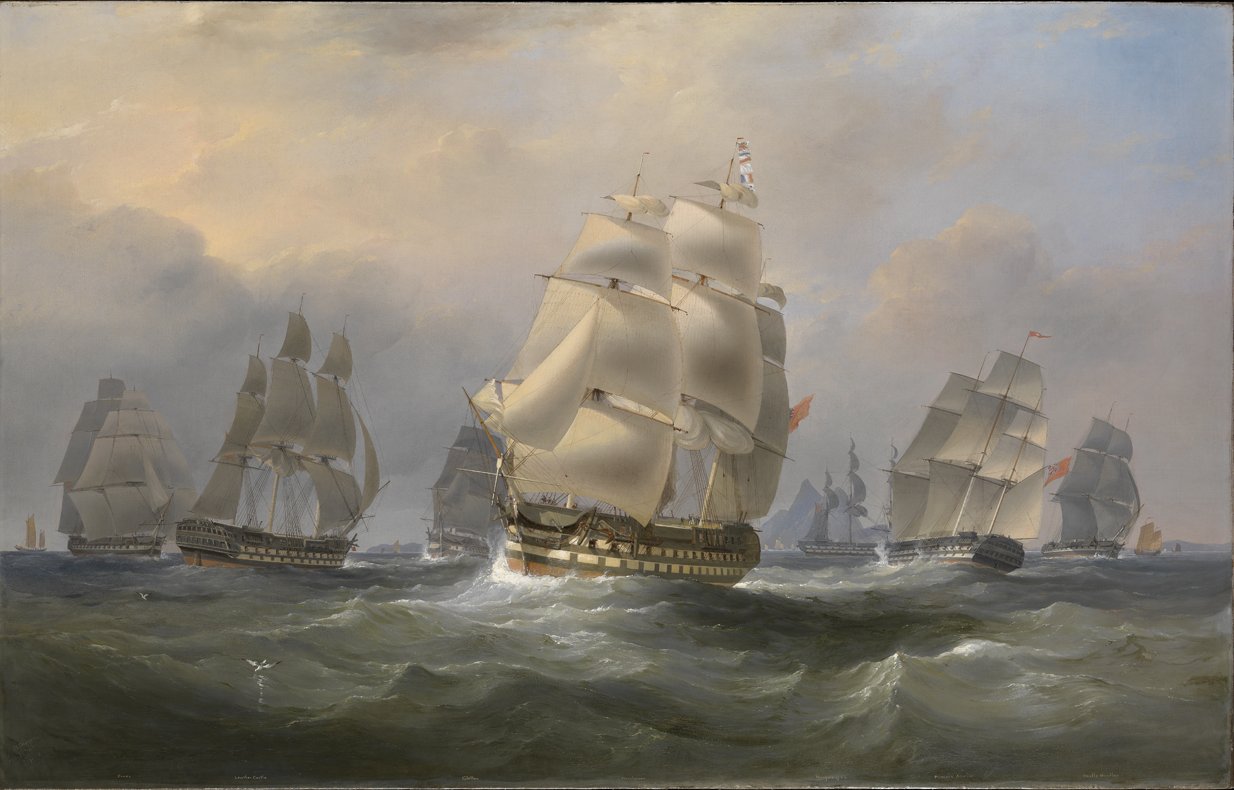
The Winchelsea in the foreground
(http://collections.rmg.co.uk/collections/objects/12649.html)
|
True Briton: voyage 1804-1805; Georgiana: voyage 1803-1807; Ganges: voyage 1805-1807; Lady Jane Dundas: voyage 1805-1807. |
|
|
| Windham (2) |
HEICS |
Built by Perry, Wells & Green at Greenwich, launched 1800, 146ft, 823 tons. She made six voyages to the Far East On her second, commanded by Captain Thomas Graham, she was noted in the journal of the Wexford as at Madras and setting sail for Bengal on 4th August 1803. She also noted in the log of the Georgiana as arriving in convoy at St Helena from the Far East on 28th June 1804. She departed for England in convoy on 13th August 1804. On her third voyage, commanded by Captain John Stewart, Captain Farrer of the Cumberland noted her in the Indian Ocean on Tuesday 3rd June 1806. In 1818 she was sold to the Chilean Navy who sold her in 1828. See https://en.wikipedia.org/wiki/Windham_(ship). She was captured twice by the French but regained by the British. She was sold to the Chilean Navy in 1818 under the name Lautaro. She took part in several engagements with the Spanish and in 1824 she a training ship. She was sold in 1828, converted into a pontoon and broken up the following year, see Wikipedia for her history.
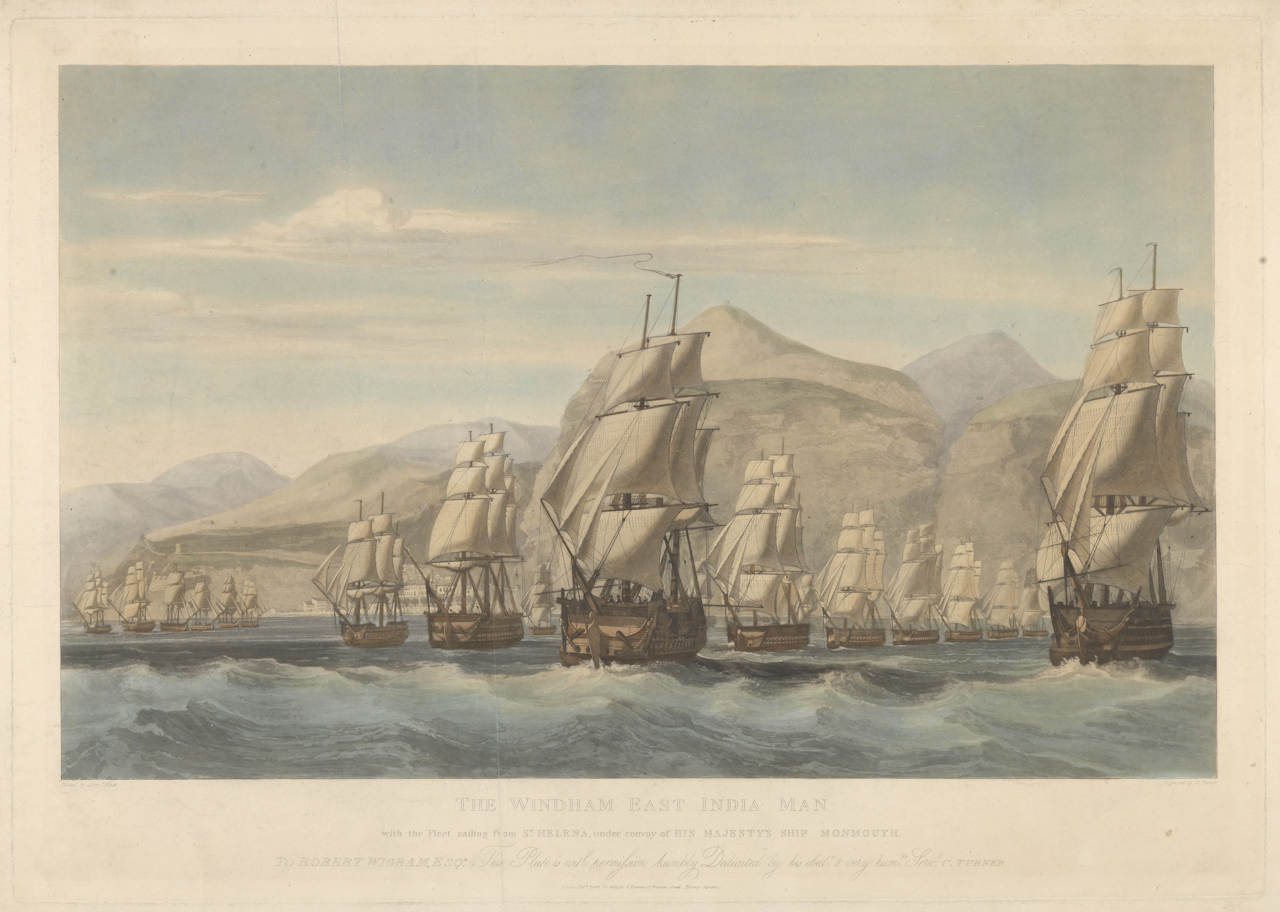
The Windham and east India Fleet at St Helena.
taken from http://collections.rmg.co.uk/collections/objects/148401.html.
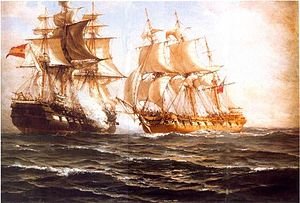
The Lautaro, taken from Wikipedia.
|
Wexford: voyage 1803-1804; Georgiana: voyage 1803-1807; Cumberland: voyage 1805-1806. |
|
|
| Windsor (2) |
HEICS |
Built by Barnard 1818, 166ft long, 1332 tons. Sailed to China at least seven times. Noted by Captain Rawes of the Warren Hastings on his between Singapore and Whampoa on 1st October 1819, under Captain John Robinson Francklin. Noted again by Captain Rawes on her fourth voyage under Captain Thomas Haviside. On Tuesday August 30th Captain Haviside, Mr Edmeads 1st Officer & the Carpenter of the Hon’ble Comp’ys Ship Windsor, came on board with Mr Wright Master Attendant came on board the Warren Hastings & held a survey on the beams in the main Hold when it was decided nothing could be done towards repairing the beams till the heel of the stanchions were clear, the beams abaft having also fallen. Mr. Haviside was an experienced Officer and had been at sea since 1804 and a captain since 1815. Noted by Captain Dalrymple of the Vansittart, under Captain Ambrose Frederick Proctor. Also noted in the journal of the Bridgewater as at Whampoa on 24th October 1829. |
Warren Hastings: voyage 1819-1820; Warren Hastings: voyage 1825-1826; Vansittart: voyage 1826-1828; Bridgewater: voyage 1828-1830. |
|
|
| Wolf |
Royal Navy |
Sloop, launched 1826, armament 18, 454 tons. Sailed to the Far East in 1830. She was noted in the Bay of Bengal on 18th Aug 1931. A hulk and coal depot from 1848. See a history of her on the website https://sites.rootsweb.com/~pbtyc/18-1900/C/01156.html. She was disposed of in 1878. |
Repulse: voyage 1831-1832. |
|
|
| Woodford hoy |
HEICS |
A hoy recorded by Captain Barker of the Northampton on Wednesday 30th March 1803 while unloading at Long Reach. Noted in the log of the Georgiana as arriving at Gravesend on Friday 29th July 1803. Also recorded in the journal of the True Briton at Blackwall on Saturday 11th February 1804 and at Blackwall on Tuesday 29th October 1805. |
Northampton: voyage 1801-1803; Georgiana: voyage 1803-1807; True Briton: voyage 1804-1805. |
|
|
| Woodford |
HEICS |
Built by Perry, launched 1790, length 163ft 1206 tons. She made eight voyages to the East, Commanded by Captain James Martin. Recorded by the Wexford on 22nd January 1804. Noted in the log of the Georgiana as at St Helena on 17th November 1804 and sailed on 7th December 1804. Captain Farrer of the Cumberland recorded that on Friday 26th September 1806 as near to Whampoa. Captain Farrer recorded that on Friday 26th September 1806 the he moored alongside the Woodford at the upper moorings at Blackwall. Farrington records that she had returned from China in Feb 1805 while her next voyage did not commence until January 1807. Either she was moored at Blackwall for this time or was involved in private business. She was sold for breaking in 1812.
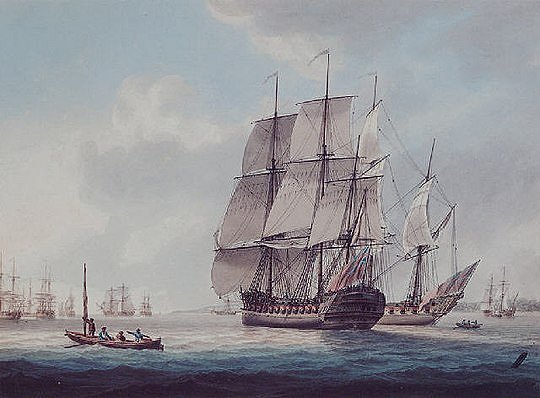
The Woodford near Plymouth by Samuel Atkins
https://en.wikipedia.org/wiki/Woodford_(1790_EIC_ship). |
Wexford: voyage 1803-1804; Cumberland: voyage 1805-1806; Georgiana: voyage 1803-1807. |
|
|
| Woolwich |
Royal Navy |
An Adventure-class frigate launched in 1794, length 113ft 906 tons. She was, along with, HMS Porpoise, at Cape Town and noted in the log of the Georgiana on 15th May 1806. She noted again in the log as arriving at the Cape as an escort of a number of merchantmen on 30th December 1806. She was referred to again on the 26th January 1807 while the Georgiana was at St Helena. She sailed for England on 28th January 1807. She was lost off the coast of Barbuda on 11th September 1813. See Wikipedia.
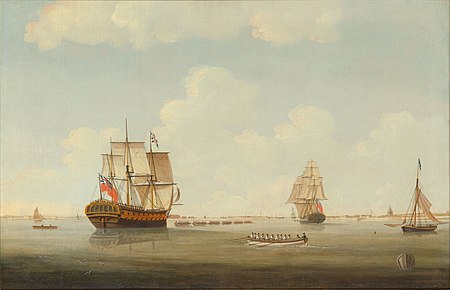
The Woolwich under tow in Portsmouth Harbour
by Thomas Elliott 1795 - from Wikipedia. |
Georgiana: voyage 1803-1807 |
|
|
| Worcester |
HEICS |
Built by Perry, launched 1785. Length 143ft, 798 tons. Noted in the log of the Georgiana as arriving at St Helena from Bengal on 29th August 1805, her commander was Captain Searles Wood. She sailed for England 4th November 1805. Noted by Captain Sanders of the Northampton at Madras on Wednesday February 17th 1808. Noted by Captain Bayliff of the Huddart, by Captain Jones of the Earl St Vincent, by Captain Lindsay of the Lady Jane Dundas. In June 1807 she was described as a store ship at St Helena This was her eighth and last and her commander was Captain Searles Wood.
|
Georgiana: voyage 1803-1807; Lady Jane Dundas: voyage 1805-1807; Earl St Vincent: voyage 1806-1807; Northampton: voyage 1807-1809; Huddart: voyage 1806-1807. |
|
|
| Worsley |
HEICS |
Noted by Captain Rawes of the Warren Hastings in the South China sea on 23rd September 1815 along with several East India Company vessels. Cannot trace. |
Warren Hastings: voyage 1815-1816. |
|
|
|
X |
|
Y |
|
Z |
| Zephey |
HEICS |
Noted in the log of the Georgiana as a transport sailing from Simons Bay on 10th July 1806. It is not clear which ship this is - see Wikipedia. |
Georgiana: voyage 1803-1807. |
|
|
| END |



















































































